

Our next day in Hawaii would be spent closer to our hotel in the area surrounding Waikiki Beach. This is one of the world's most famous tourist beaches and no visit to Oahu is complete without spending at least some time in Waikiki to take in the sights and sounds. I would also explore Diamond Head this morning, the main geographical feature overlooking the beach area. Diamond Head is an extinct volcano and it forms the background giving Waikiki Beach its unique appearance captured in a million souvenir postcards. We planned to relax this day on the beach and cap things off with an evening cruise on an offshore catamaran out in Waikiki Bay. Fortunately it would turn out to be another beautiful sunny day as is typical for summertime in Hawaii.
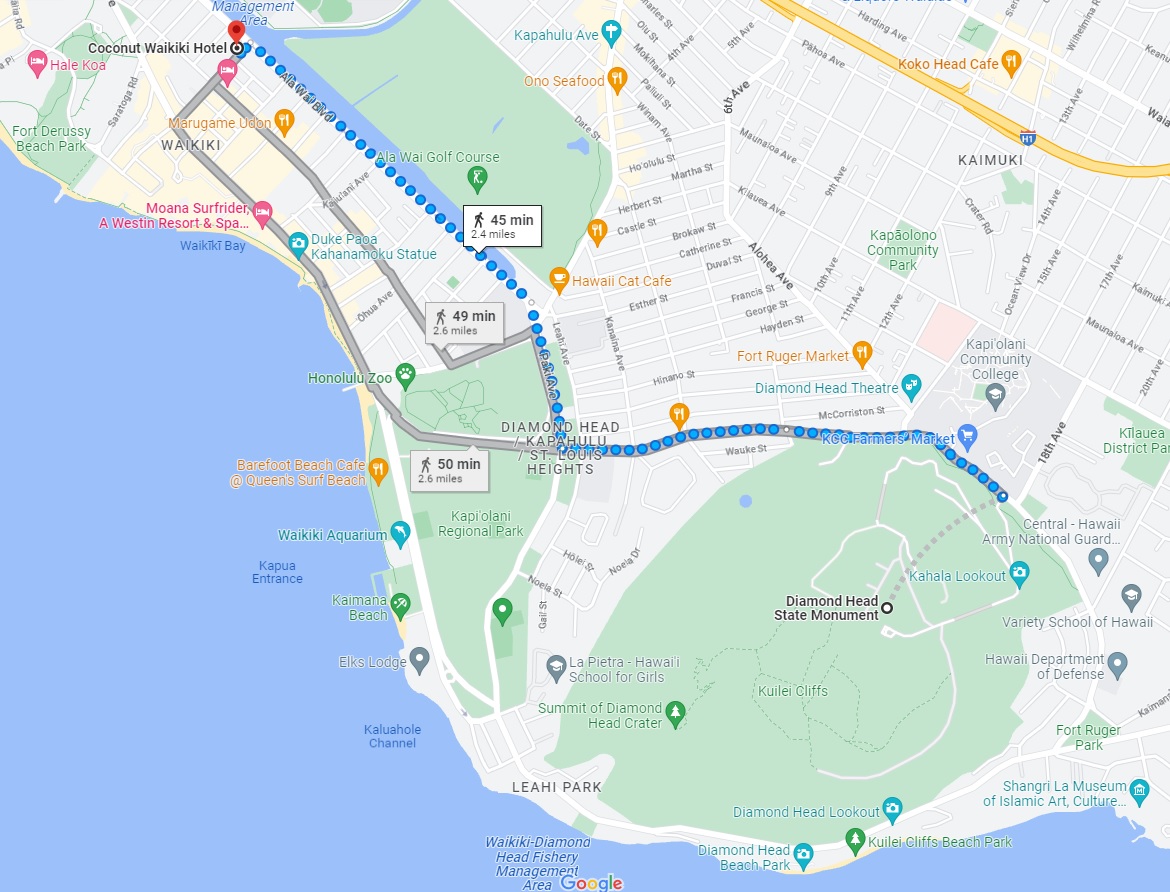
This day began at an early hour, at least for me if not for Liz. I planned to visit Diamond Head early in the morning and had previously reserved an entry to Diamond Head State Monument right when it opened at 6:00 AM. (Visitors to Hawaii should be aware that they need to reserve tickets to visit Diamond Head in advance, at this time of writing they could be booked two weeks ahead of time online.) Liz was pregnant with our son at the time and couldn't hike to the top of Diamond Head, which meant that I wanted to get over there as early as possible and finish up quickly so that we could enjoy the rest of the day together. For the moment we didn't have a rental car which meant walking from our hotel over to Diamond Head itself, a walk of about 3 miles / 5 kilometers in each direction. This was too early to catch the buses that run in Honolulu and I didn't want to try to book a ride share at such an odd hour. Thus it would be a walking jaunt which is never something that's bothered me anyway.
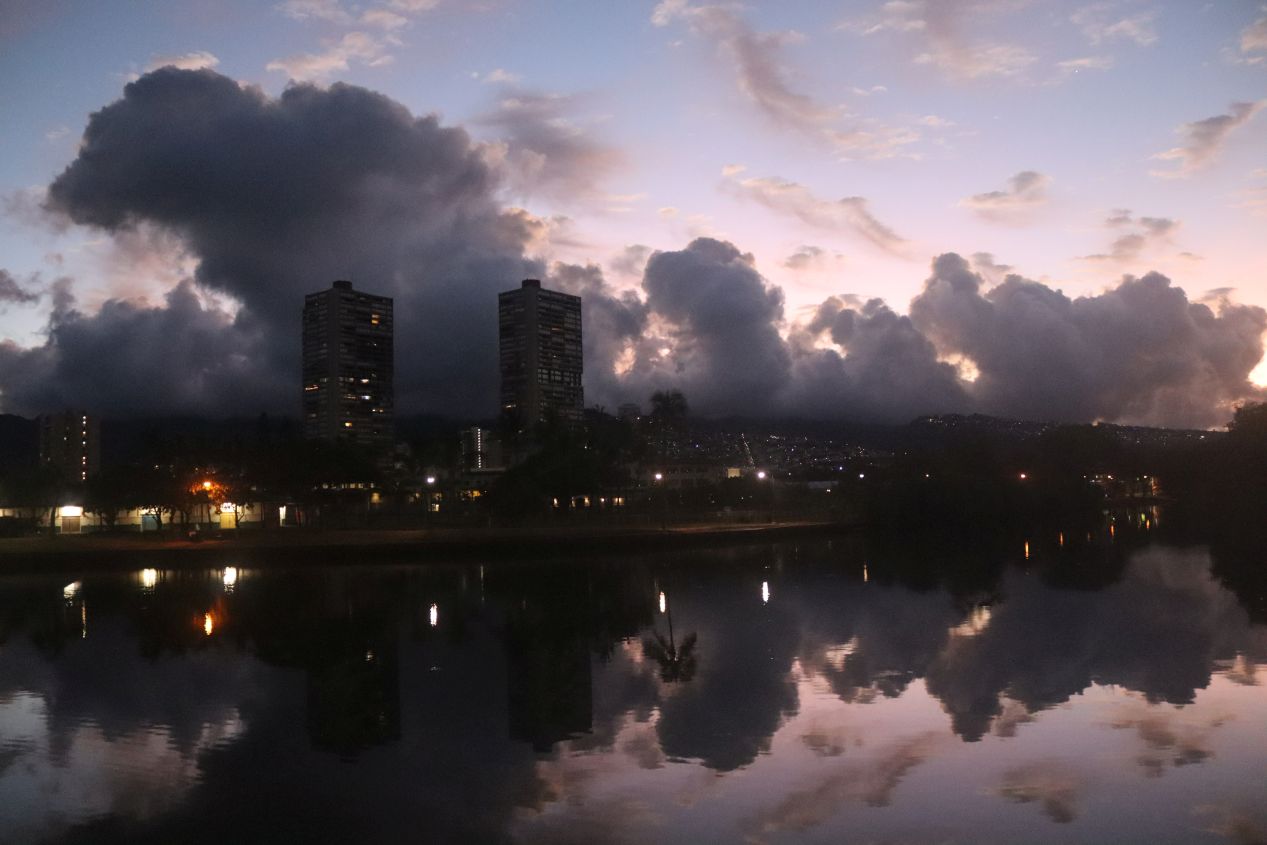
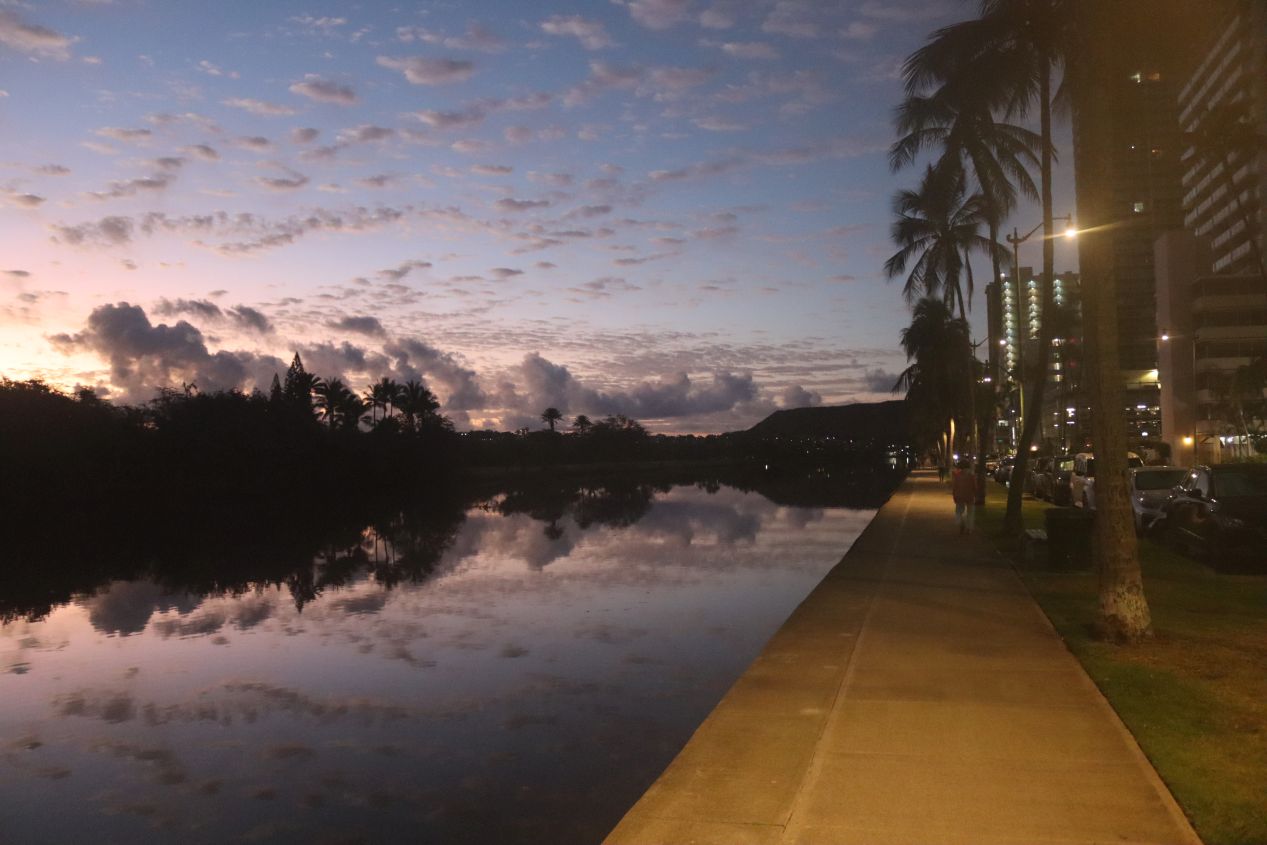
My walk over to Diamond Head began at 5:00 AM as I figured it would take just about an hour to get over to the park entrance. Getting up at such an early hour would normally have been miserable, however we were still adjusting to traveling across six time zones and we'd been waking up before sunrise even without setting an alarm. It took me about two days to adjust fully while unfortunately it took Liz more like a full week. Anyway, my walking path took me along the Ala Wai canal which was built back in the 1920s and 1930s to help drain the wetlands surrounding Waikiki and keep down the local mosquitos. I thought that I would have the walking path next to the canal all to myself and was surprised to find quite a few people sharing the sidewalk with me. It was a mixture of locals exercising before heading off to work, other tourists who were also adjusting to the time zone shifts, and some of Honolulu's homeless population who found this area a good place to spend the night. I exchanged a series of "good mornings" with other people out for a stroll while continuing to head eastwards where I could see the bulk of Diamond Head rearing up in the distance.
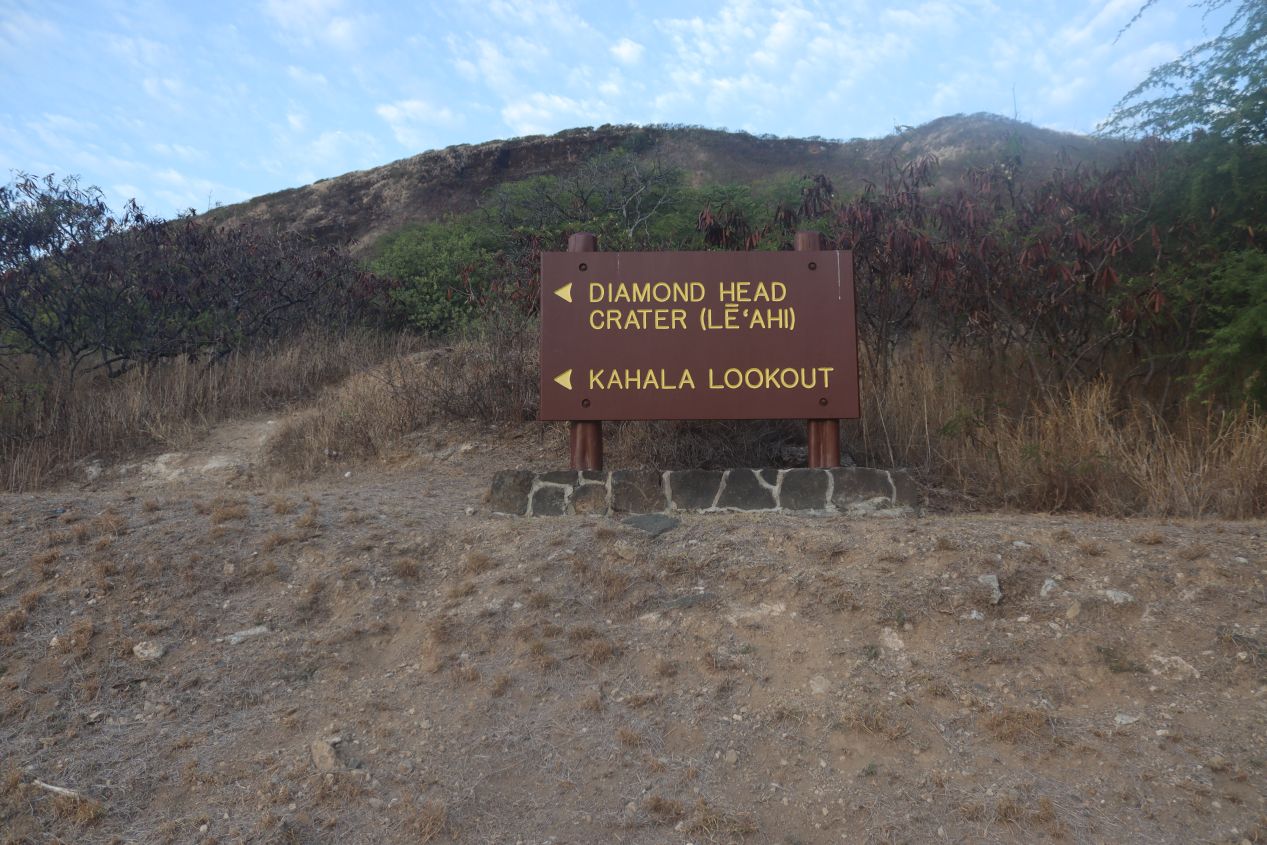
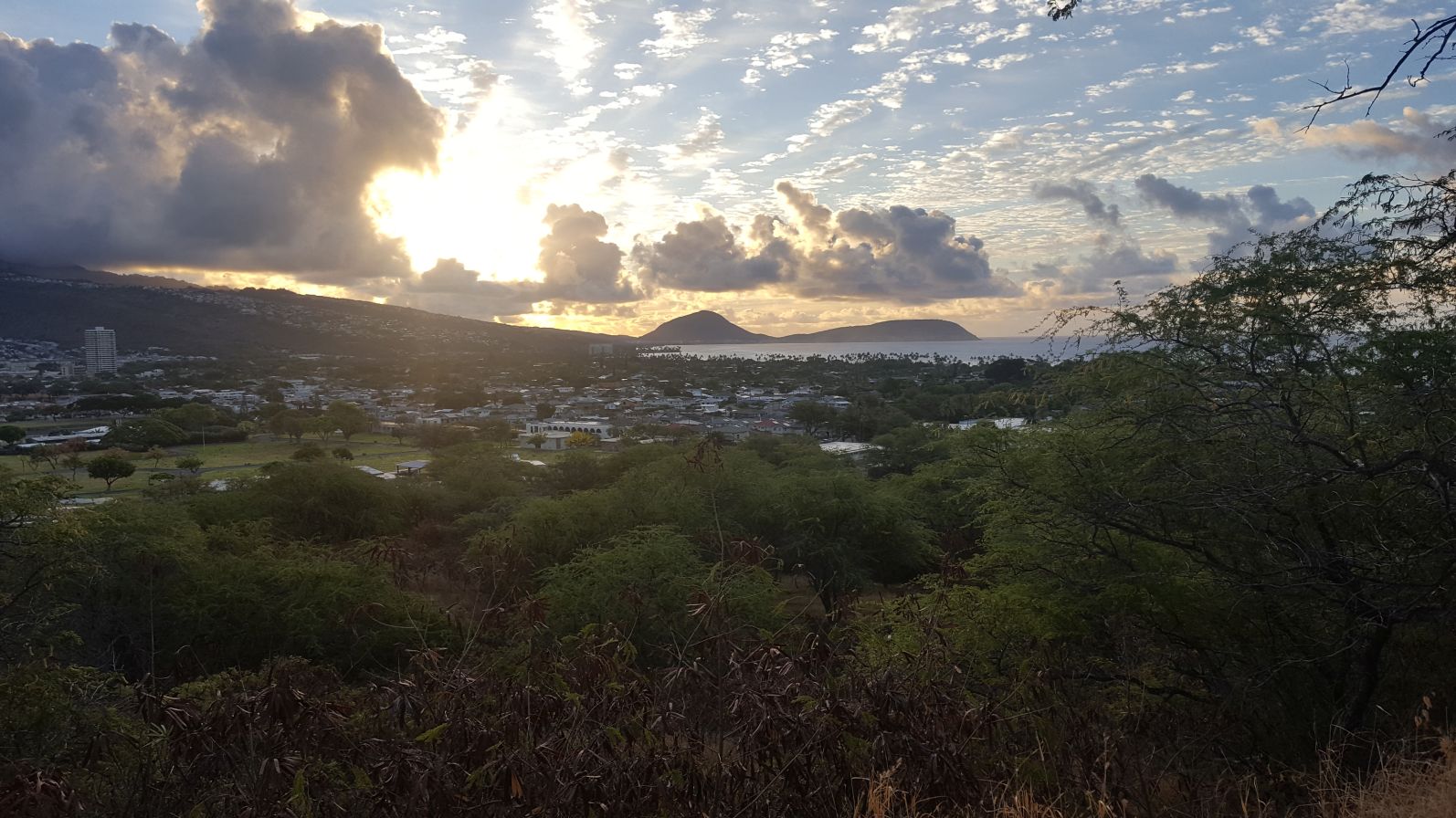
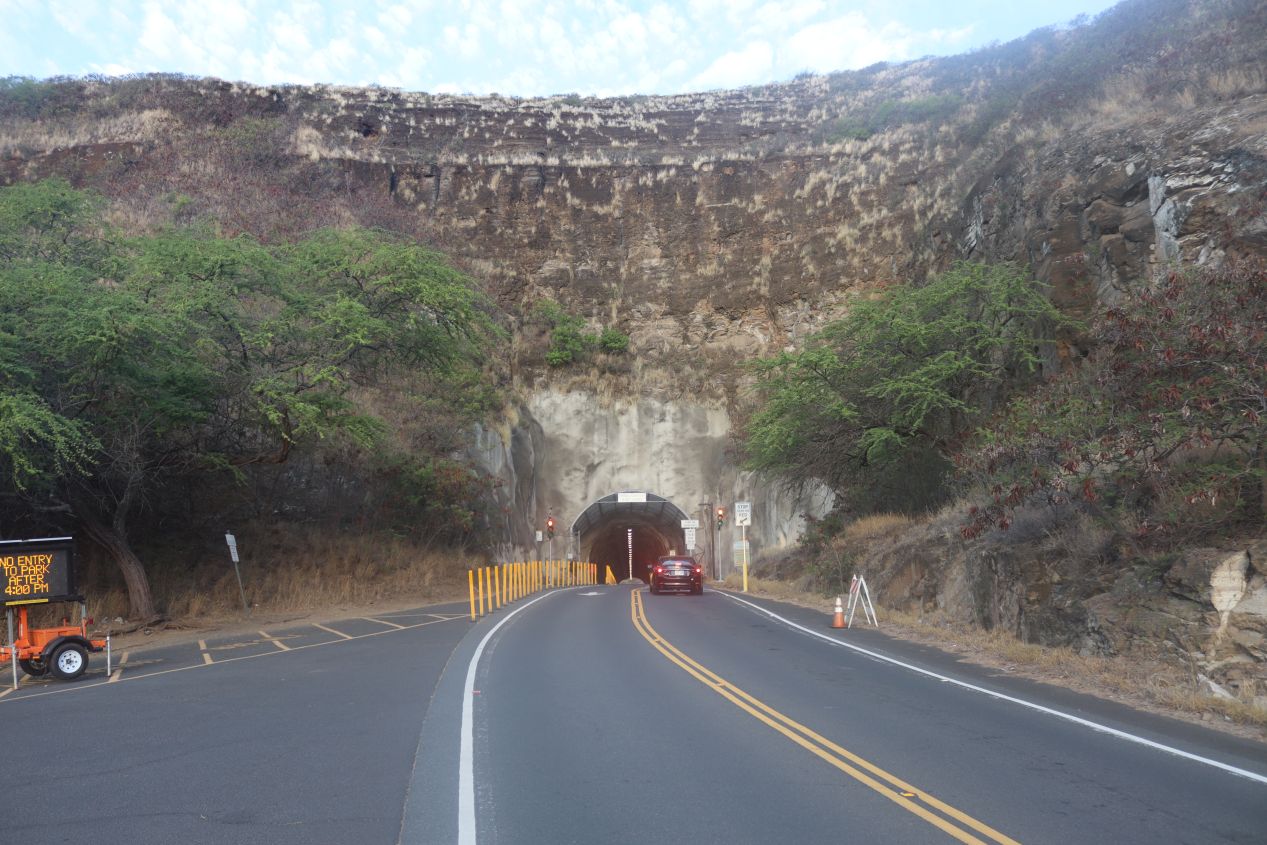
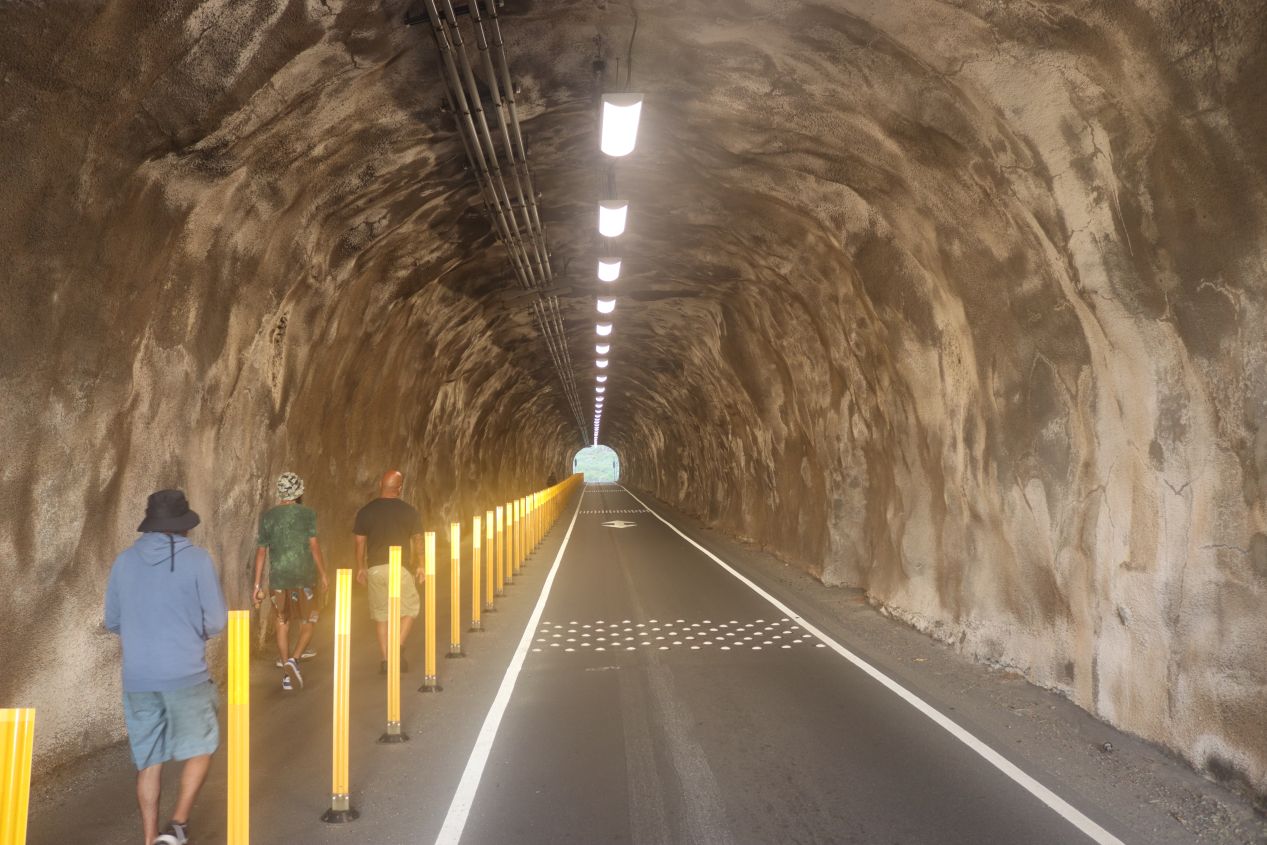
After about 20 minutes of walking, I turned to the left as the road that I was following began curving around Diamond Head itself. The only entry to Diamond Head is located on the northern side of the old volcanic crater, on the opposite side away from the beach where steep slopes run down to the water's edge. The sun was just cresting the horizon as I approached Diamond Head and I was able to snap some lovely pictures of the eastern suburbs of Honolulu as they ran off towards the ocean. The actual entrance to Diamond Head was a road that passed through a tunnel, making for a distinctive way of passing into the state monument. There were a number of other tourists who had also arrived for the 6:00 AM entry time and I joined the flow of arrivals as we headed into the center of the crater.
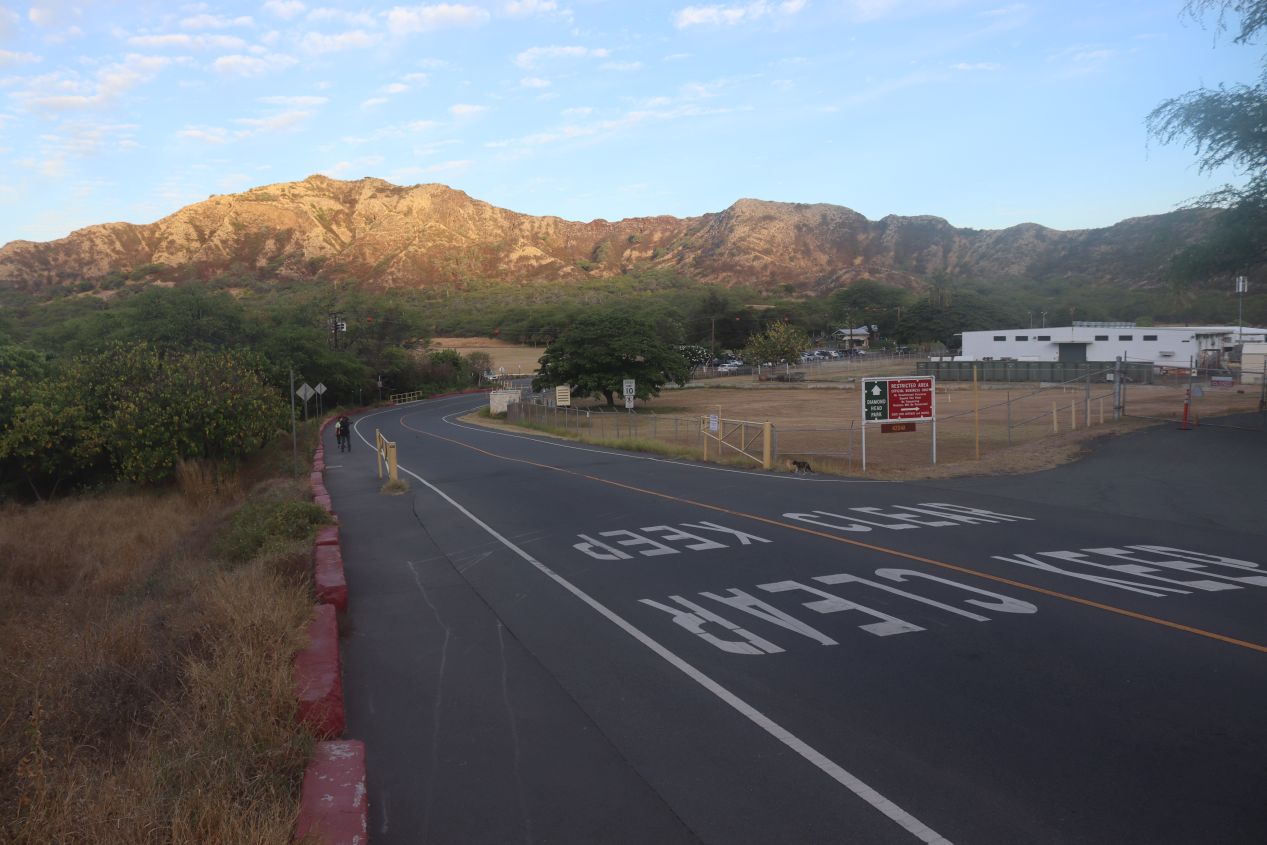
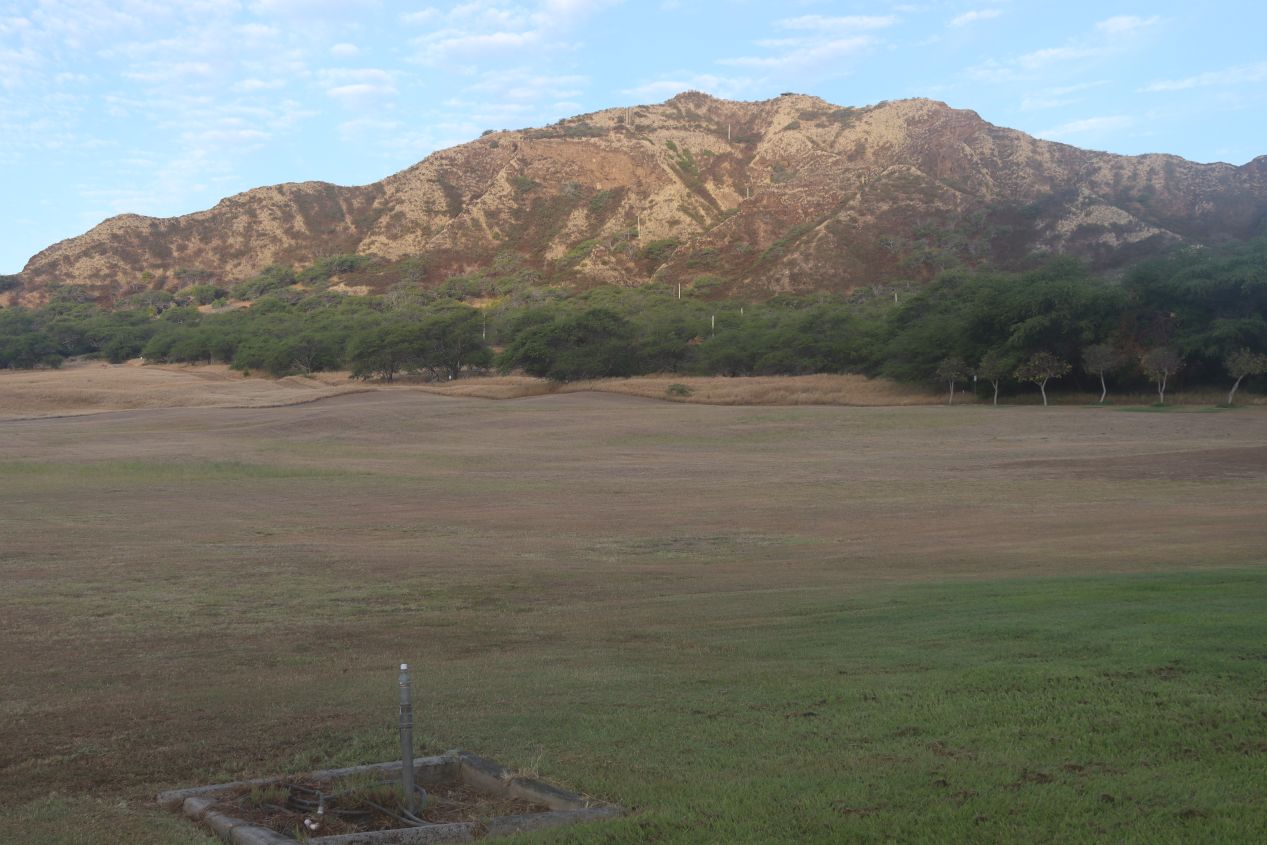
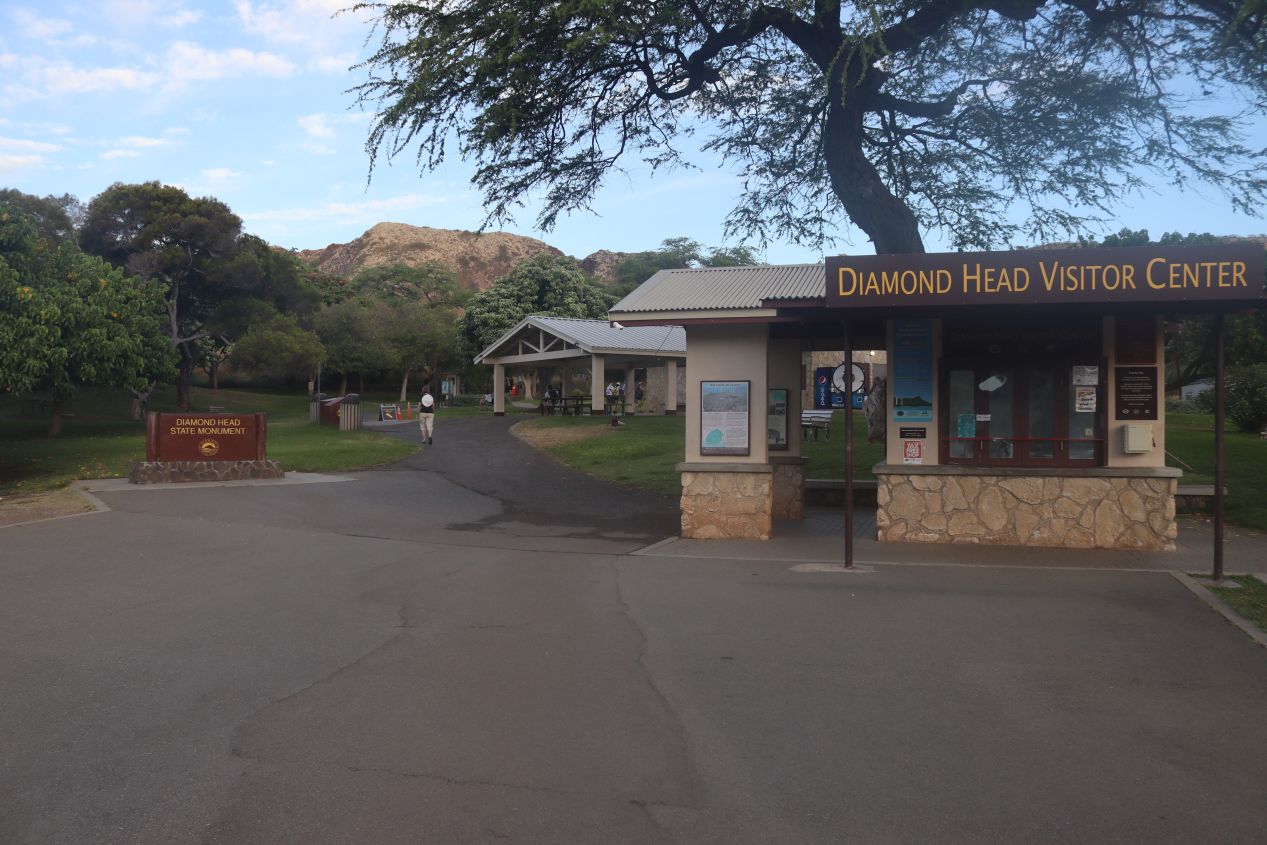
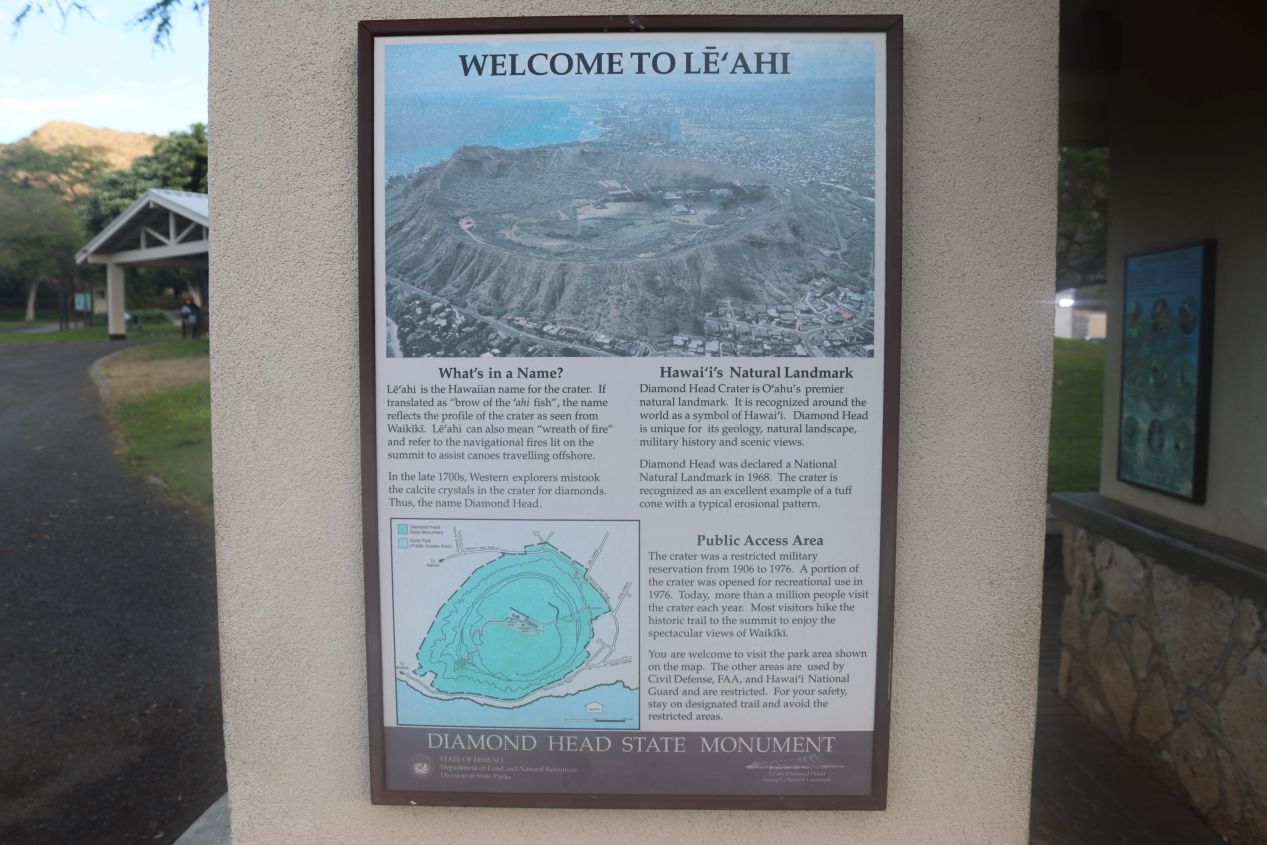
The landscape immediately opened up into a shallow bowl upon exiting the tunnel, with grasslands running to the steep walls that surrounded this sheltered area on all sides. Here on the inside it was impossible to avoid seeing how Diamond Head had once been a volcanic crater when it formed about 500,000 years ago, fortunately one which has long since gone extinct. Since that time, Diamond Head has been used as a military base during the first half of the 20th century and then briefly was used as a venue for outdoor concerts in the 1970s before the park service had to cancel them out of environmental concerns. The English name "Diamond Head" comes from a mistake made by British sailors who discovered sparkling volcanic calcite crystals in the sand and mistook them for diamonds. The Hawaiian name is Le'ahi which is a derivation of "ahi" (tuna) and refers to the shape of the ridgeline resembleing the shape of a tuna's dorsal fin. Everyone in Hawaii seemed to be using Diamond Head to refer to the place instead of the indigenous name which is why I've stuck with that nomenclature in this writeup.
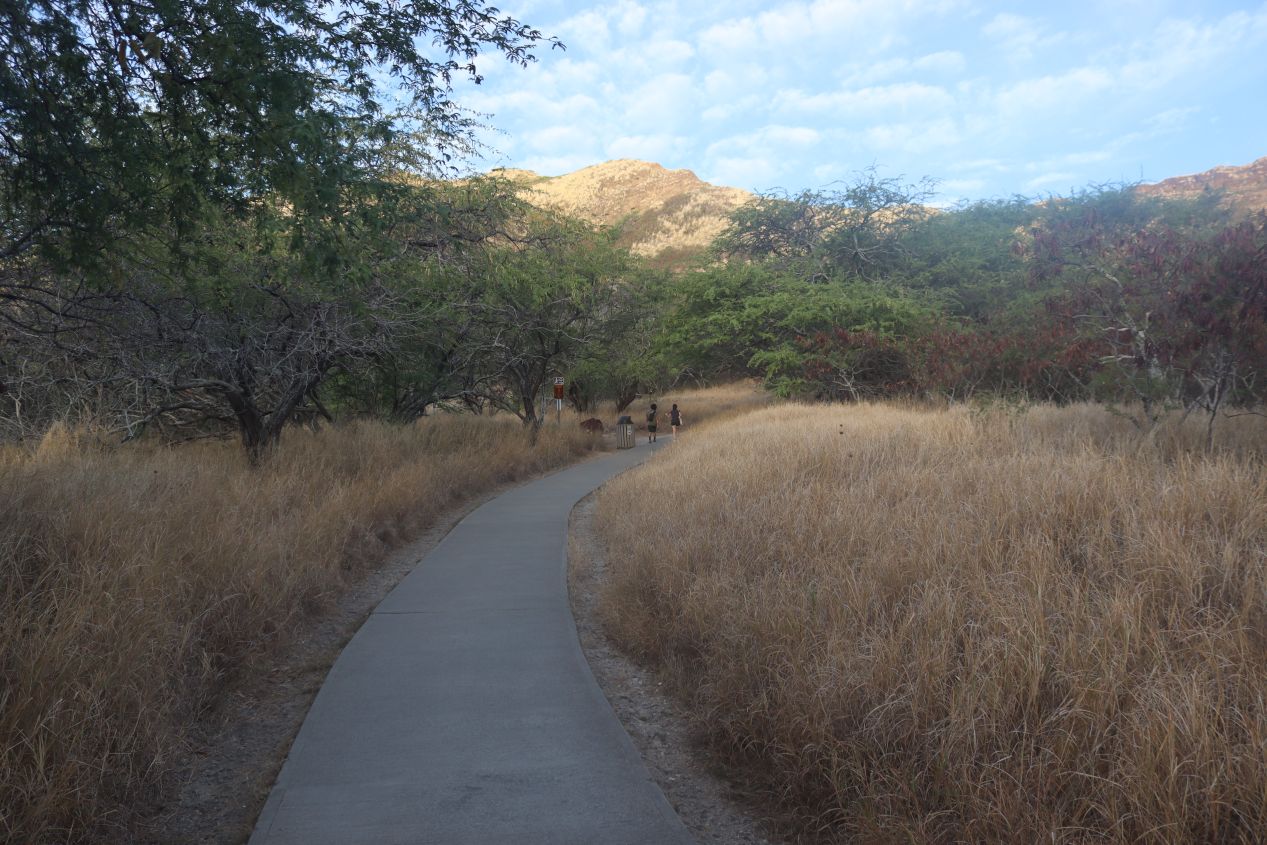
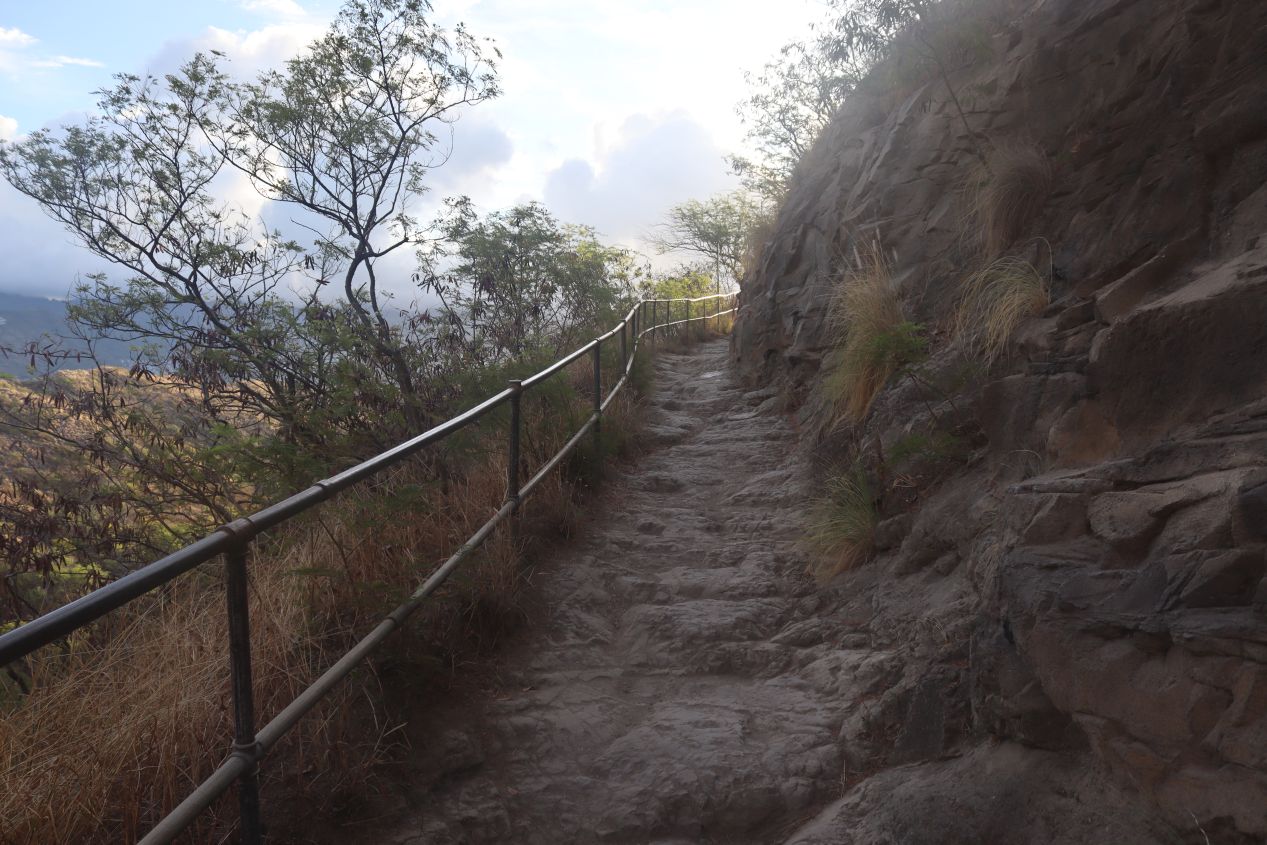
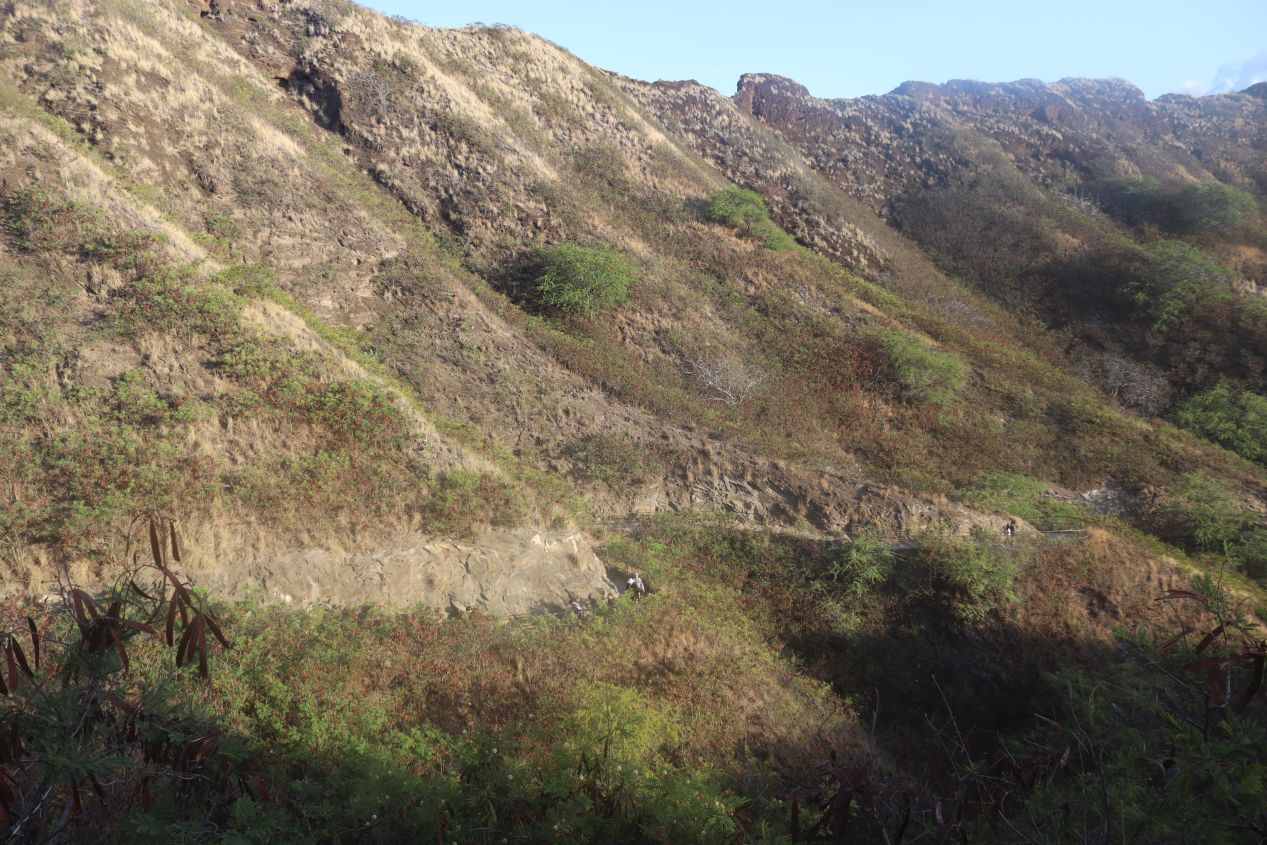
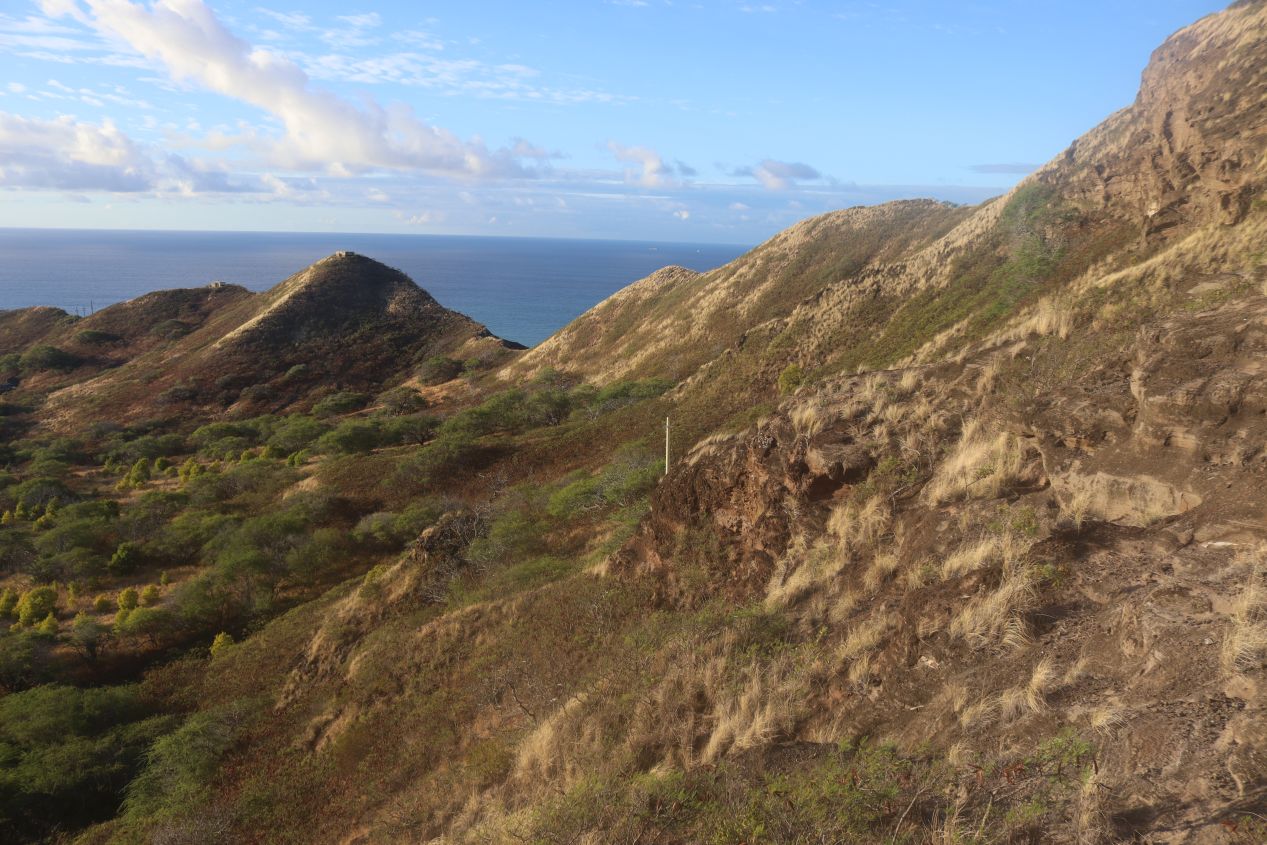
The main tourist activity at Diamond Head is the hike up to the top of the crater rim. This isn't a long walk at only about 1 mile / 1.5 kilometers in each direction and the first half of the walking path was easy to navigate along the flat interior of the crater. The second half of the trail began ascending up to the top of the crater and became harder to climb while still being far easier than many of the other hikes I'd done elsewhere. It was quite crowded even at this early morning hour and I could see why there was a limited entry ticketing system for Diamond Head: the hiking path would become unnavigable if an unlimited number of tourists were allowed to visit at the same time. This was a great time to be doing the hike, before the heat of the day could warm up too far, and the morning sunshine made for some beautiful scenery. The walls of the crater were more arid than I would have expected, lacking lush greenery and instead having more in the way of scrub brush. It turns out that the northern side of Oahu gets the bulk of the rainfall although Honolulu certainly gets more than its fair share as well.
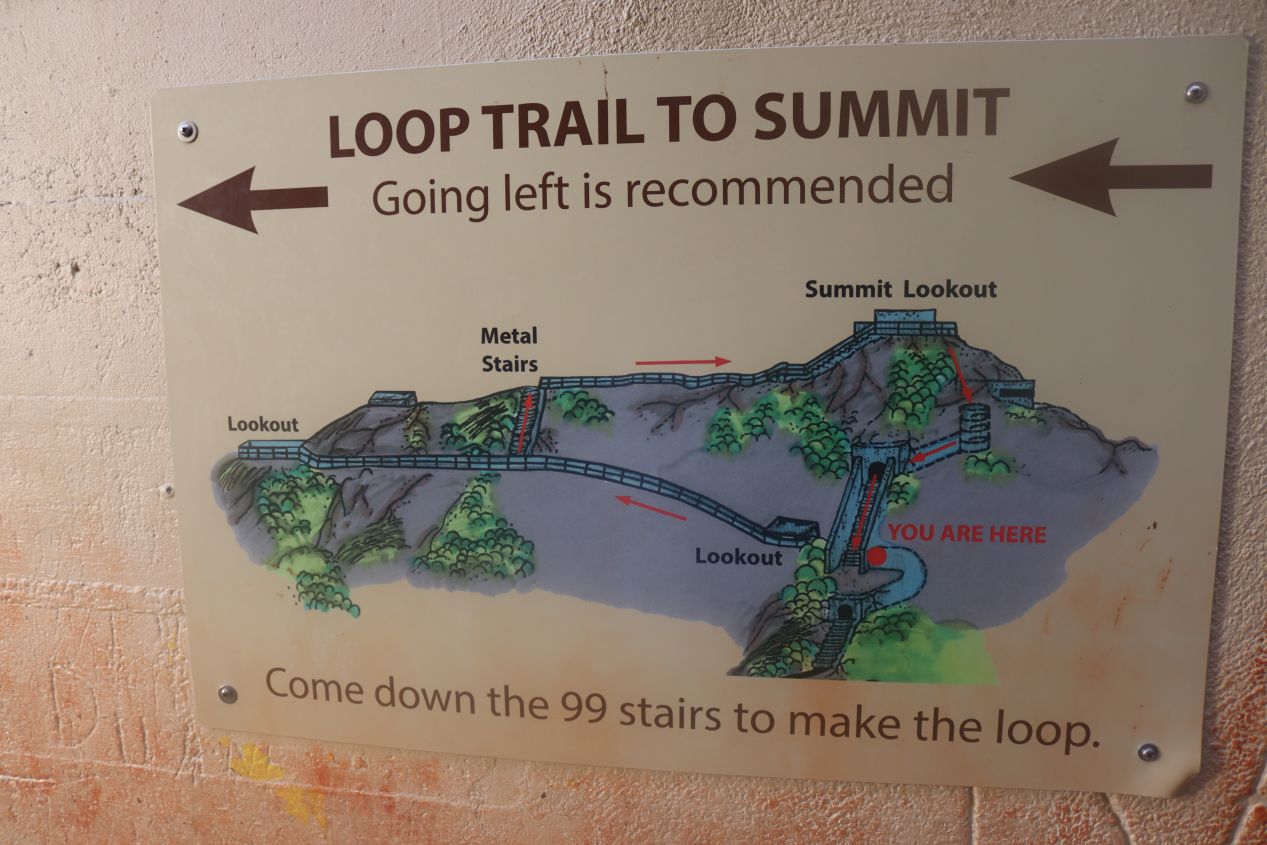
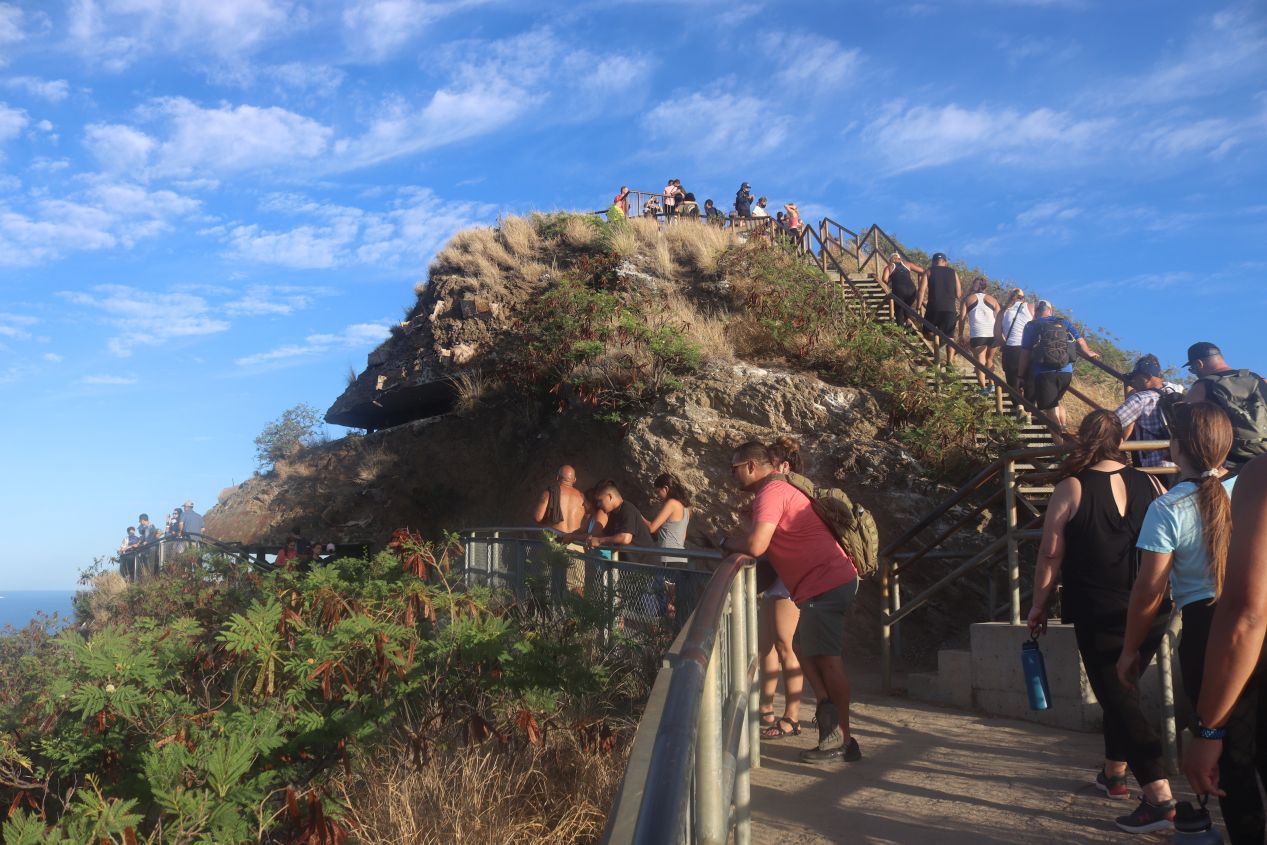
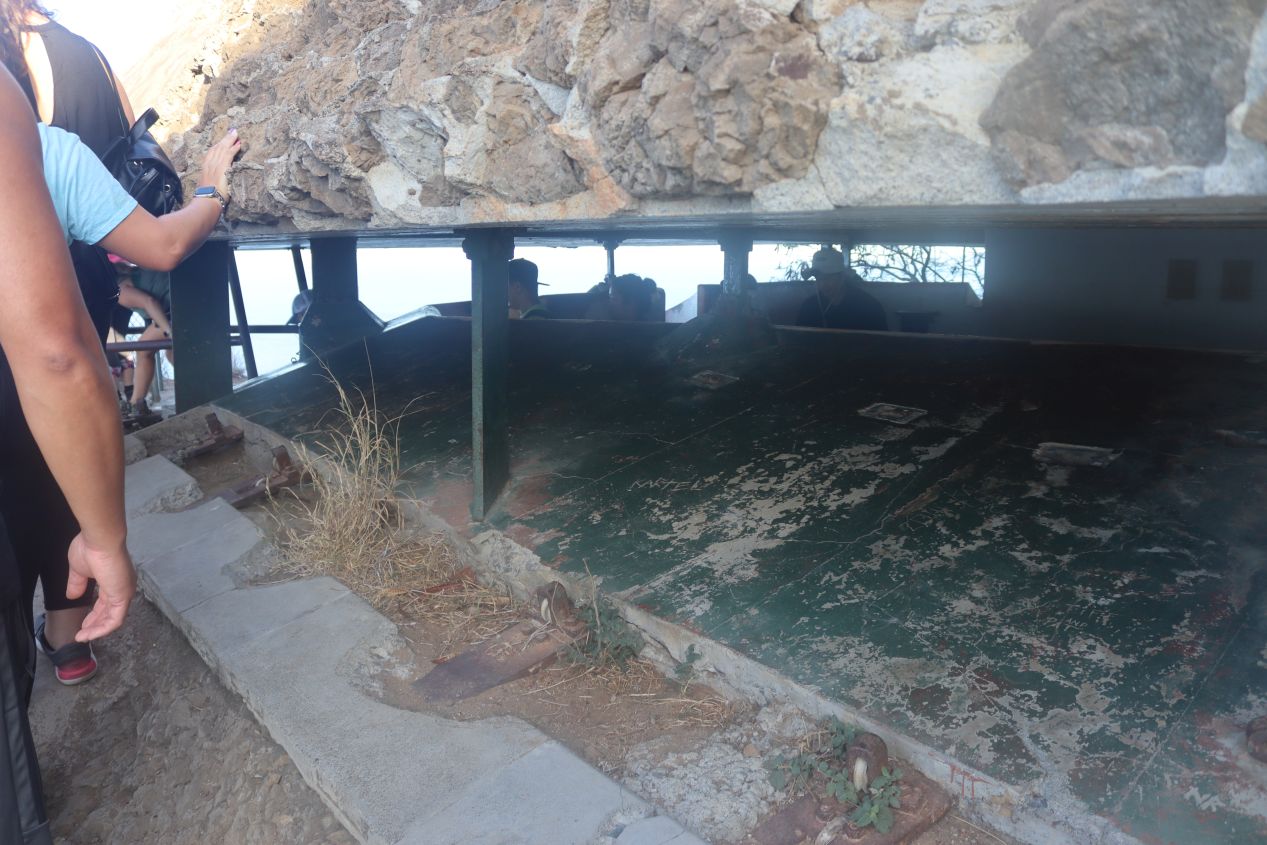
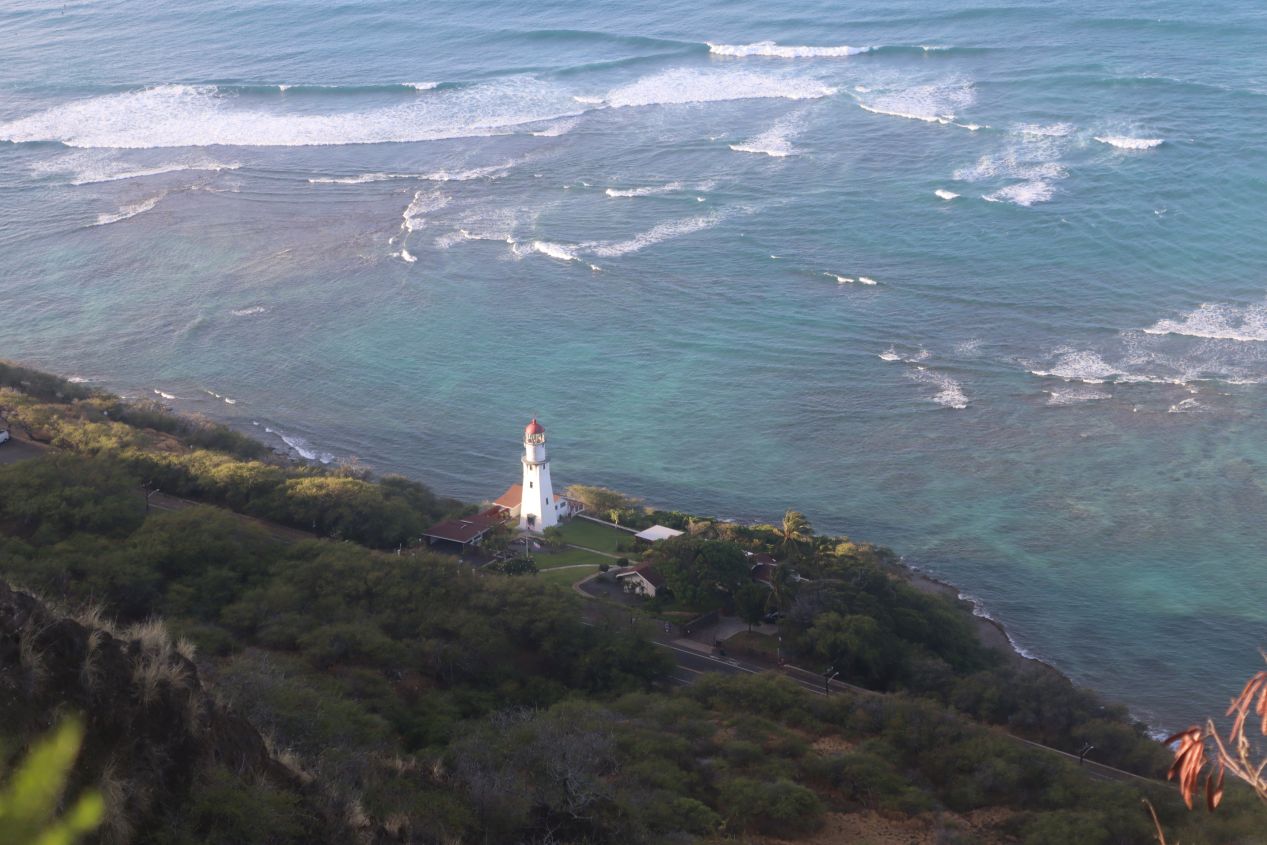
The trail ended up near the summit of Diamond Head where there was a tunnel through part of the crater wall that led to a small loop at the top. At one end of the loop was a pillbox left over from when Diamond Head was occupied by the military. Visitors could peek out through the narrow gunslits at the ocean down below at the bottom of the cliffs. Diamond Head Lighthouse was down there along with some expensive houses clinging to the narrow beachfront between the crater and the sea. A twisting metal staircase at the bottom of the pillbox led down through the rock and back out to the entrance to the loop without having much to see along the way. This was the most crowded part of Diamond Head and it was only worse at the summit lookout itself:
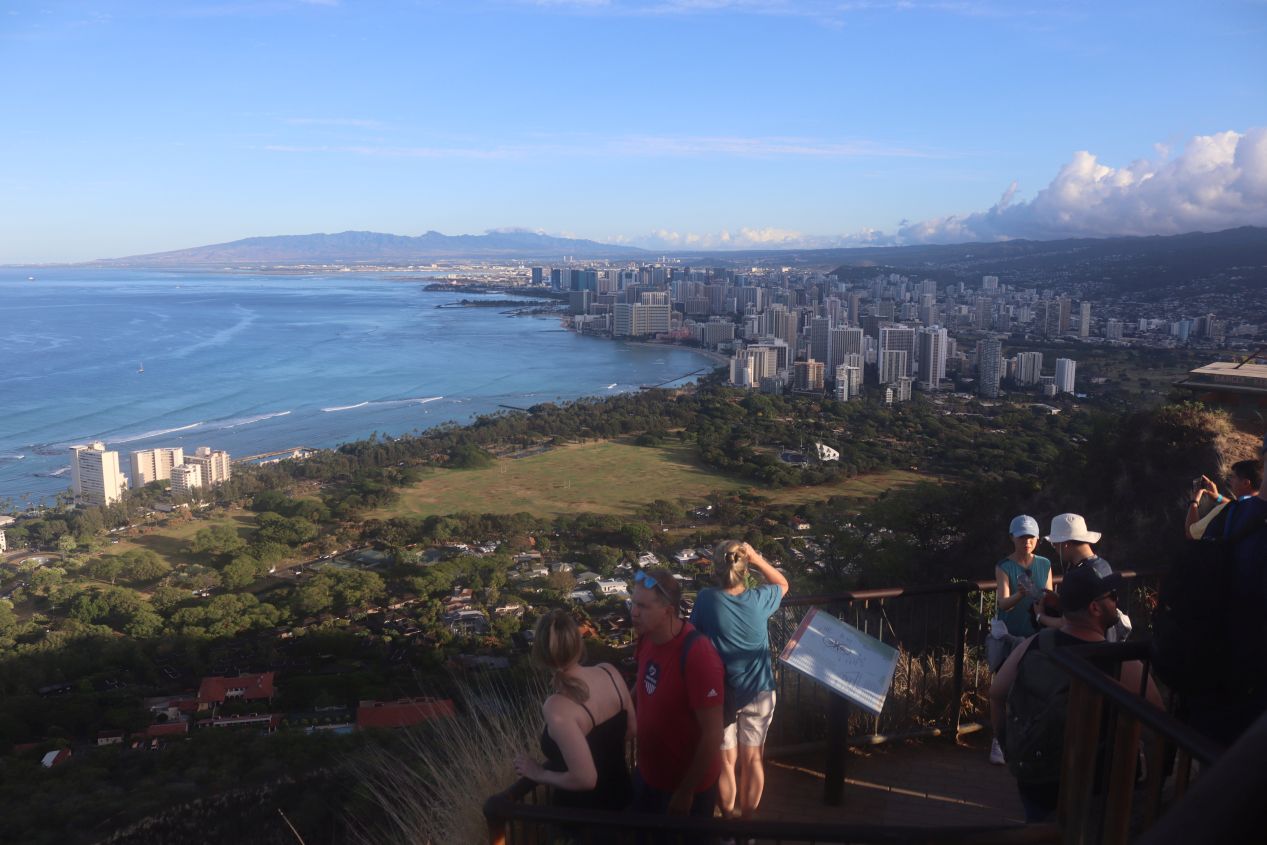
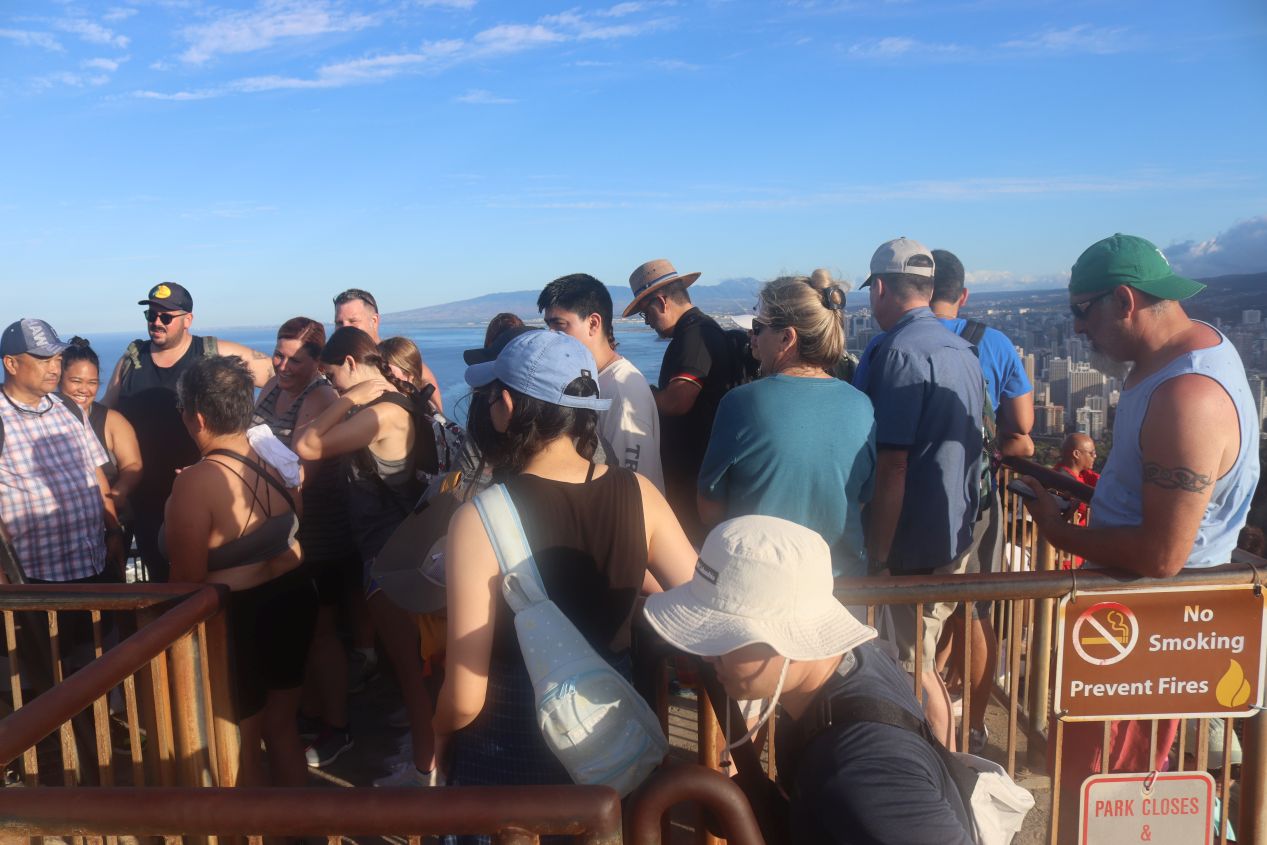
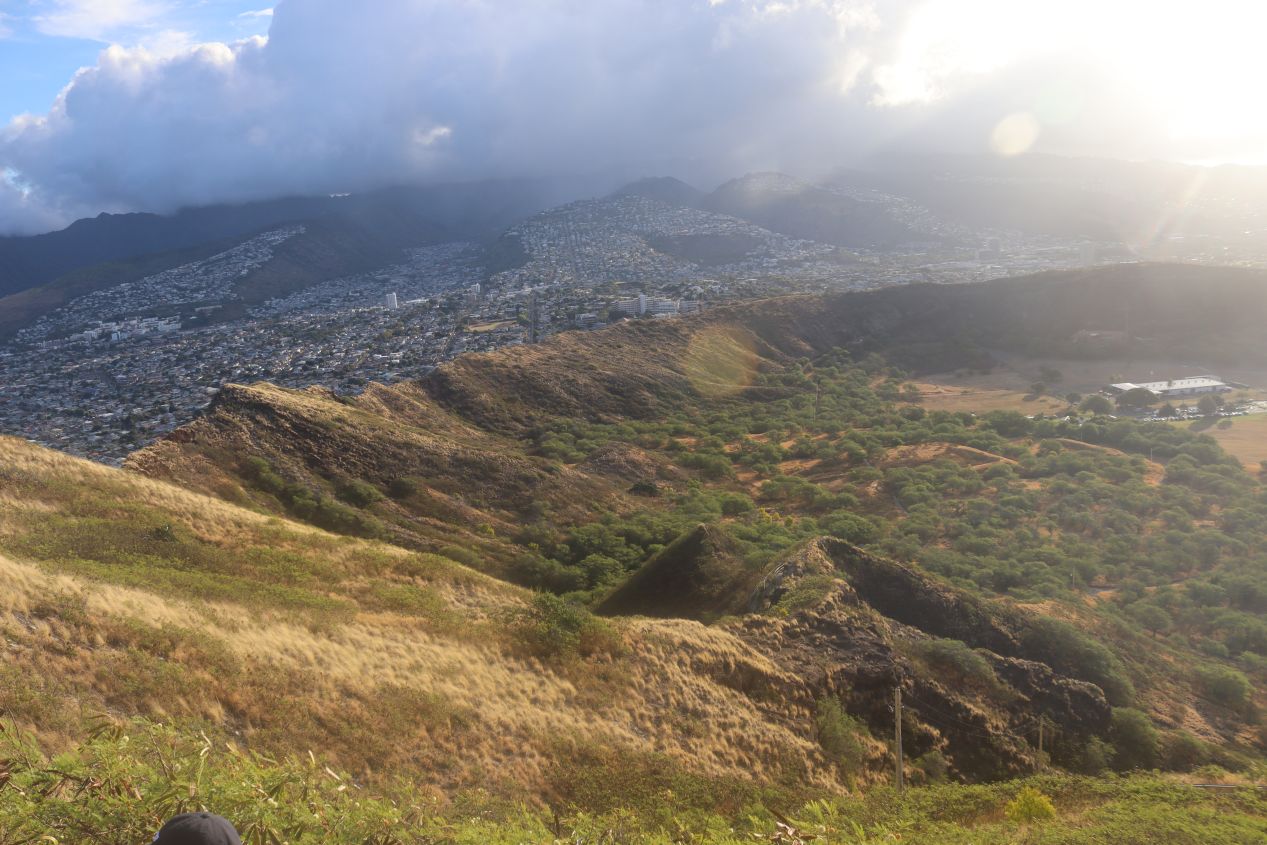
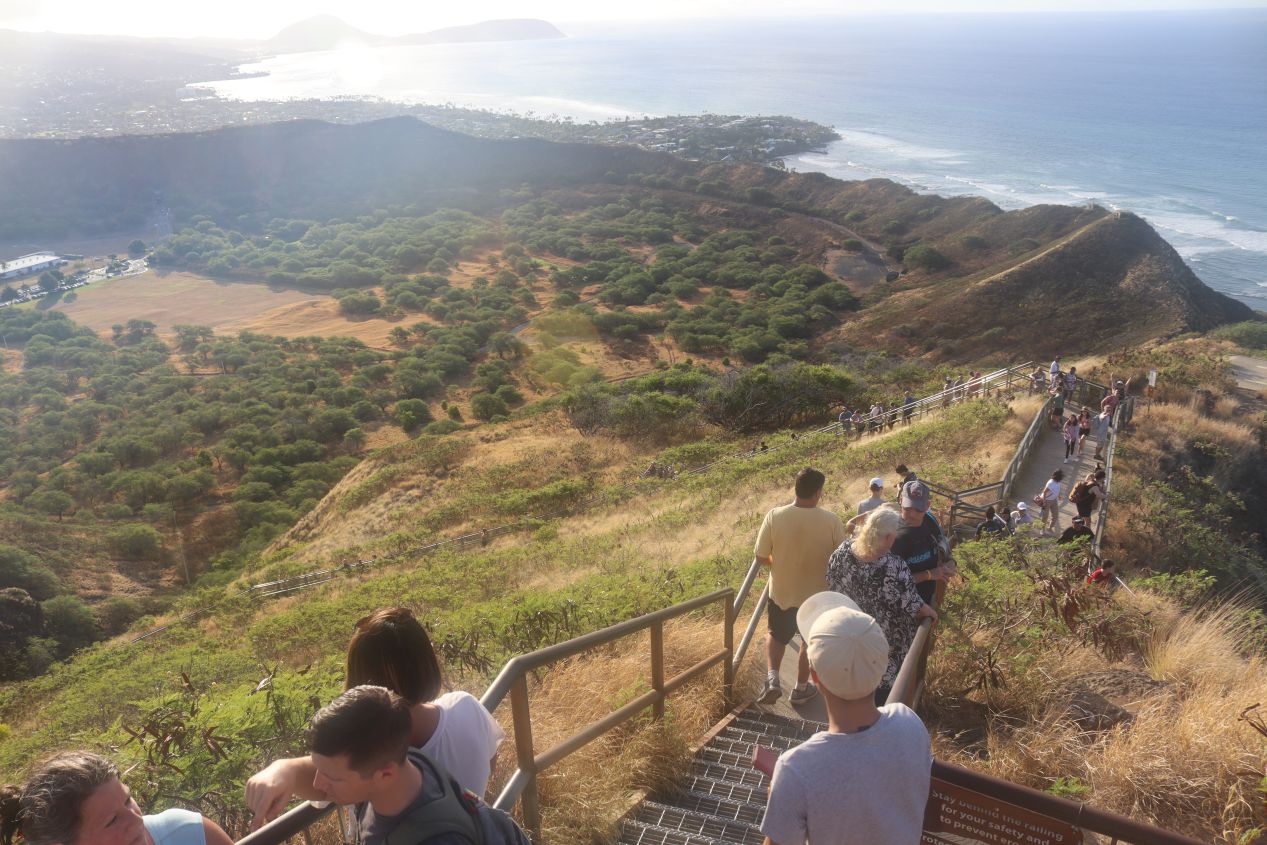
This is where some of the most famous pictures of Waikiki Beach are taken, looking down at the sweeping expanse of the beachfront from the heights atop Diamond Head. It was too bad that the summit was so crowded with people that it was almost impossible to move! I was only able to get clear shots of the landscape by using my height to full advantage and holding the camera up above my head. Even though it was a pain to have to elbow past the other tourists packing the summit, I still greatly enjoyed having the chance to take in these views. They made the early morning rise and the hike to get up here more than worth the trouble. Short of taking a helicopter trip, these were also the best views that I was going to get of Diamond Head itself which stood out like a sore thumb from the urban environment surrounding it.
I reached the summit a few minutes before 7:00 AM and I paused here briefly to line up one of our next activities. We wanted to visit another nature preserve named Haunama Bay which opened up its online tickets 48 hours ahead of time starting at 7:00 AM two days in advance. I knew that these tickets would be snapped up immediately and I had the ticketing website queued up on my phone and ready to go as soon as the clock struck the hour. I was able to sign in right at 7:00 on the dot and selected two tickets for 10:00 AM in two day's time. To my shock, in the 30 seconds that it took to select those tickets and scroll down to the reserve button, they were completely sold out!  I scrambled to select another time and managed to get the 9:25 AM slot before they were all gone as well. Everything was taken within the first five minutes of the tickets becoming available - sheesh! For future visitors to Haunama Bay, I'd suggest trying to grab one of the oddball time slots (like 9:25 AM instead of 9:30 AM) since they seemed to be taken last. I was lucky to get the two tickets that I did in preparation for an upcoming day of sightseeing.
I scrambled to select another time and managed to get the 9:25 AM slot before they were all gone as well. Everything was taken within the first five minutes of the tickets becoming available - sheesh! For future visitors to Haunama Bay, I'd suggest trying to grab one of the oddball time slots (like 9:25 AM instead of 9:30 AM) since they seemed to be taken last. I was lucky to get the two tickets that I did in preparation for an upcoming day of sightseeing.
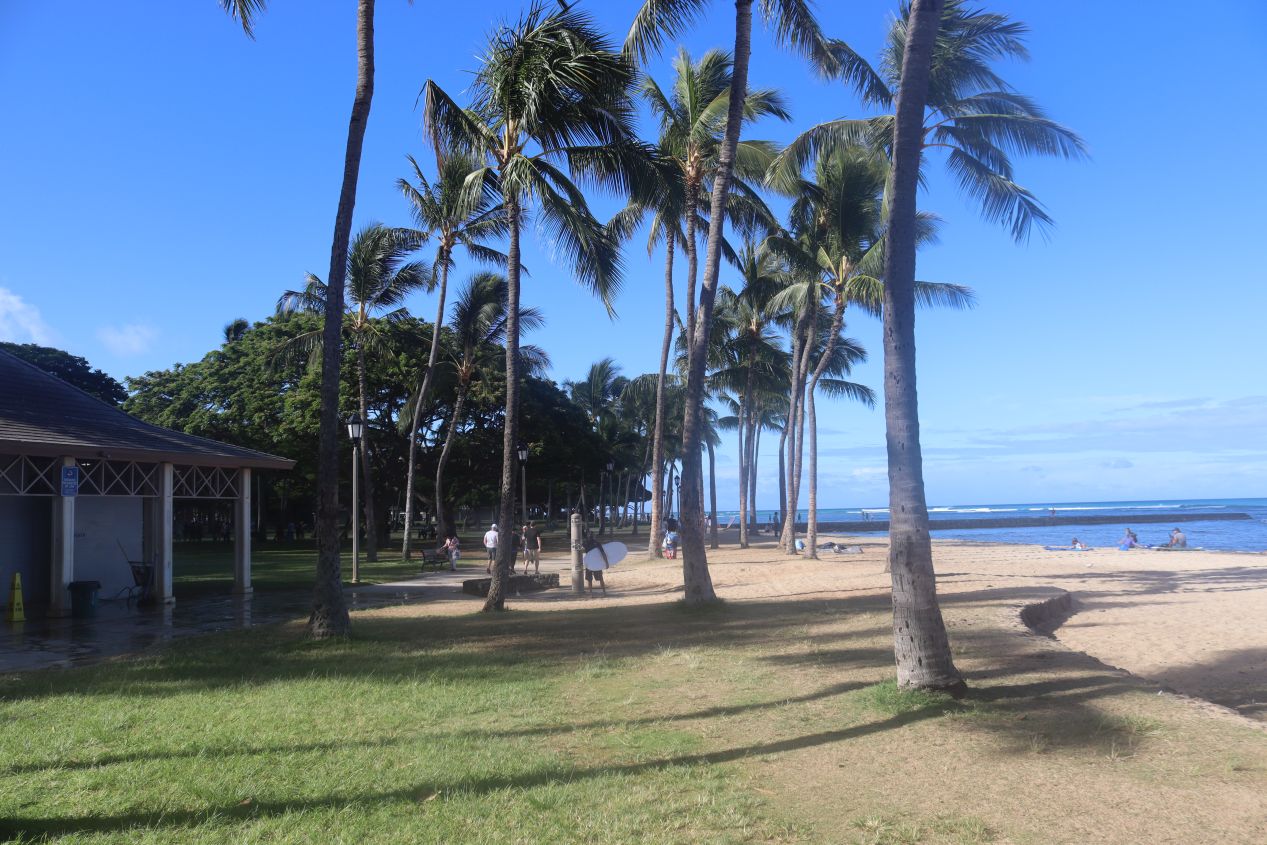
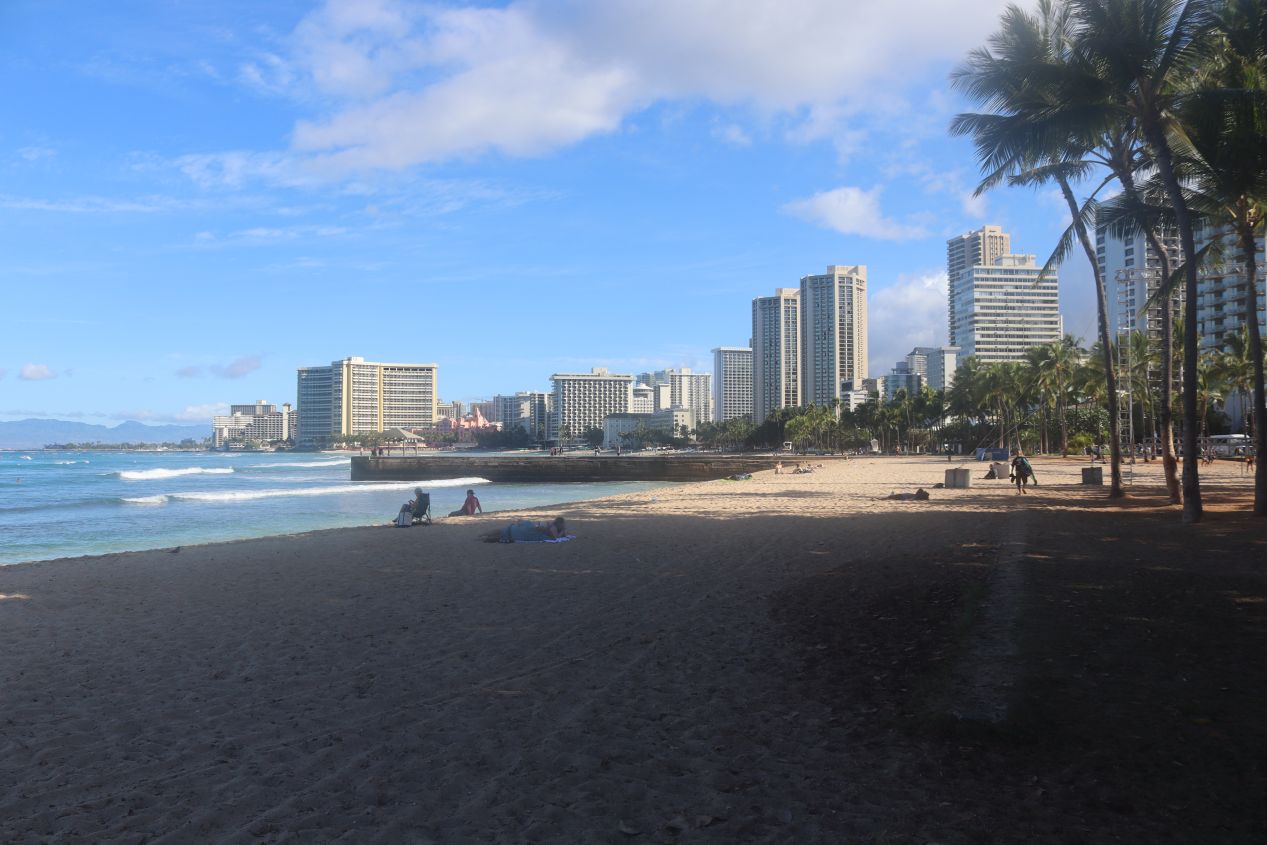
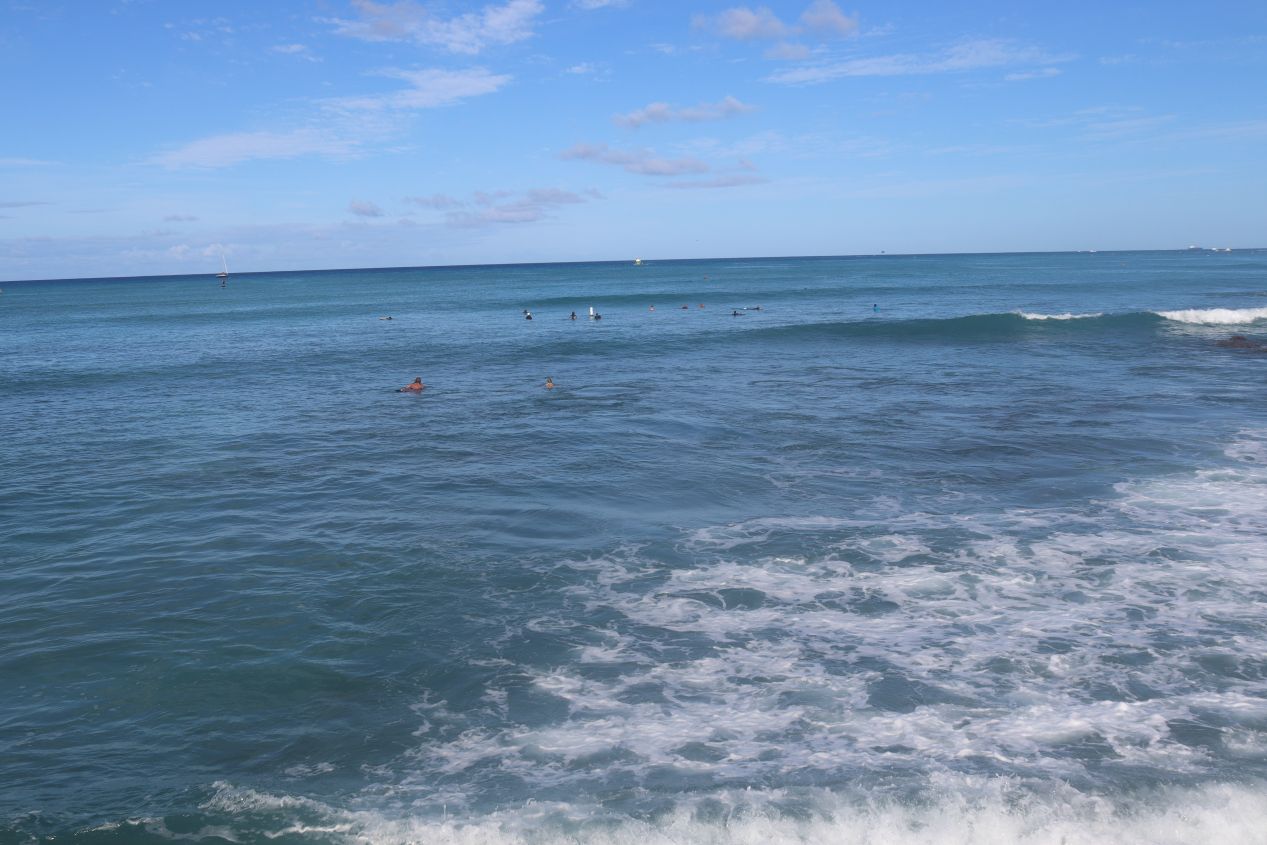
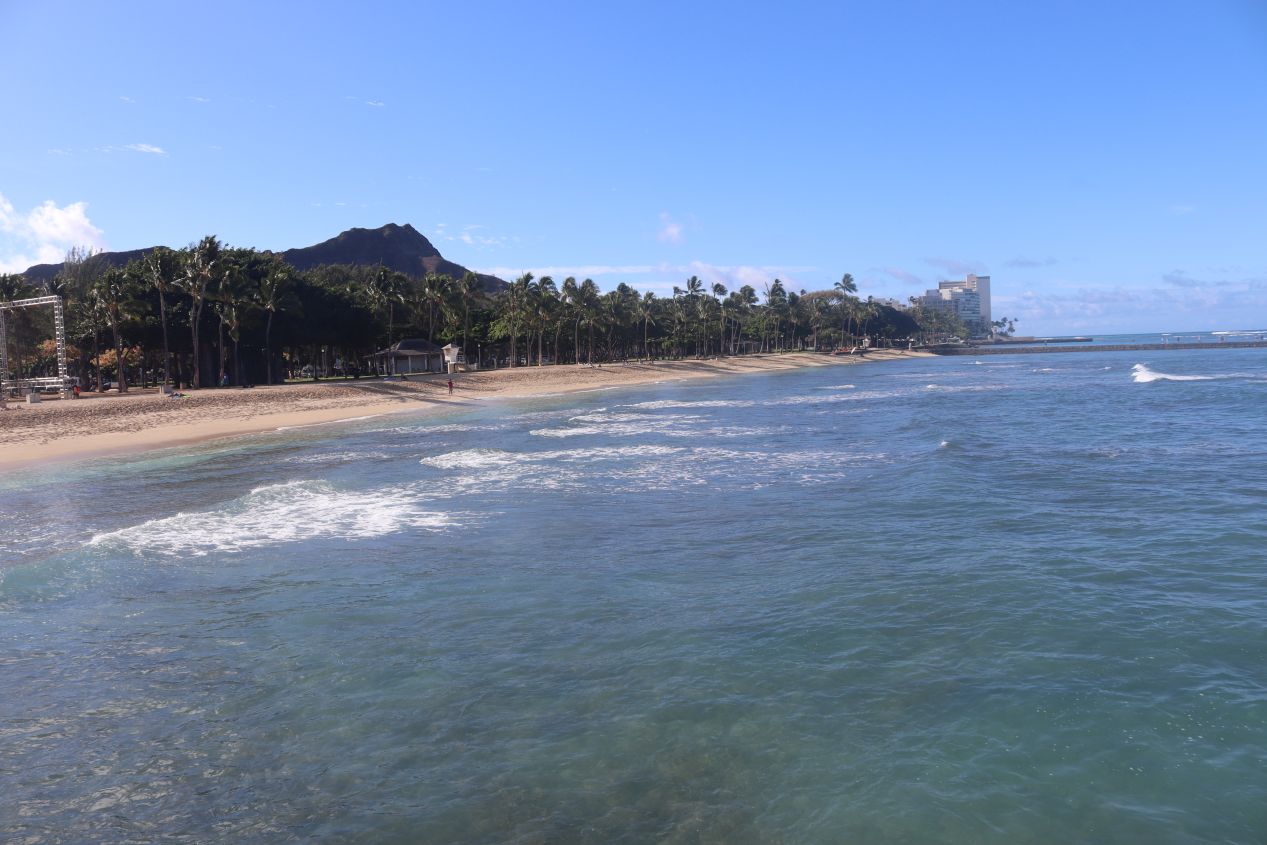
Of course now I had to get back down from the top of Diamond Head which meant walking back the way that I had entered. We can skip over the details of the next hour since I was only retracing my steps in the opposite direction and there were no new pictures to take. I did change one detail of my return route, however, opting to walk back along the shoreline of Waikiki Beach rather than following the Ala Wai canal. This was a longer path back to our hotel but allowed me to see more of the sights and sounds of the beachfont as it woke up for the day. It was a little after 8:00 AM by the time that I made it down to the beach and once again there were a surprising number of people out in the water already. There weren't too many tourists sitting along the shoreline but rather most of the activity was surfers out on the waves. Waikiki Beach is one of the most famous surfing capitals of the world, and even though the surfing professionals prefer the larger waves on the north shore of Oahu, this is a place where huge numbers of tourists come to learn the sport.
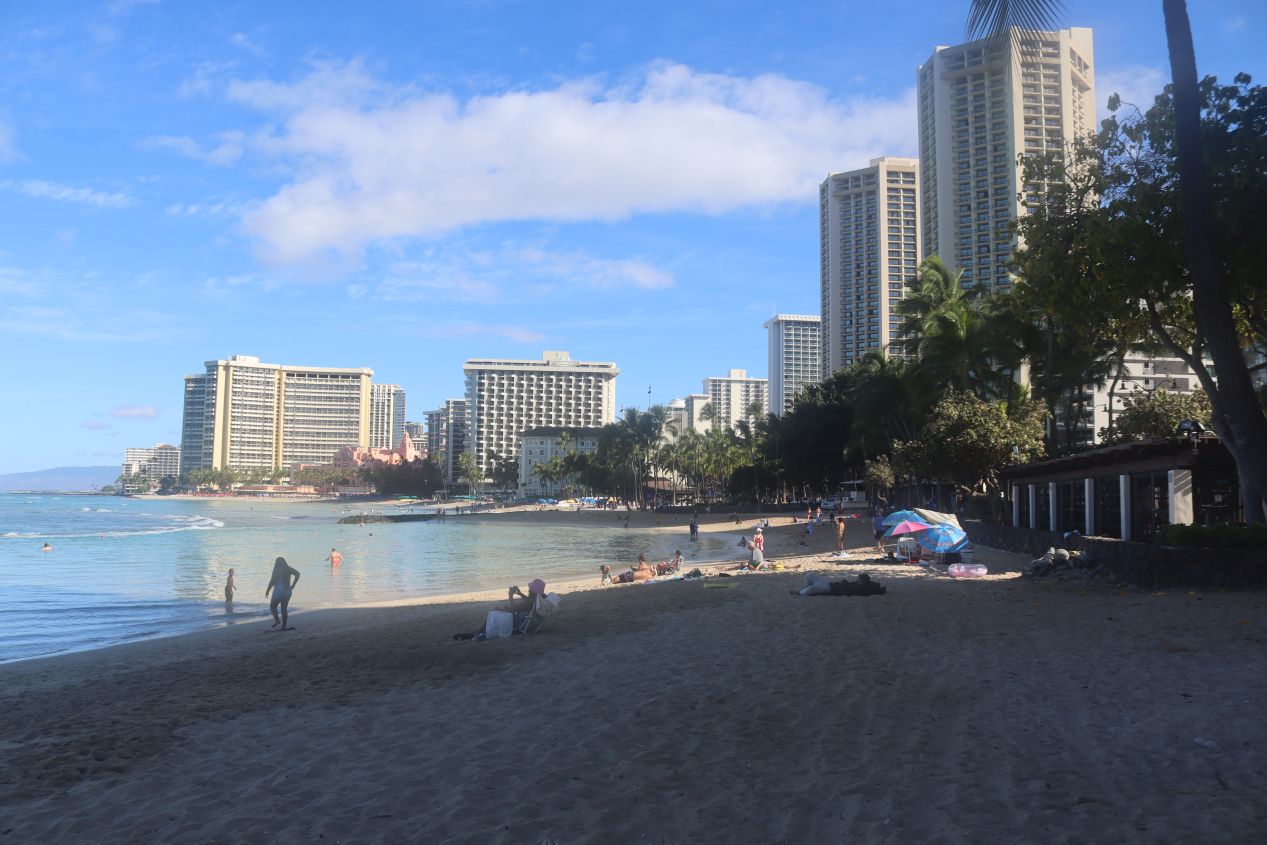
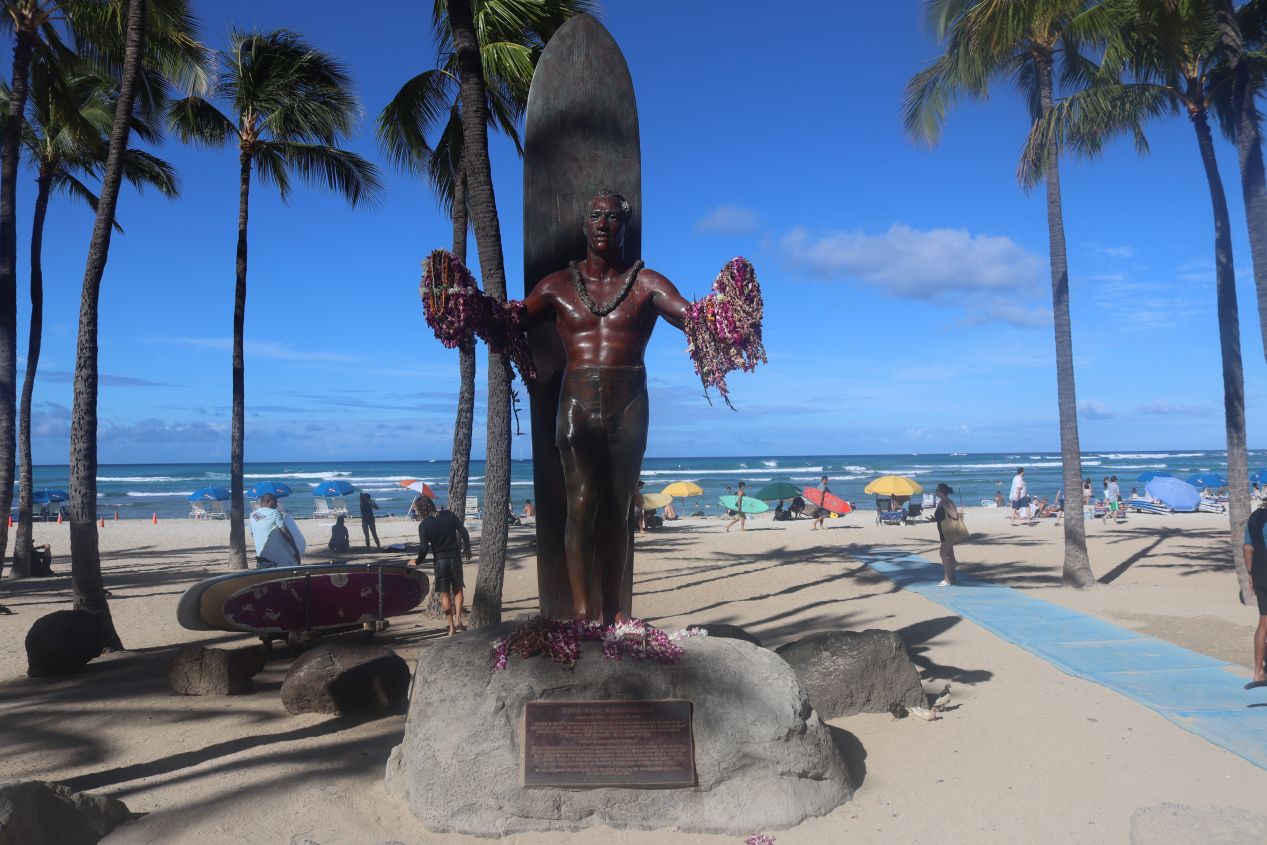
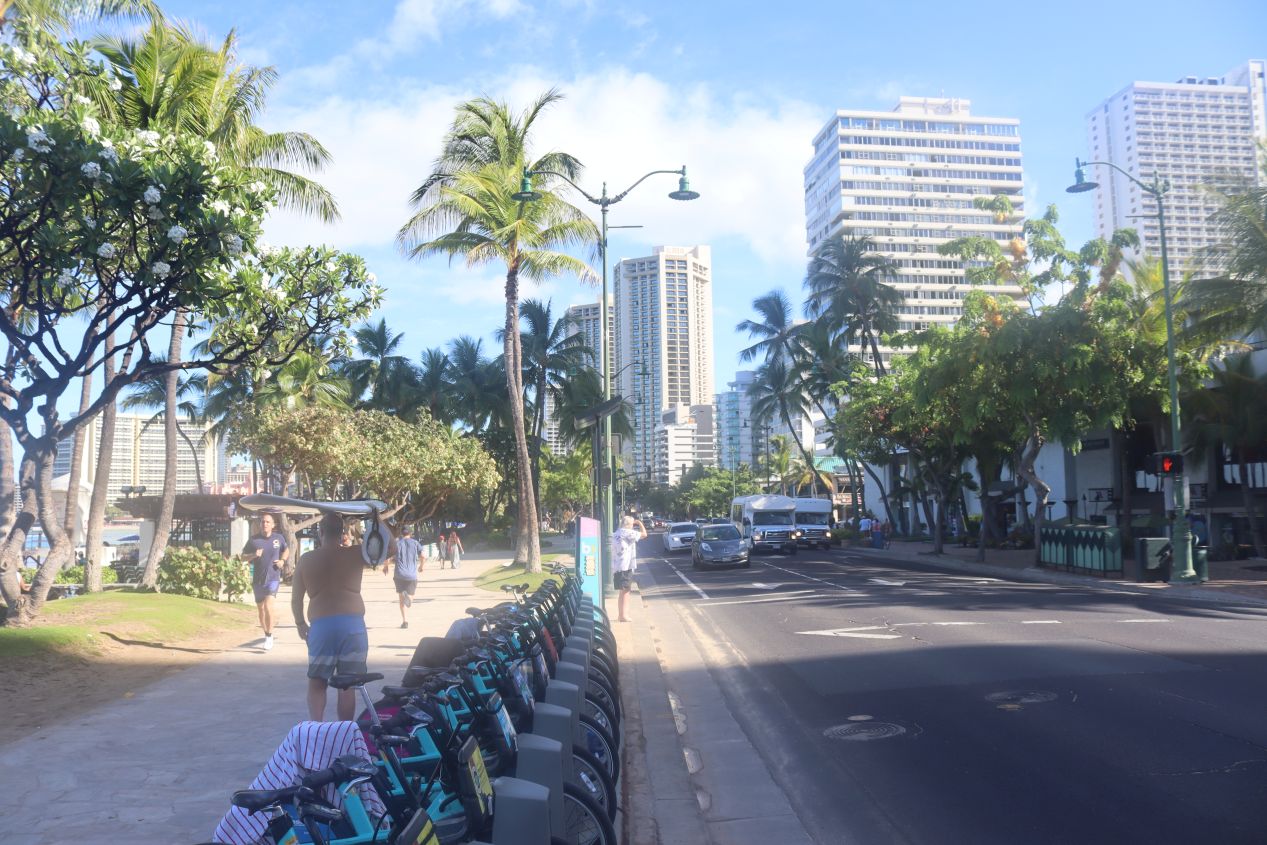
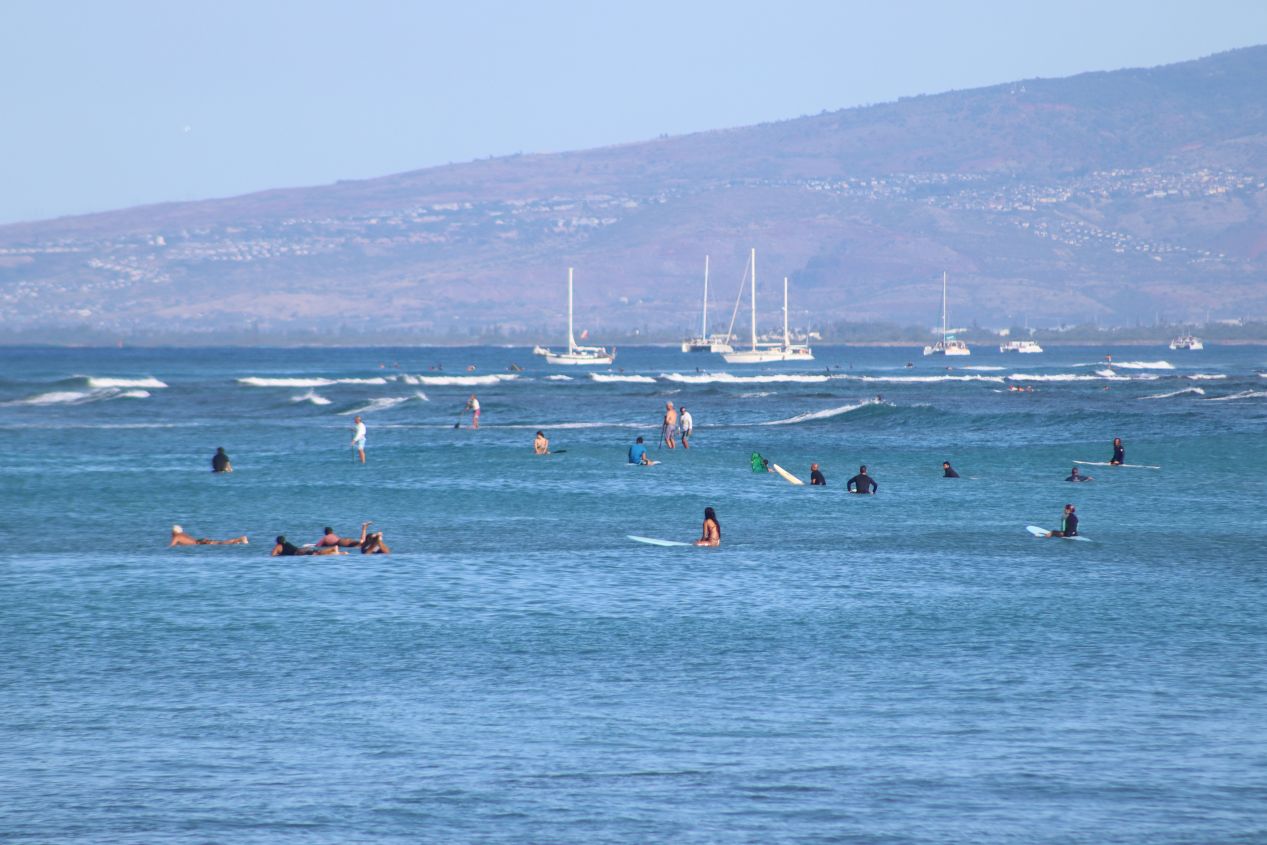
Waikiki Beach runs for more than a mile along the water's edge, with the beach on one side and trendy shops, restaurants, and hotels clustering along the busy Kalakaua Avenue on the other side. As I mentioned above, the surfers were out in large numbers and I spotted dozens of people carrying surfboards or learning the basics under the watchful eye of a surf instructor. There was a statue located right in the center of Waikiki Beach honoring Duke Kahanamoku, an Olympic champion in swimming from Hawaii who is considered the father of modern surfing for popularizing the sport. Duke (his actual name, not a nickname) Kahanamoku had an amazing life story: winning five Olympic medals in the 1920s, performing as a background actor in a number of early Hollywood films, saving the lives of eight men from a sinking fishing vessel in 1925, and serving as the sheriff of Honolulu for 30 years in his later decades. We saw Duke's name in a number of places during our time in Honolulu and he remains a beloved figure there long after his death.
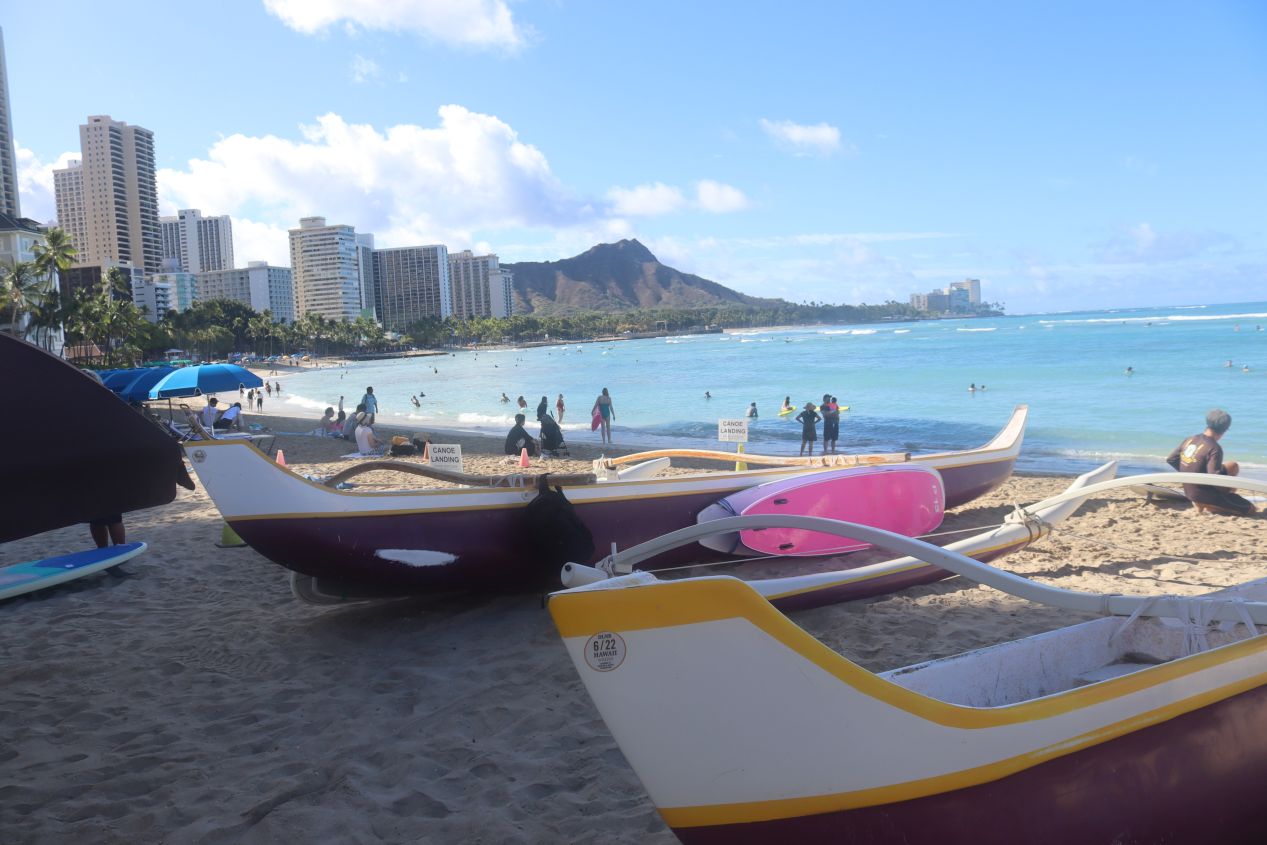
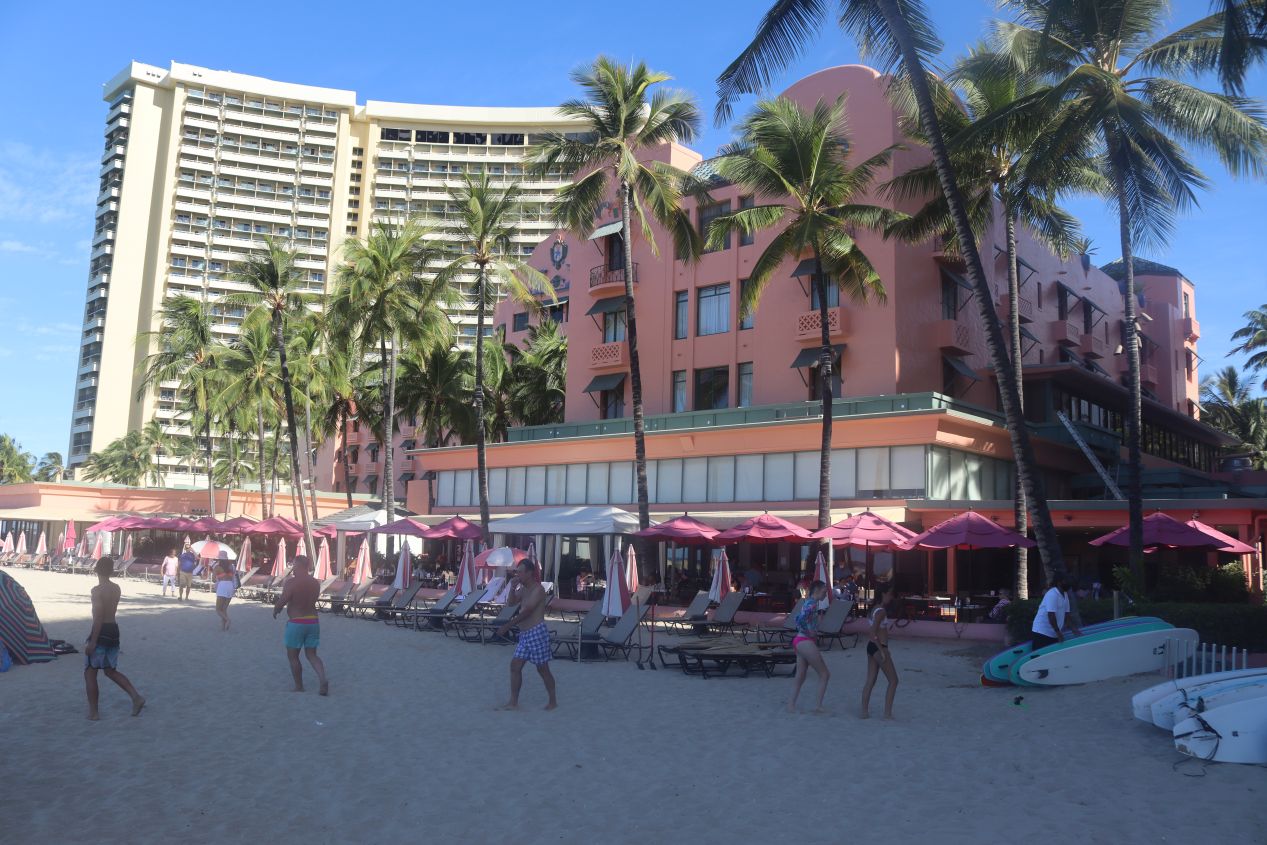
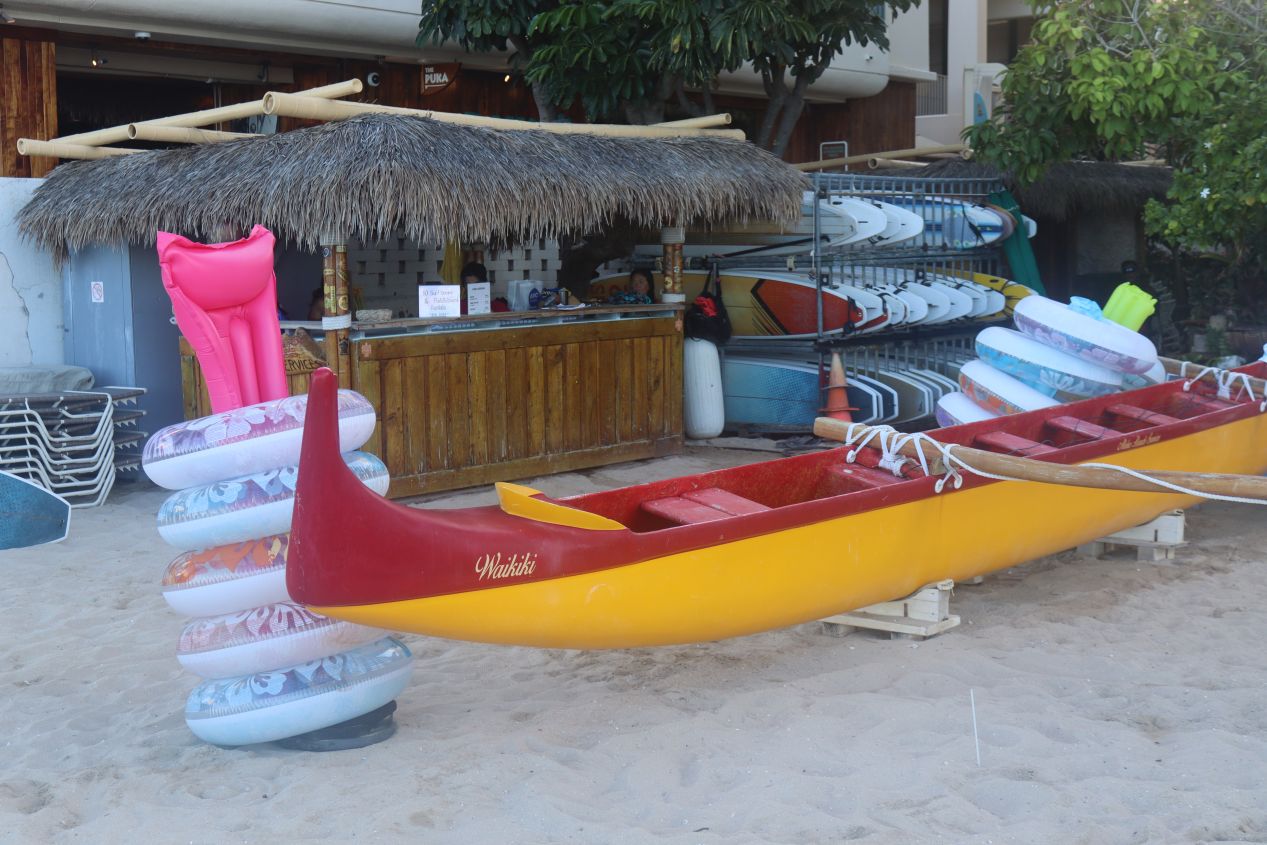
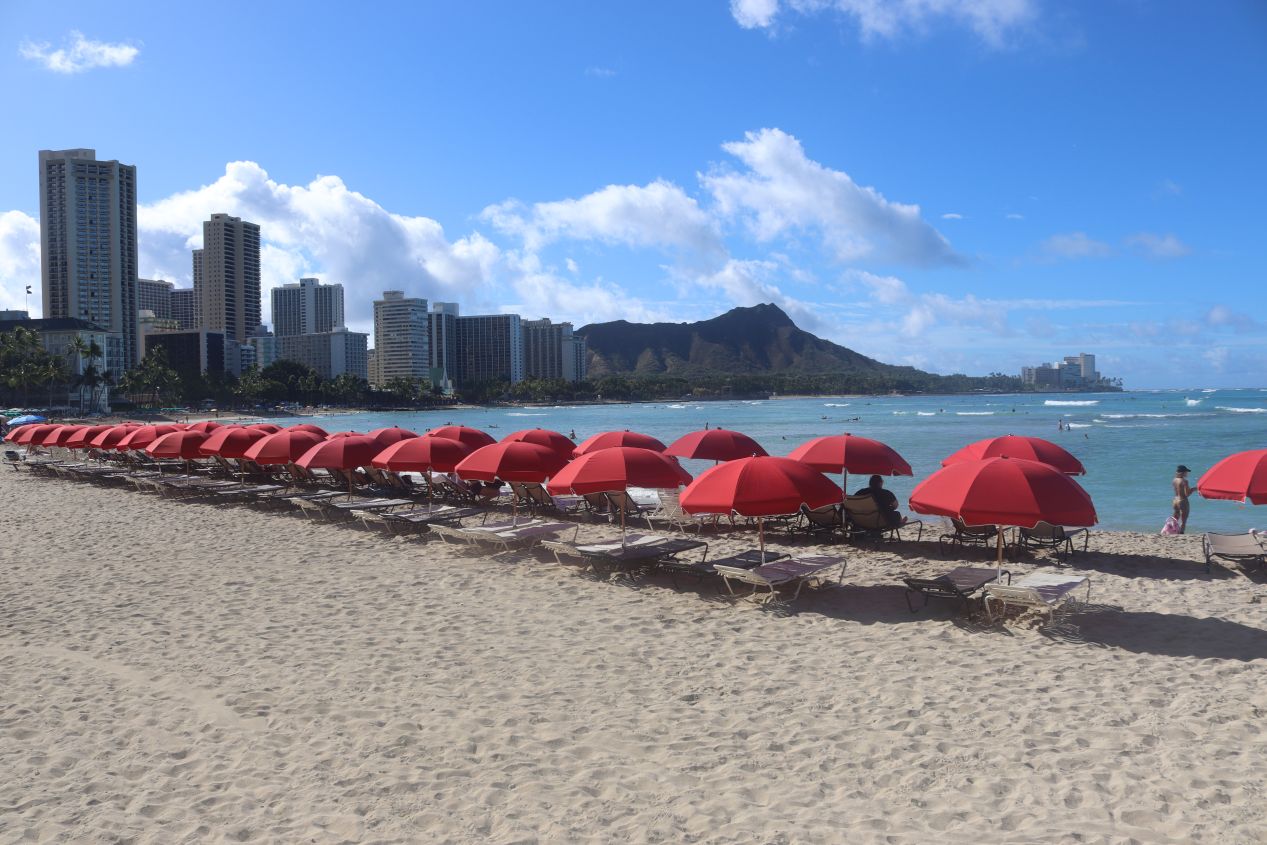
The western side of Waikiki Beach held the oldest and most luxurious hotels, the ones that had claimed the best real estate by virtue of dating back to the first half of the 20th century. This is where we would have liked to stay if we could have afforded the hefty prices that these locations demanded. This part of the beach also seemed to be where canoes and other boats could be found, and indeed this is where we would be catching our own catamaran boat ride later this evening. This area also had some of the most desirable real estate because it provided beautiful views of Diamond Head across the waters of Waikiki Bay. That rugged cone off in the distance made for perfectly picturesque images of the beachfront which were unique to Waikiki. It was a little hard to believe that I had walked up to the top of Diamond Head and then back again over the course of this eventful morning.
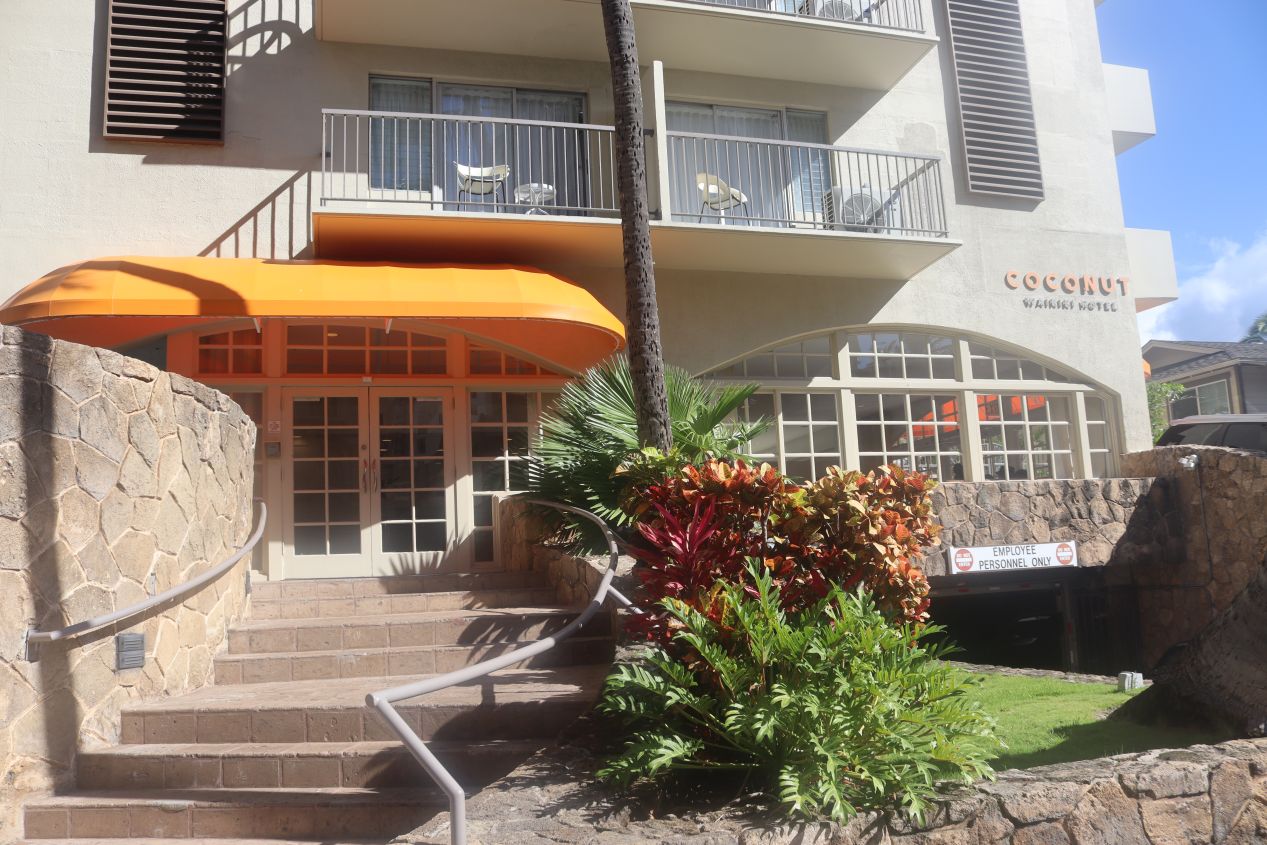
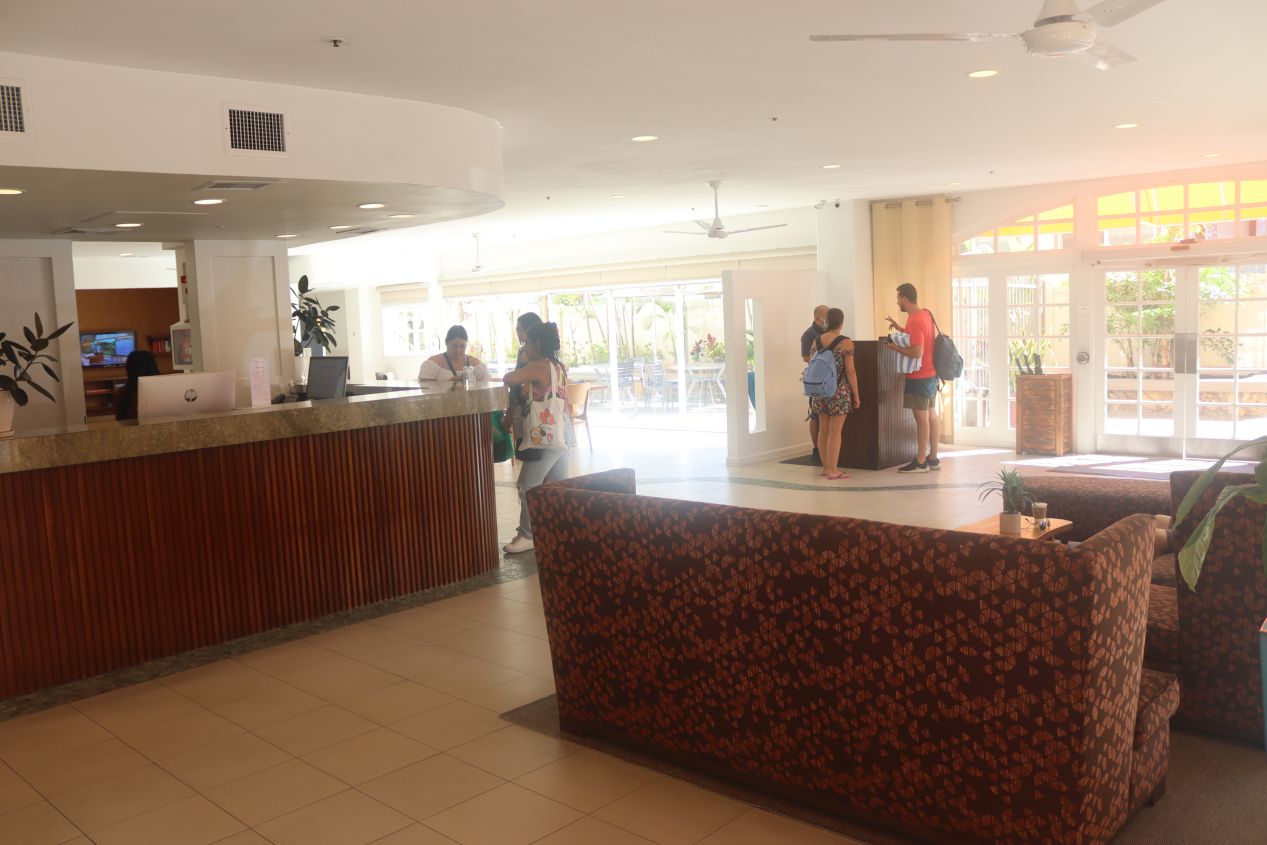
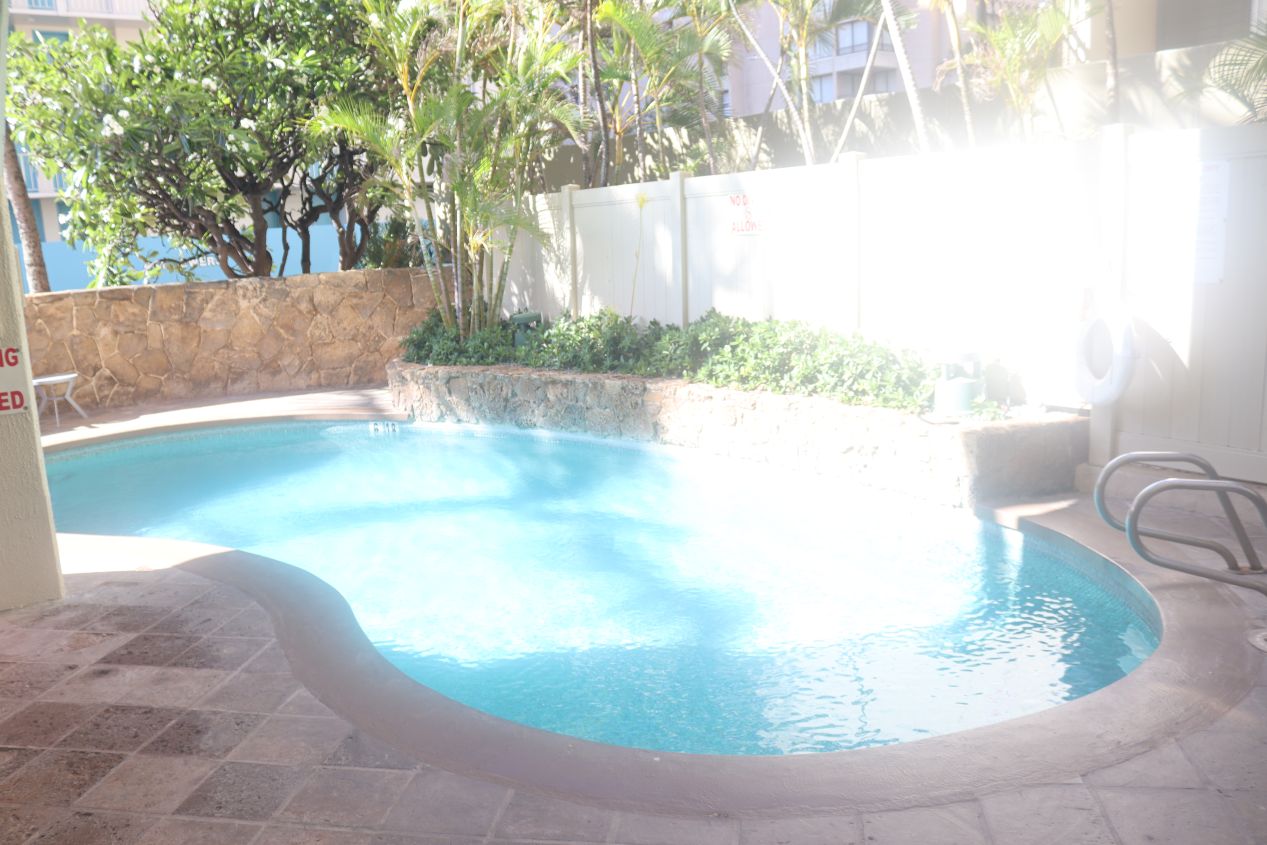
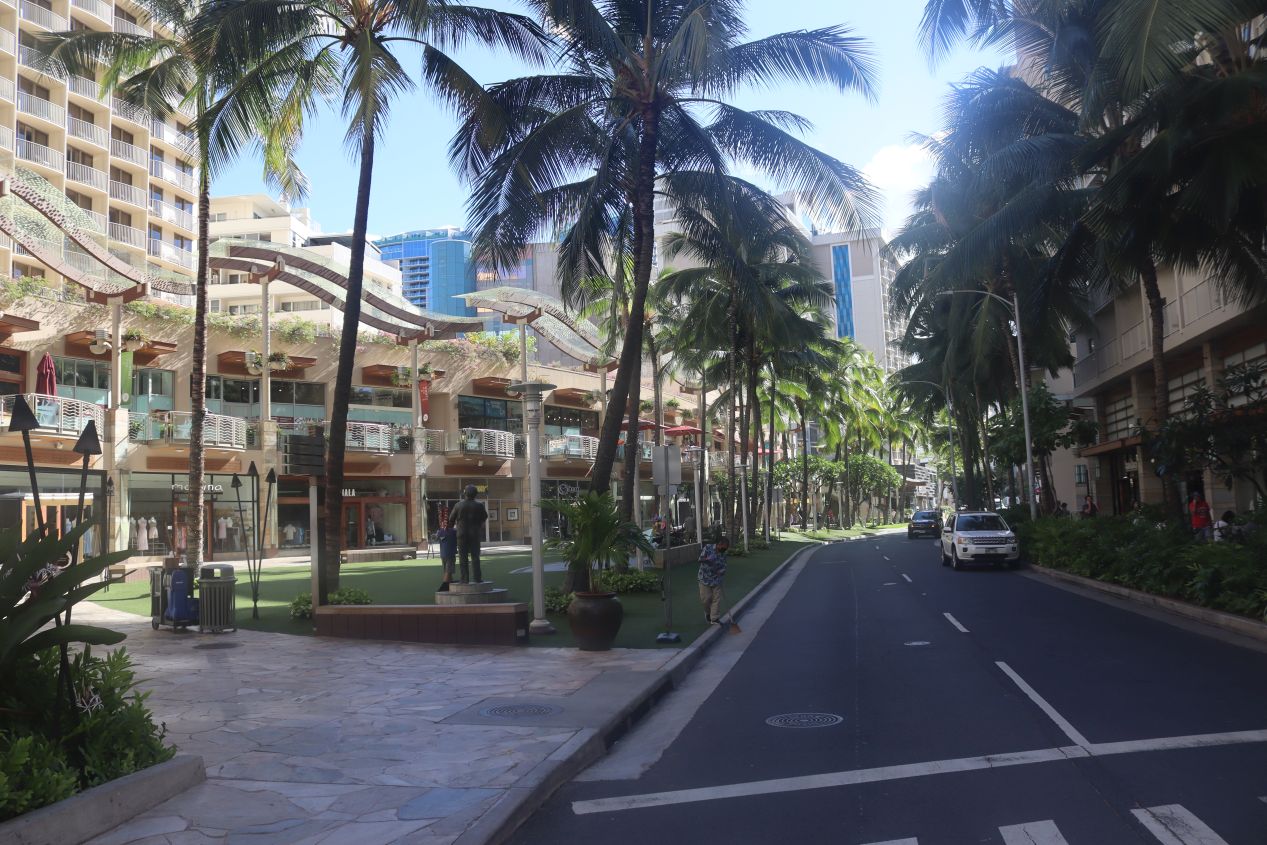
These are some pictures of the hotel where we were staying, the significantly less luxurious Coconut Waikiki Hotel. It was located near the canal (i.e. away from the beach) which made the the nightly cost only expensive instead of exorbitant - nowhere in Waikiki is truly cheap to stay. We had a walk of about four or five blocks to reach the water and that wasn't too bad, especially since there were so many stores and restaurants along the way to check out. One other advantage to being a bit further away was that it was quieter in the evenings which we needed since we were still trying to get over our jet lag. In any case, I made it back to our hotel by about 9:30 AM and rested for a little while, with Liz and I planning to head down towards the beach around lunchtime.
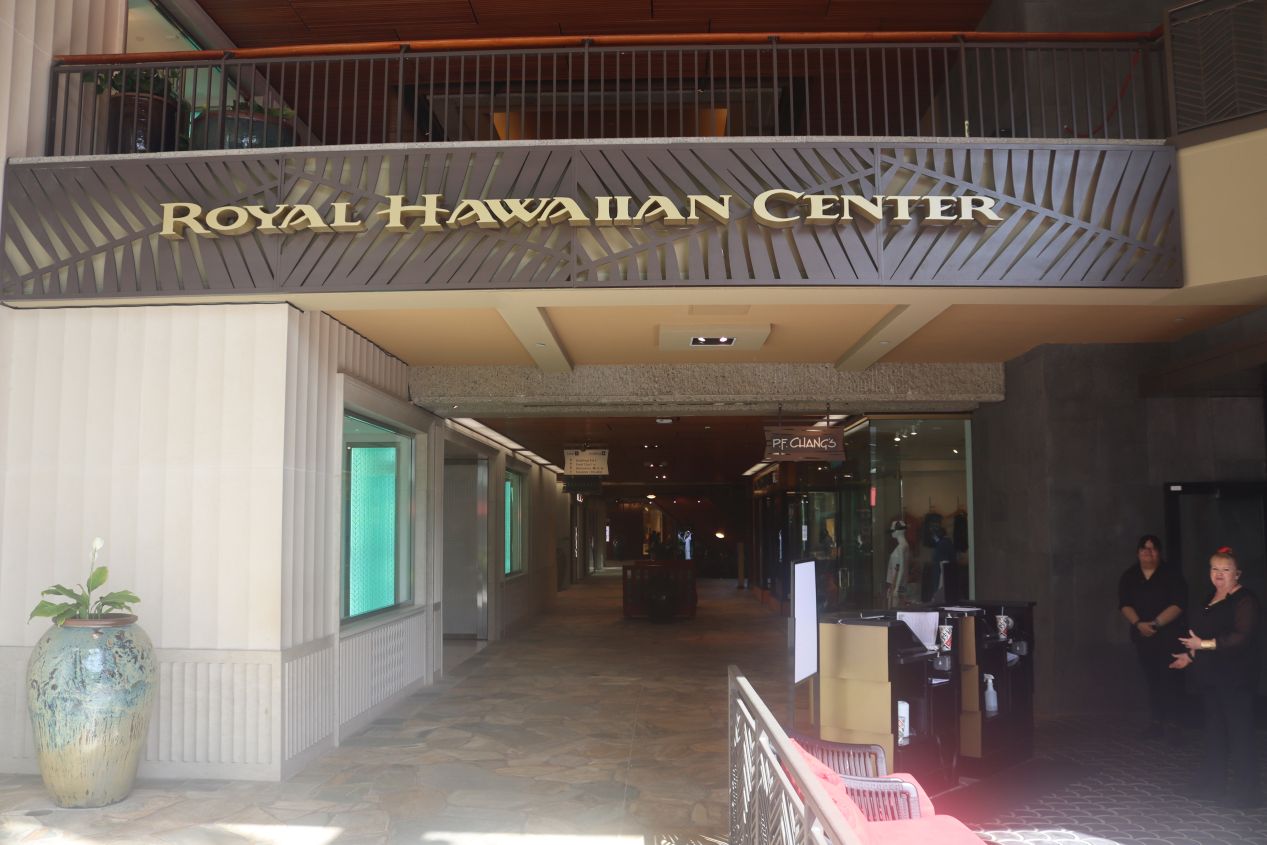
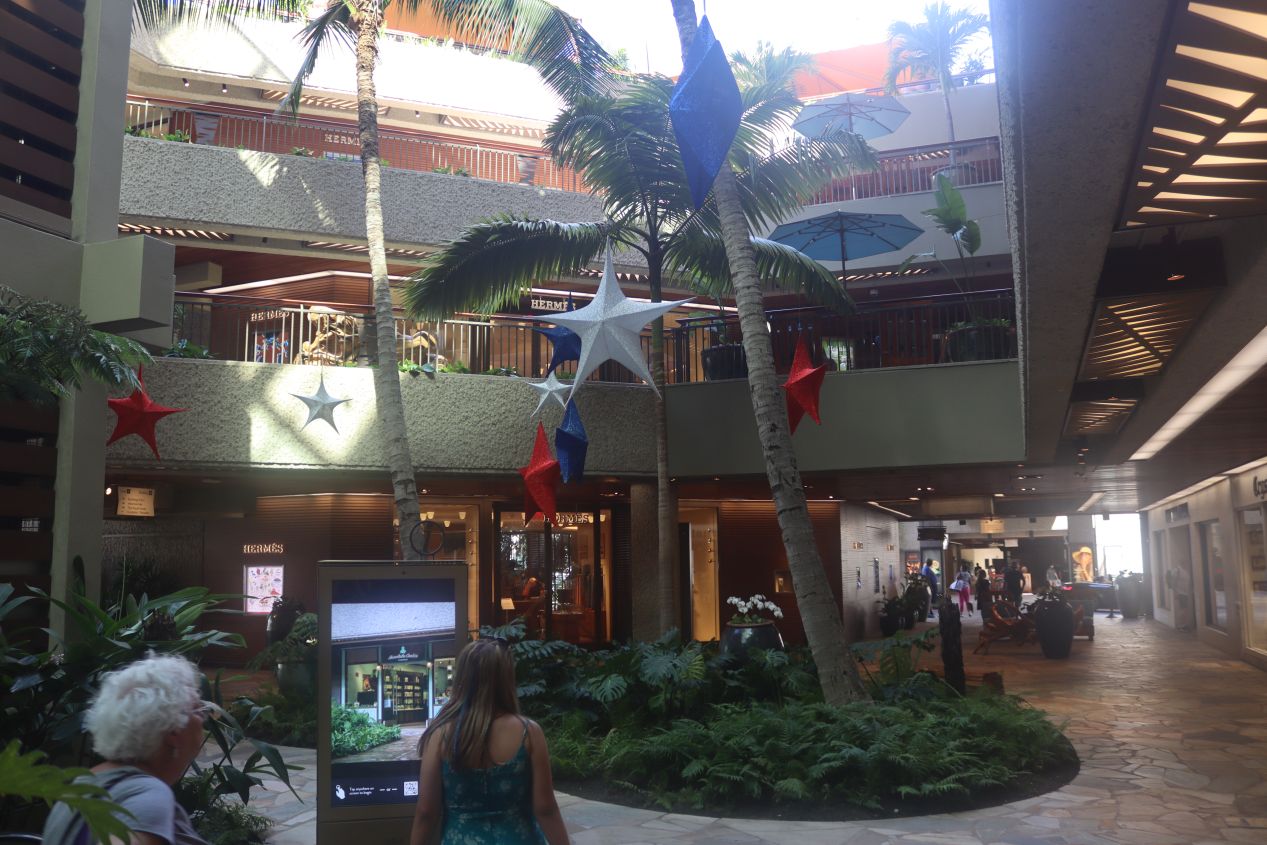
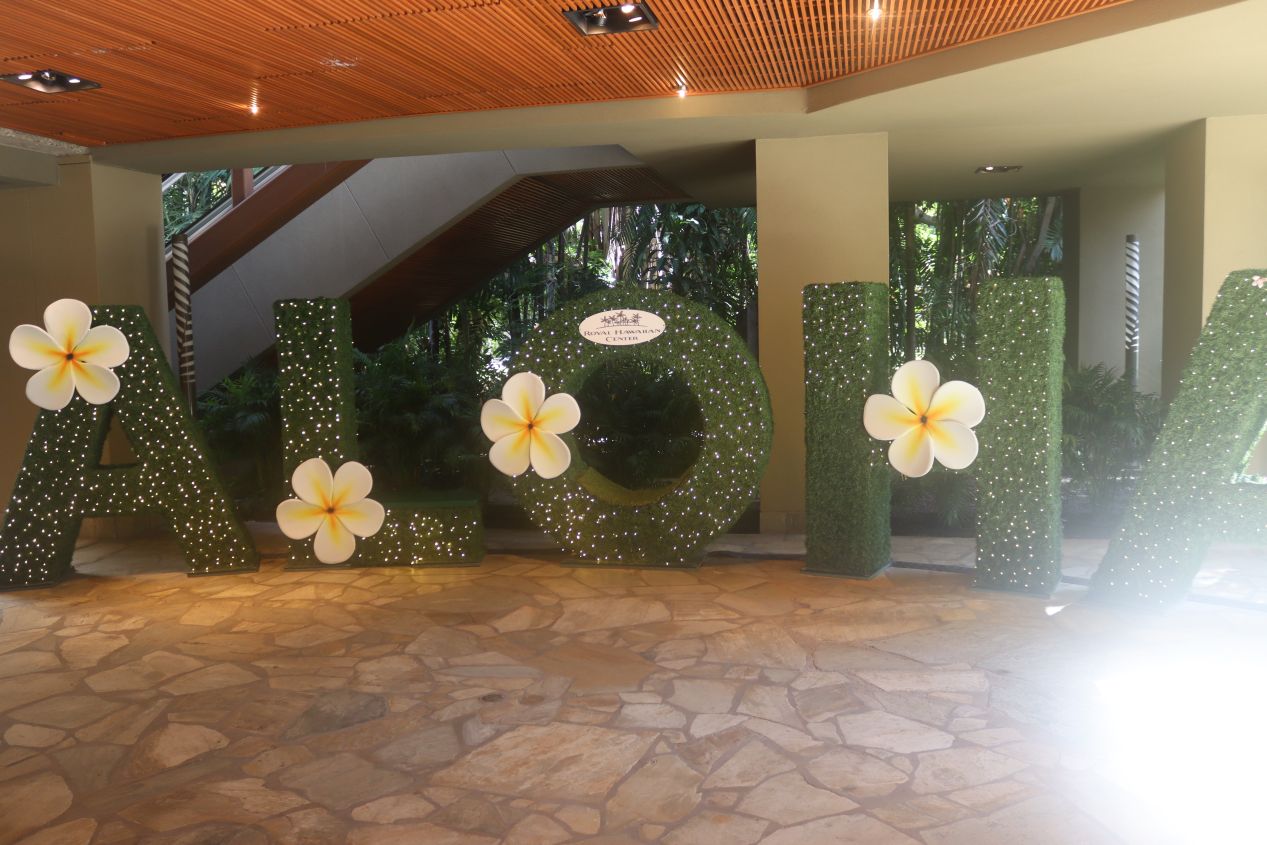
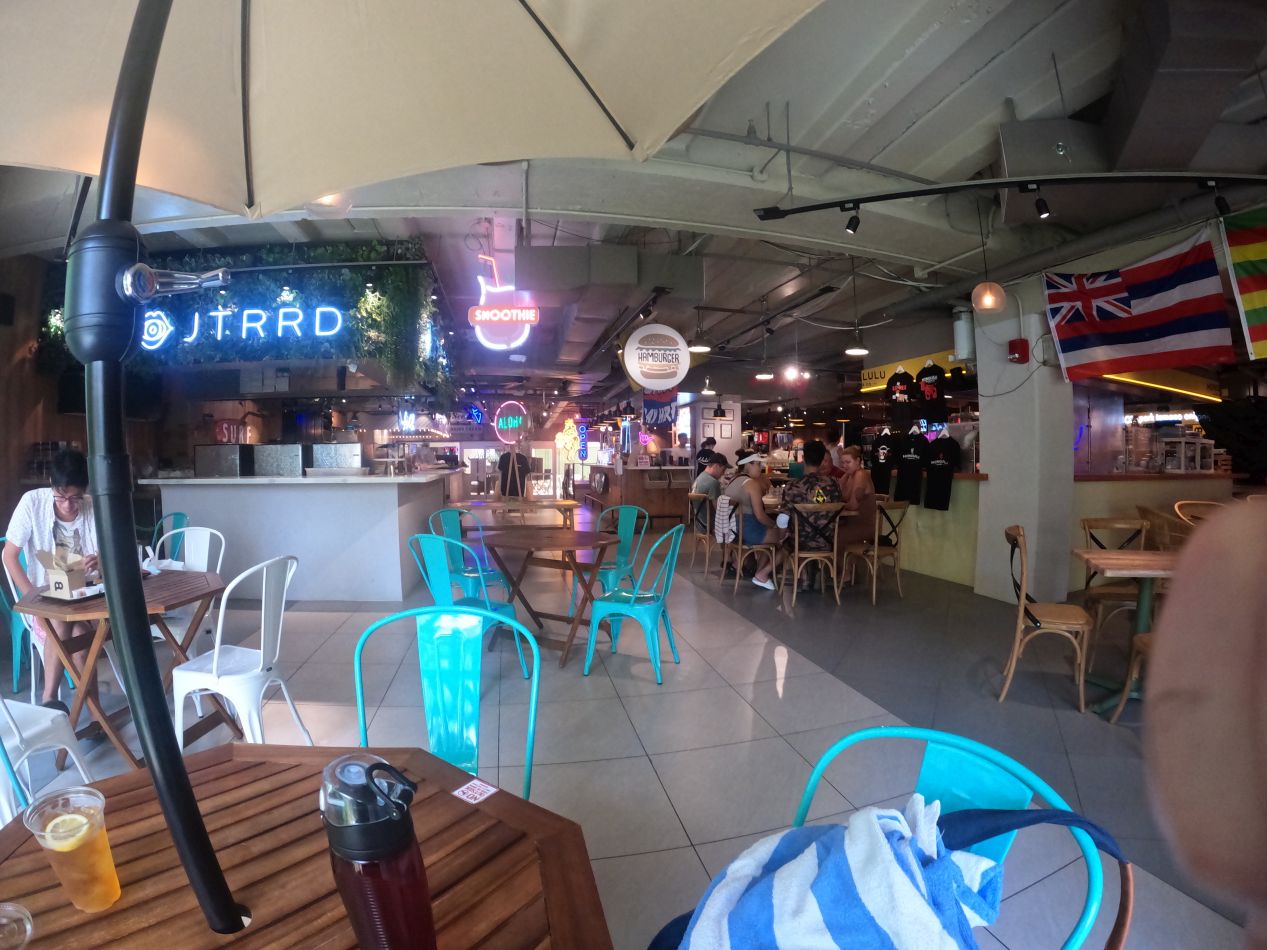
We headed first to one of the shopping areas along Kalakaua Avenue, the Royal Hawaiian Center. This was essentially a mall albeit a rather upscale one which was constantly opening up to the outdoors. We spent some time wandering around and seeing what was available before deciding on lunch in a small food court area up on the top floor. Liz had onigiri with egg and SPAM while I had a shrimp and rice bowl; the food court area wasn't crowded at this time of day and we were able to view the nearby Royal Hawaiian Hotel which was where we planned to relax on the beach.
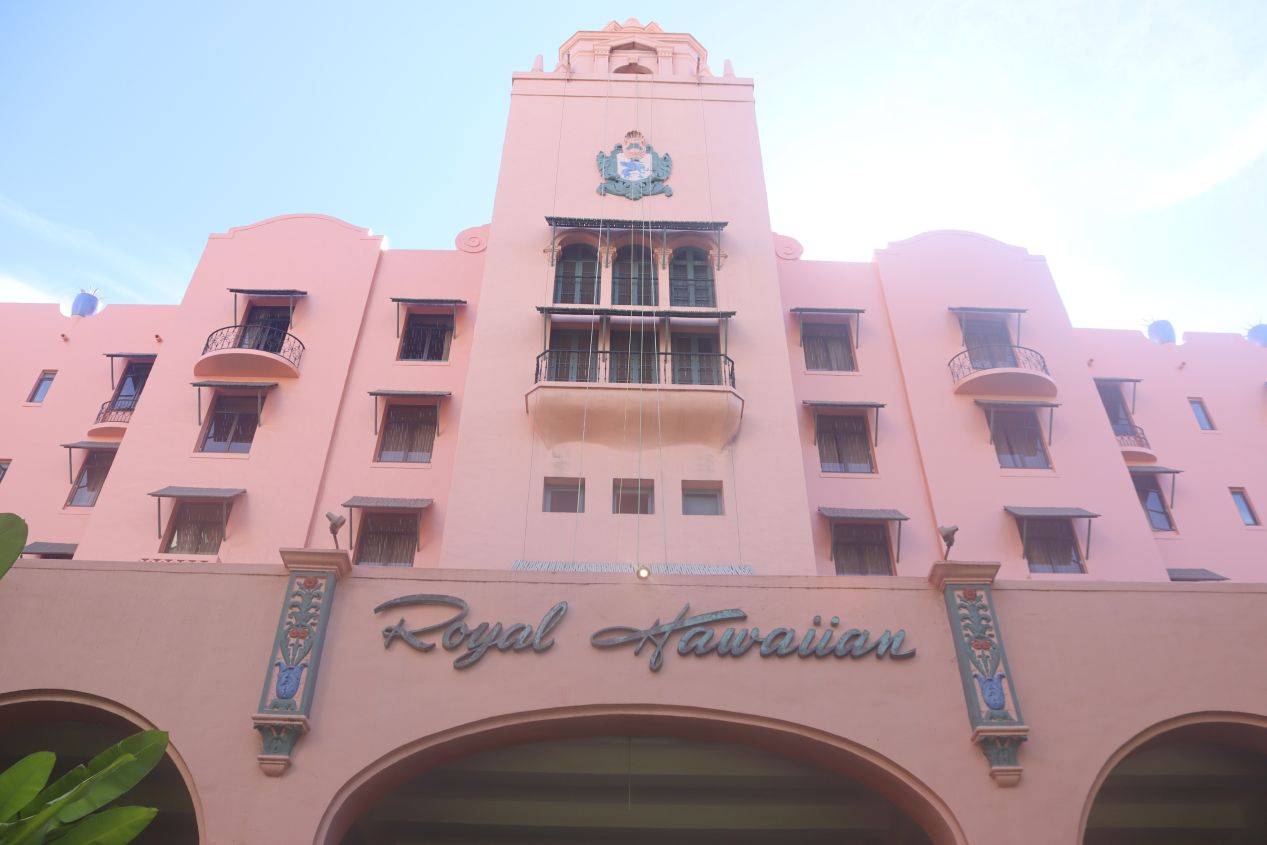
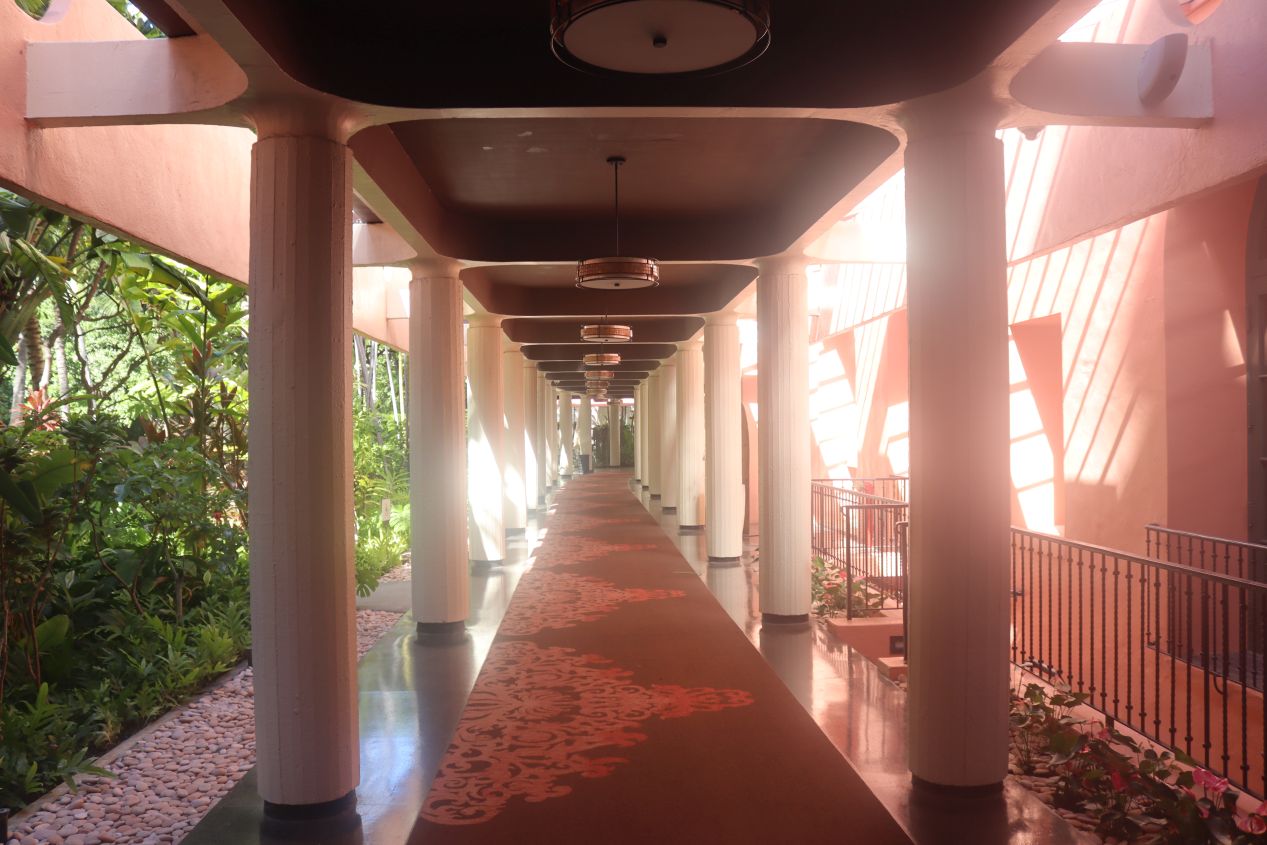
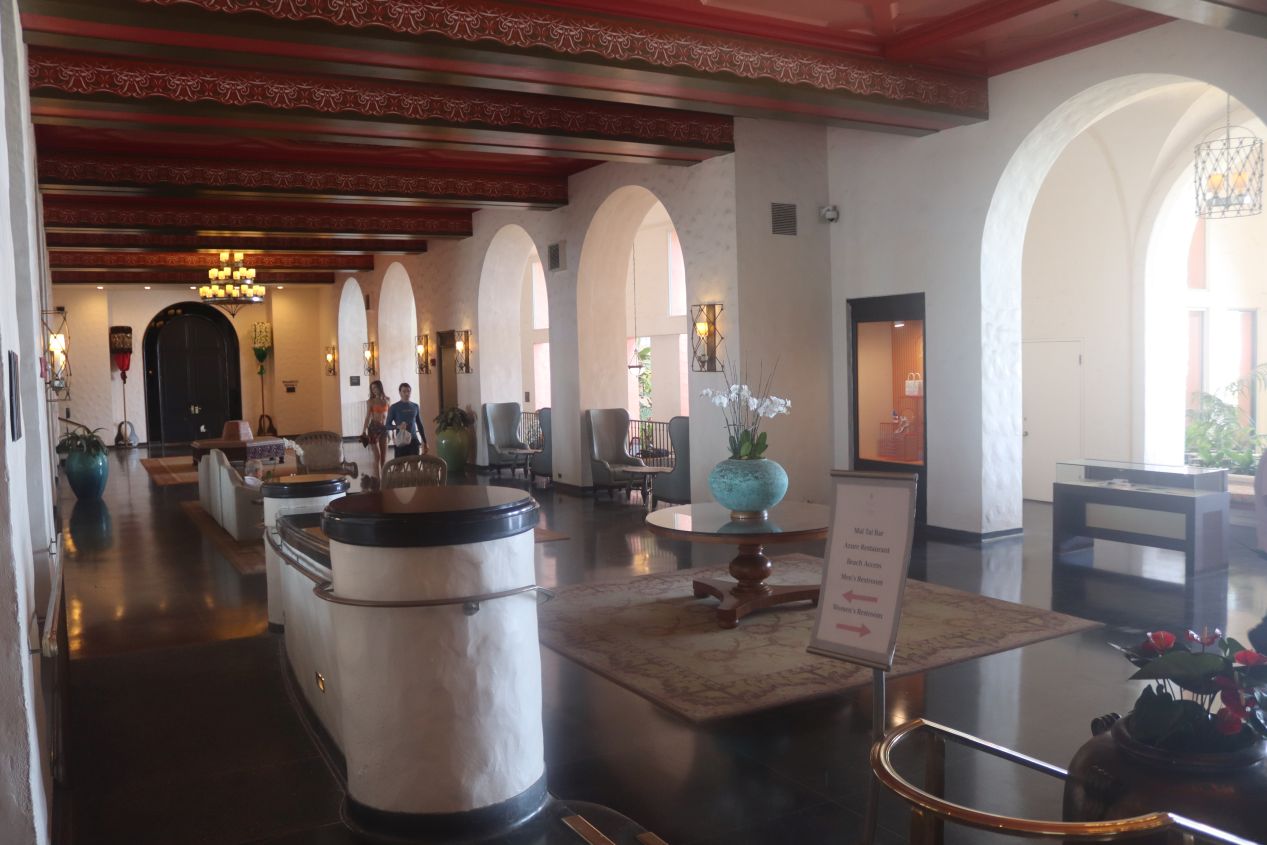
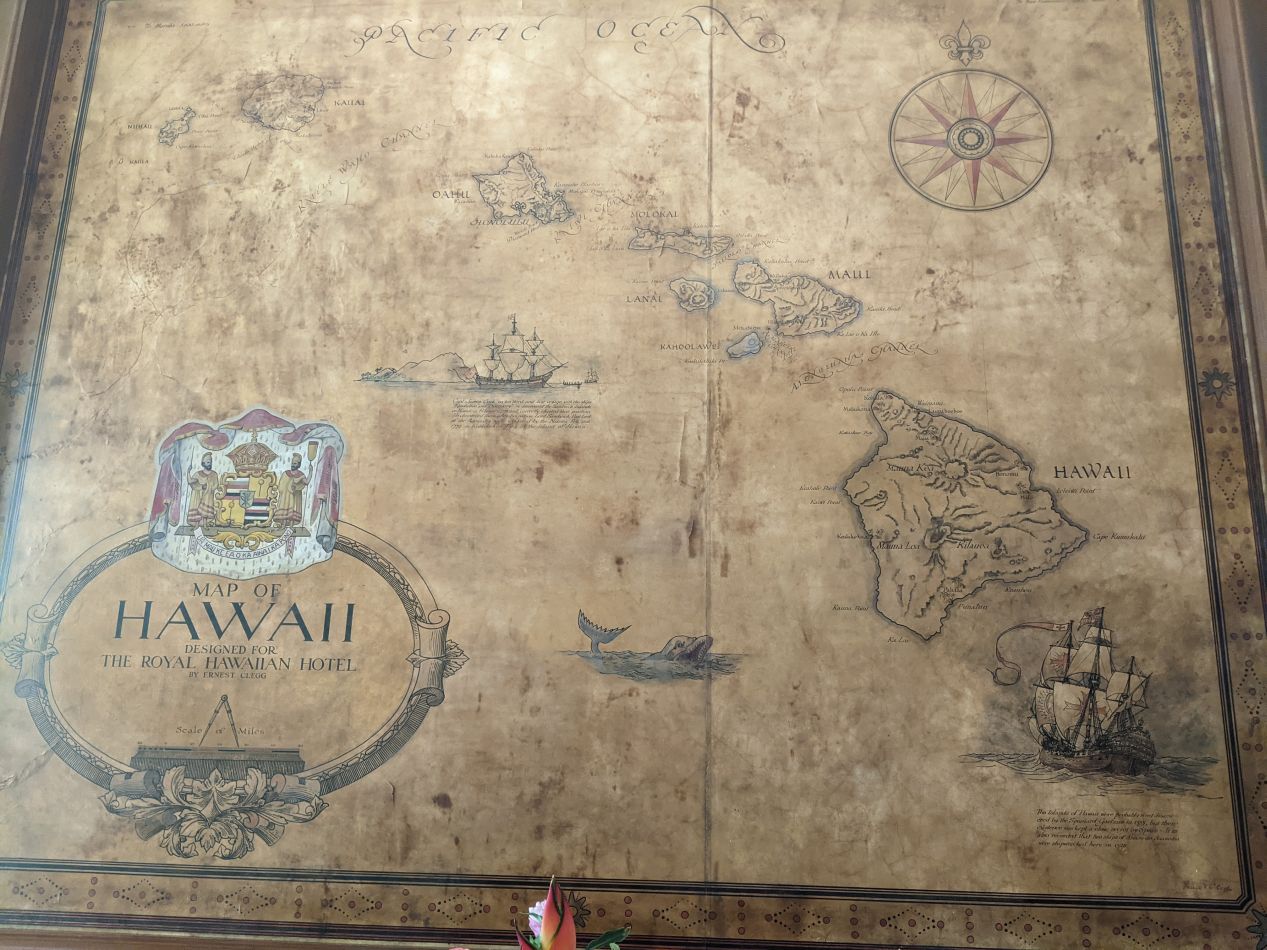
These are some pictures of the aforementioned Royal Hawaiian Hotel which had its ground floor lobby open to the public. The Royal Hawaiian is one of the oldest and most luxurious hotels in Wakiki, dating back to 1927 and boasting of more than 500 rooms in total. It was an easily recognizable landmark whenever we were walking around the beach thanks to the bright pink coloring of the hotel's stucco facade. The lobby area had its own smaller shopping mall (featuring high-end retailers) along with colonnaded walkways, a sand sculpture of the hotel's logo, and this beautiful old map of Hawaii that had to date back to when the place opened. Passing through the hotel's ground floor was one of the easiest ways to gain access to the beach, aside from the area which was roped off due to a wedding about to take place. That had to have been expensive for everyone involved.
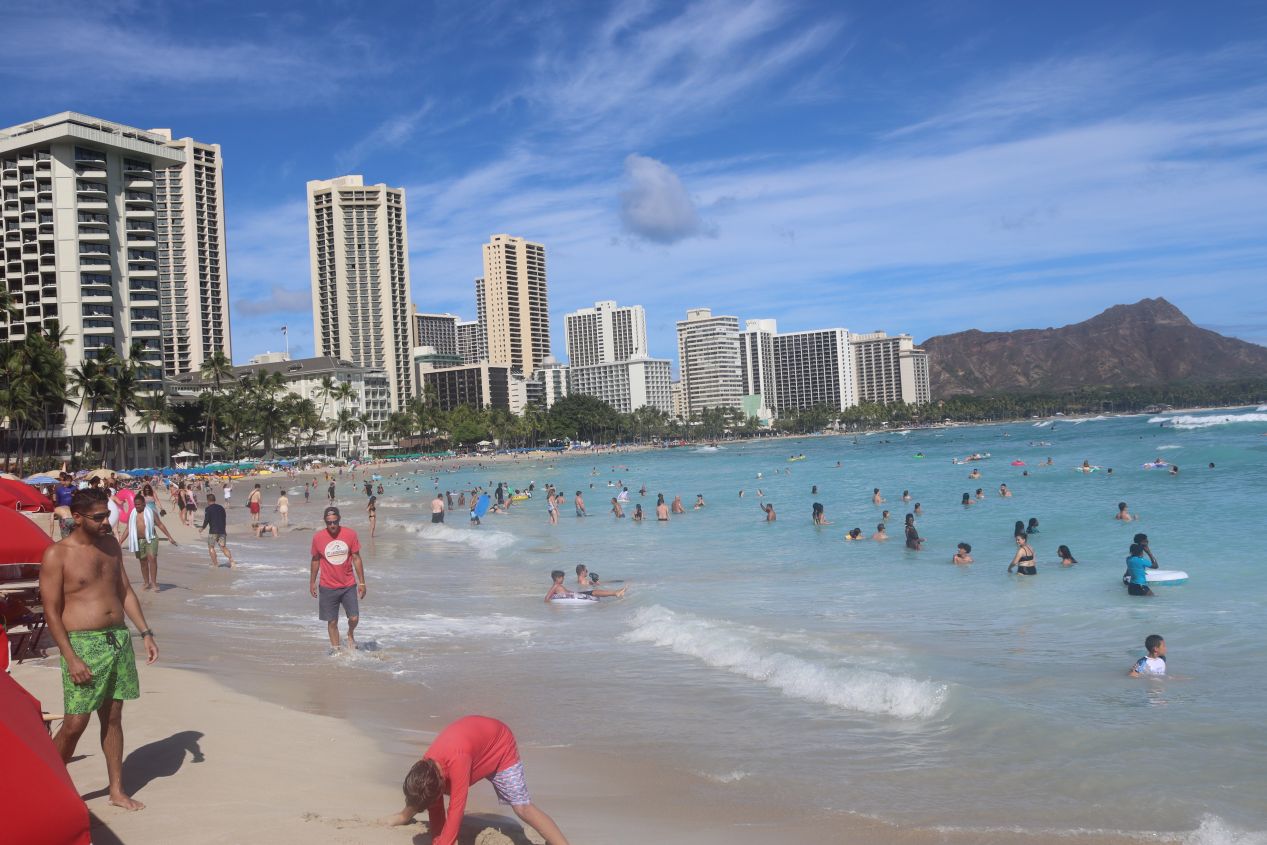
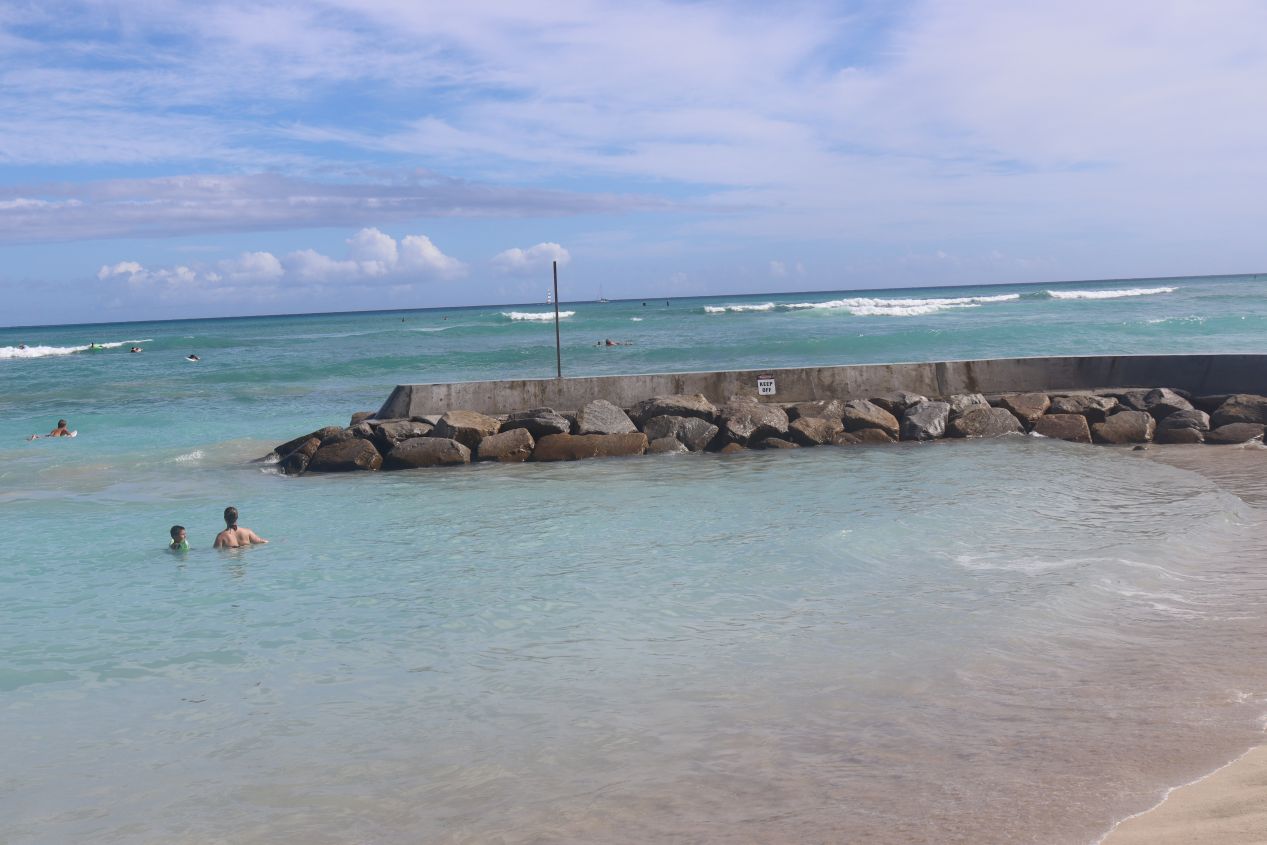
For the next few hours, we hung out on the beach and tried to take it easy, something that I'm not great at doing. We paid $20 to rent an umbrella for a few hours without which the bright sunshine would have made for a miserable experience. This was the same part of Waikiki Beach that I had walked past earlier in the day, now swelled with thousands of other tourists who had come to enjoy the surf. Liz mostly enjoyed relaxing under the umbrella with a cool drink and something to read. I spent more time in the water, testing out the new snorkel that came along with my scuba lessons from earlier the same year. Here in the tropics the ocean was nice and warm although visibility underwater was limited due to the waves crashing onto the beach and stirring up the sand. There were a series of concrete slabs running underwater that I followed for a while without them leading anywhere; I'm guessing they dated back to an earlier period when the beach was used for more boating activities and less tourism.
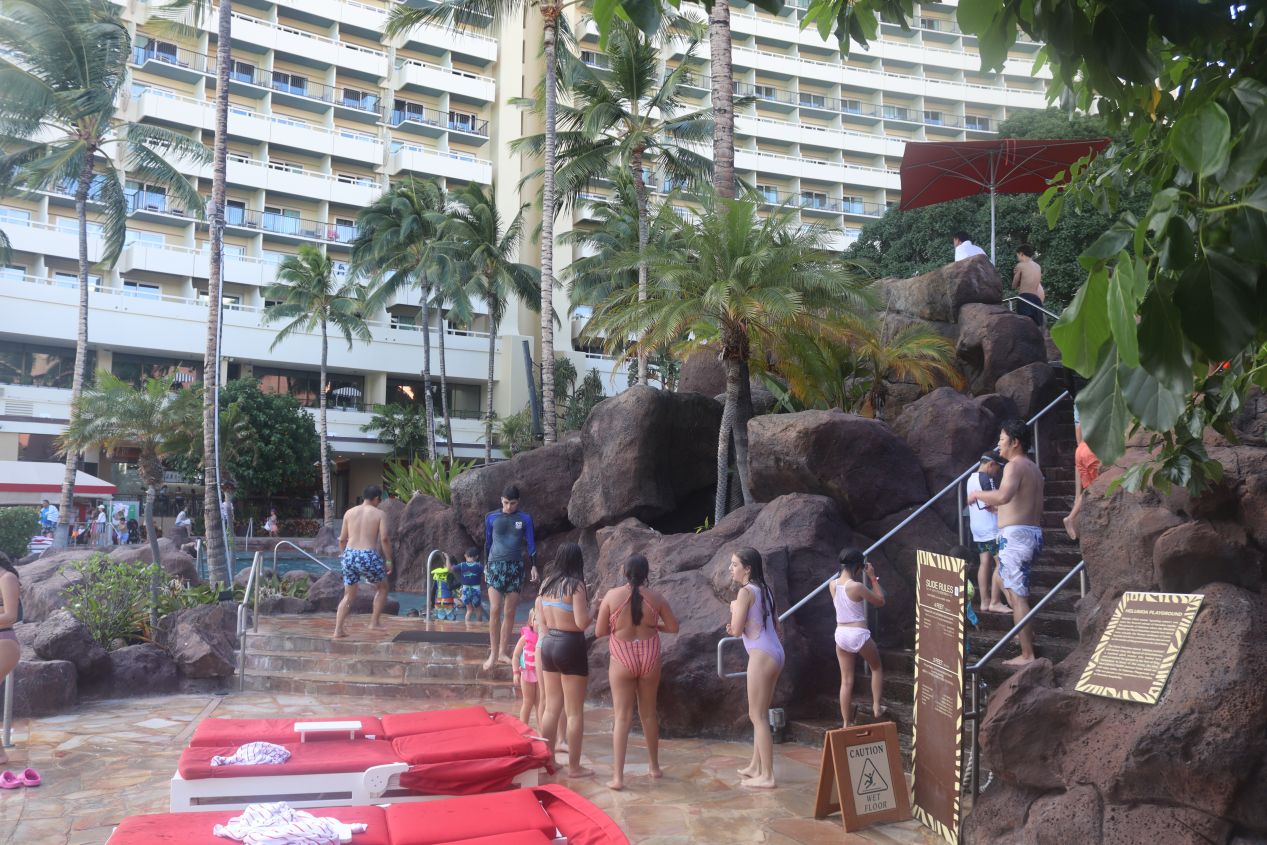
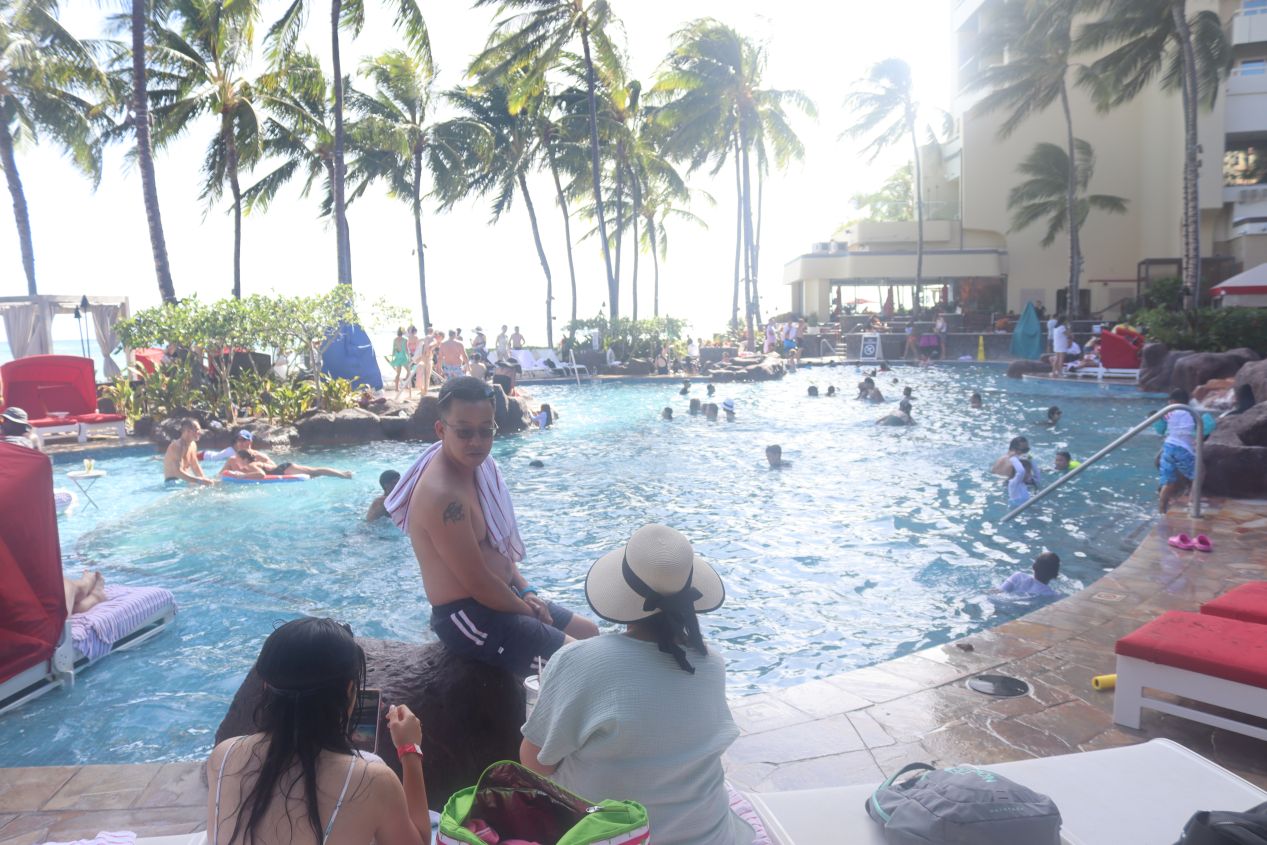
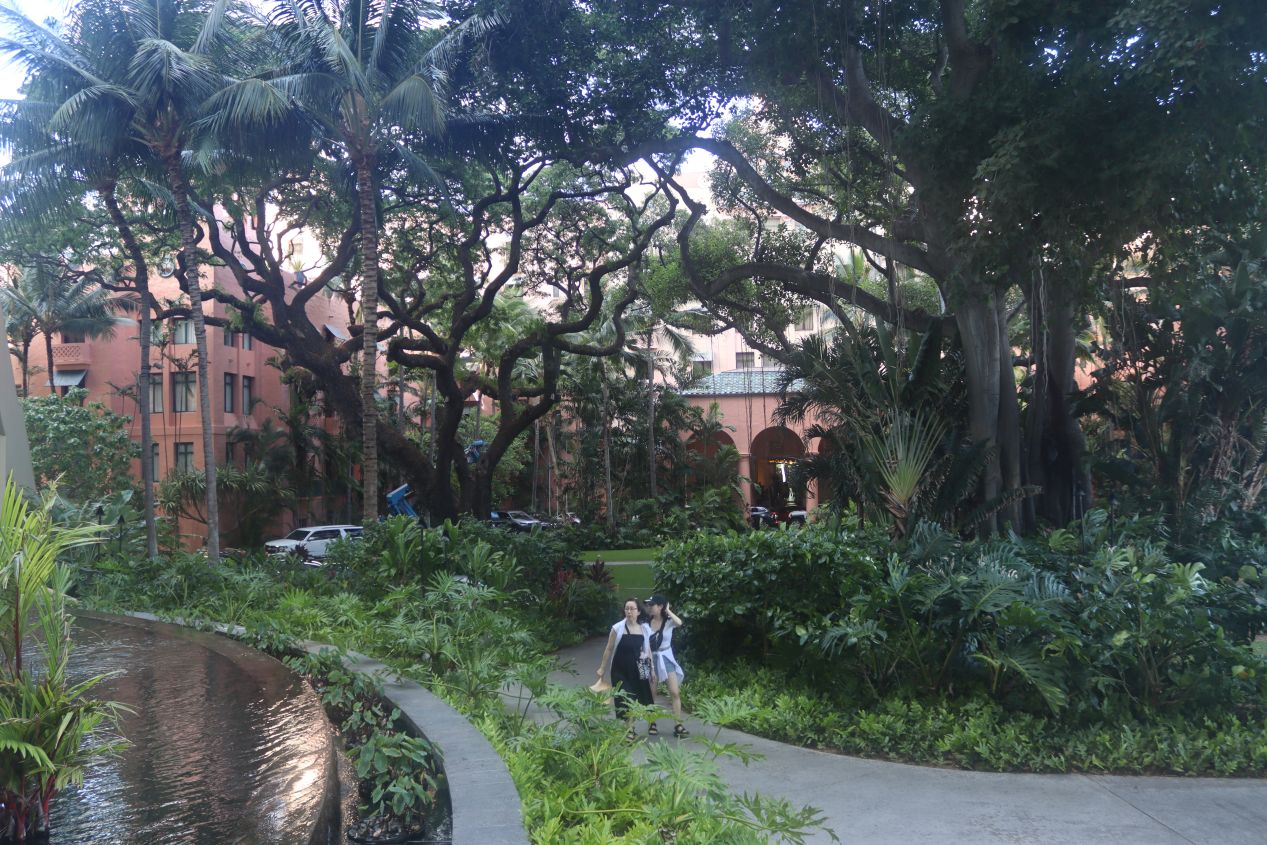
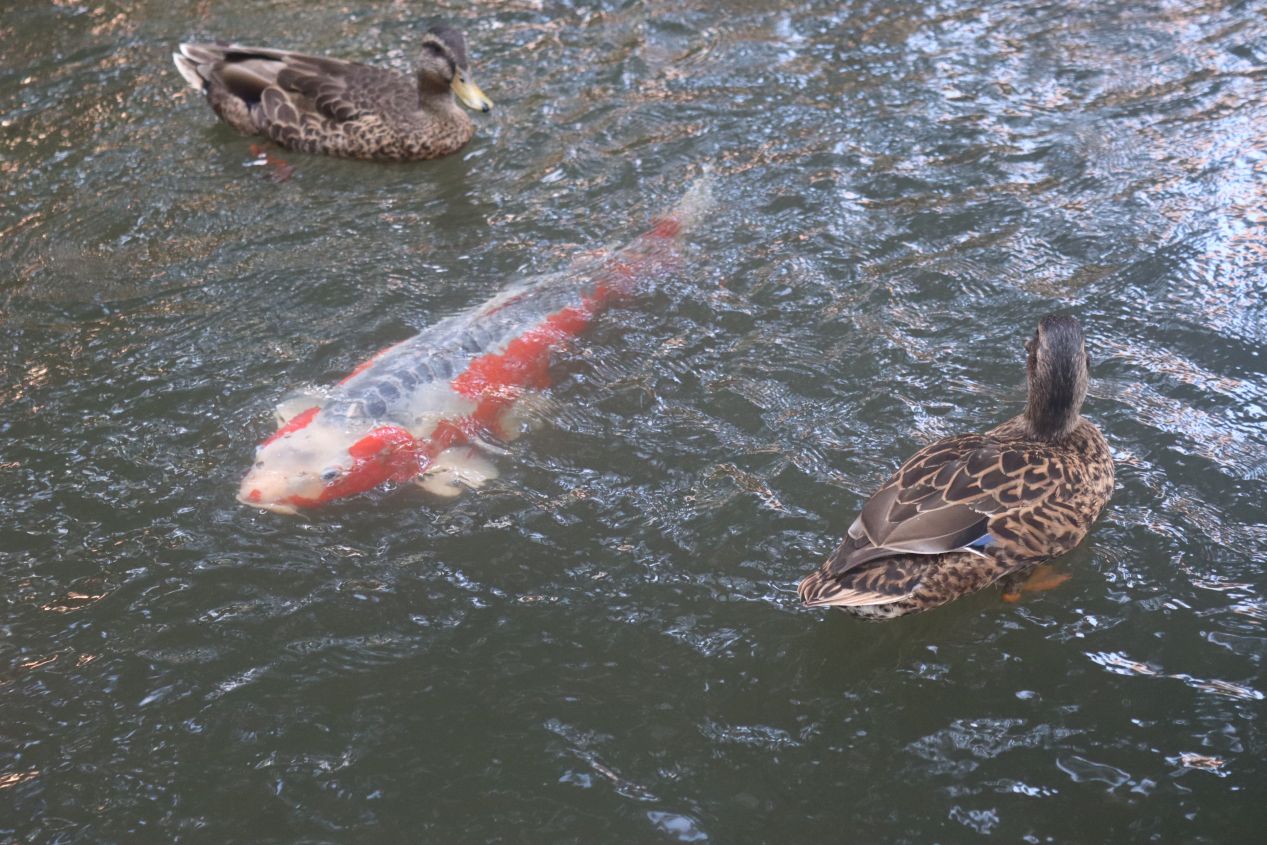
Here are a couple more pictures of the grounds of the Royal Hawaiian Hotel. We had about an hour to kill after we left the beach but before our evening boat ride was set to begin, and we spent that time wandering around the hotel's outdoor areas a bit more. There was a nice pool area that lots of kids were enjoying (even if it didn't make a ton of sense to go to the pool with the ocean literally a stone's throw away). Nearby was a quieter area with a piano playing music and a koi pond with some enormous fish. Several of them were bigger than the ducks paddling by in the water! We were already getting pretty tired and this was a nice break before our next activity.
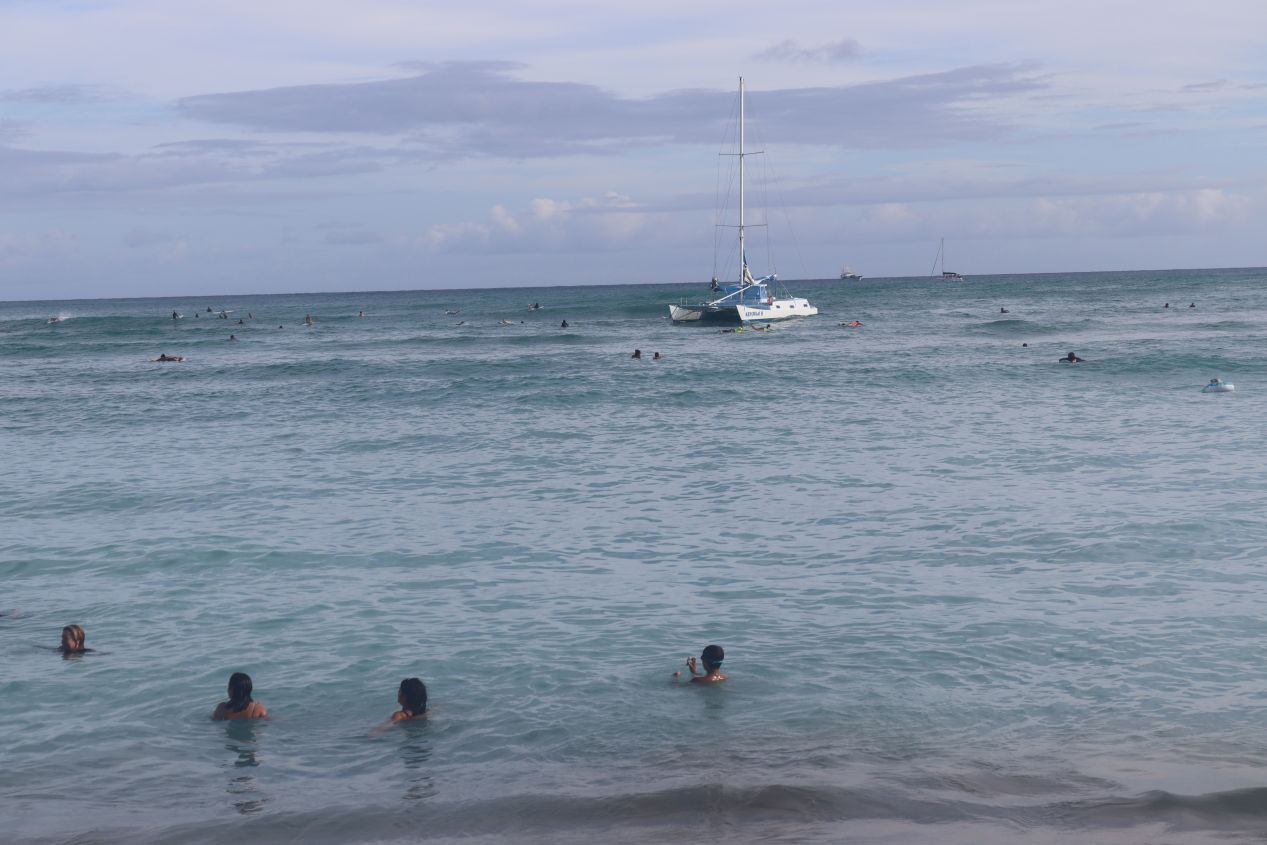
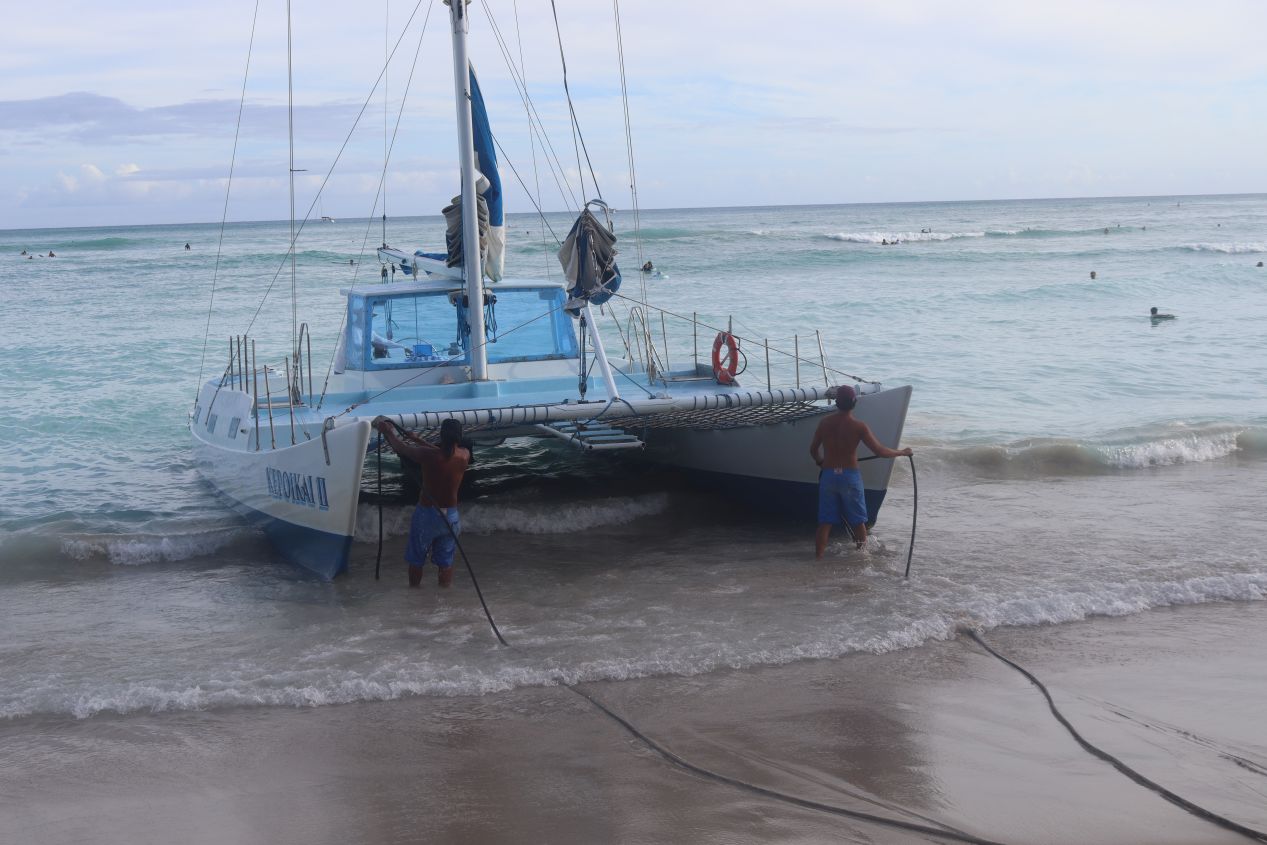
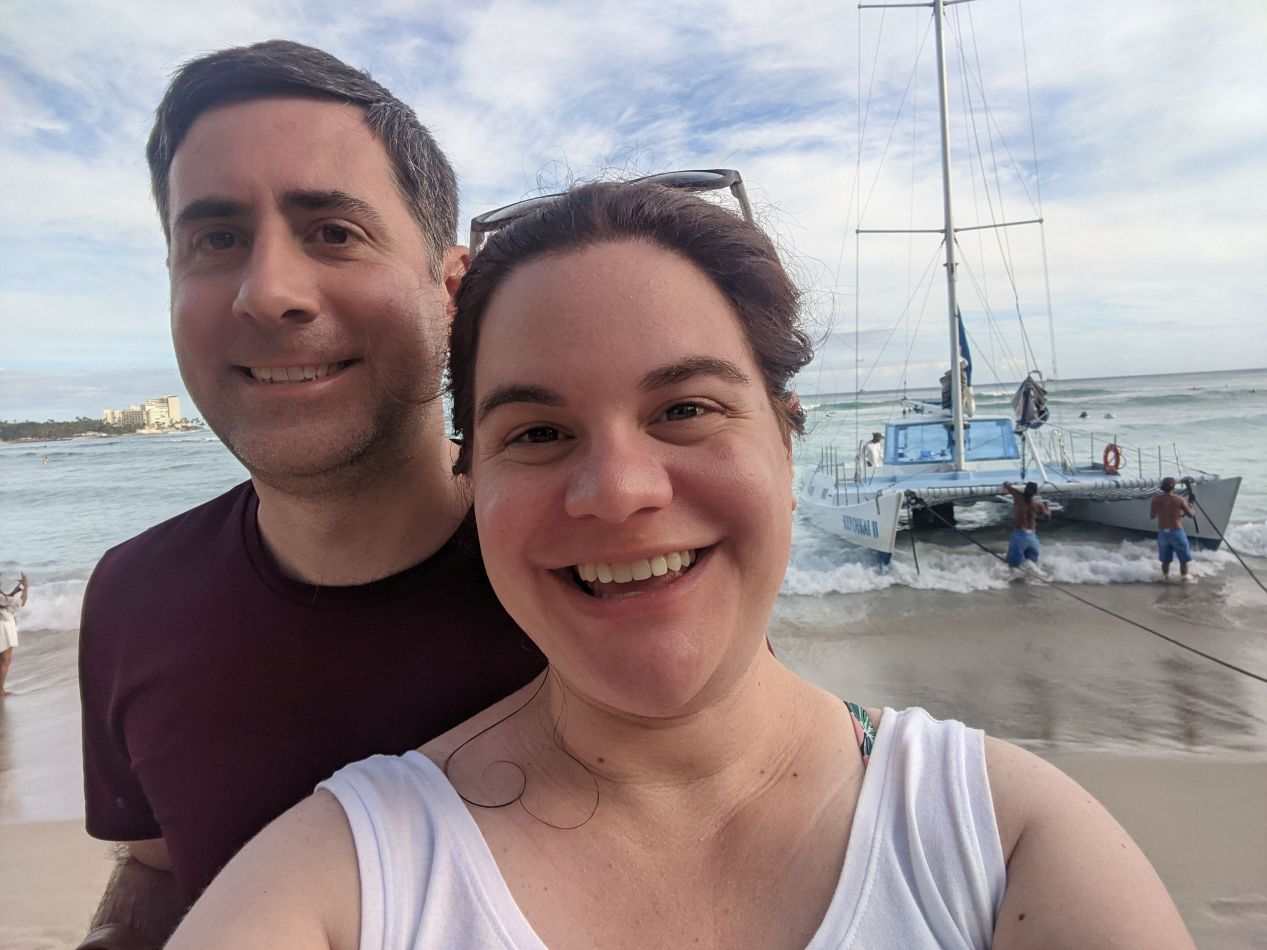
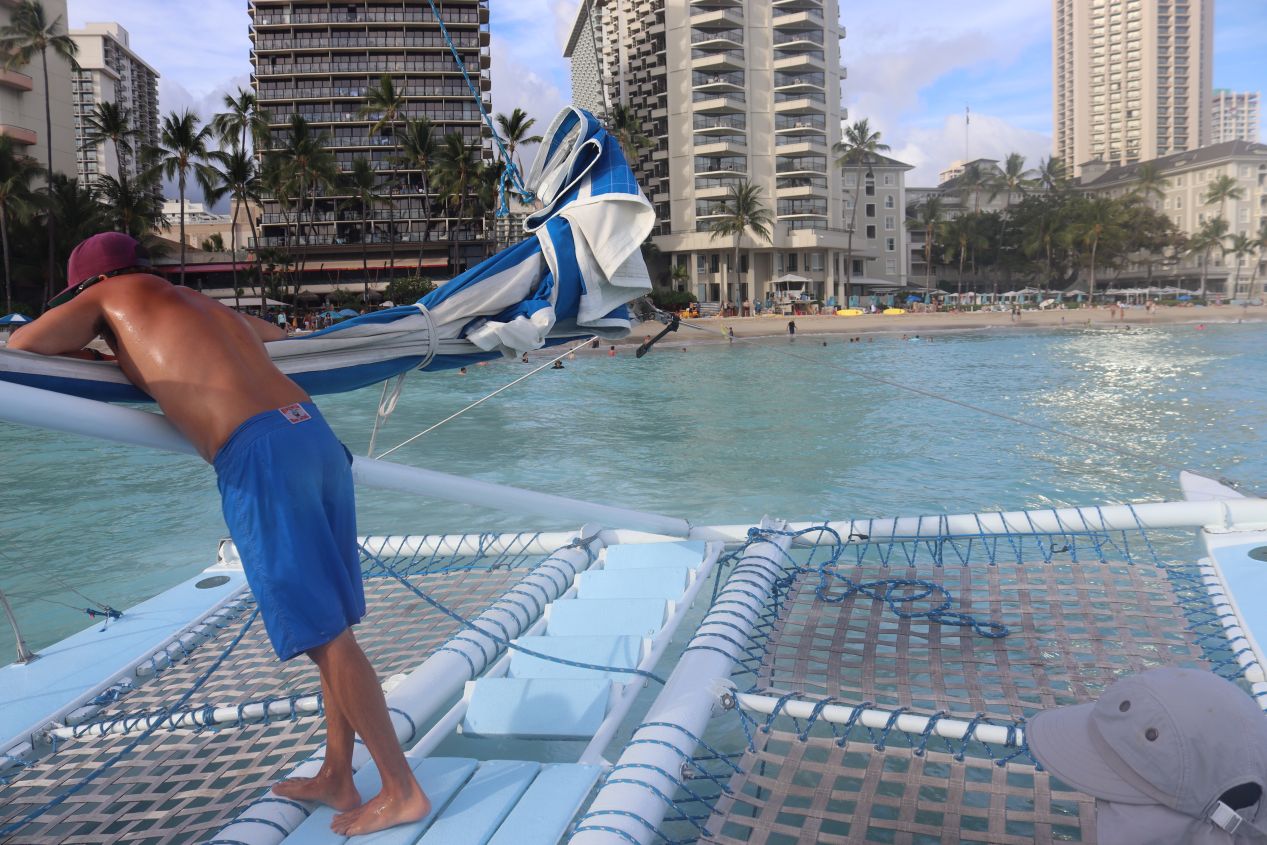
Soon enough it was 5:30 PM and we found ourselves back on the beach near where we had been sitting under our umbrella, watching a catamaran boat out in the distance begin approaching the shore. We were a bit confused about how we were going to be boarding this boat for our evening cruise only to find that it pulled right up onto the beach, scattering the swimmers who were still out in the water as it drew near the shore. Liz and I posed for a quick picture with the boat in the background and then joined the line of other passengers to climb aboard. We had to wade into the surf and scramble up a small ladder while the boat was still rocking up and down in the waves; it was one of the tougher entries onto a boat that I've done and several of the tourists fell down in the surf as they tried to climb on. At least we managed to get aboard without getting soaked. The small crew immediately began pushing back out to deeper waters to get out of the way of the swimmers and we were off on our evening adventure.
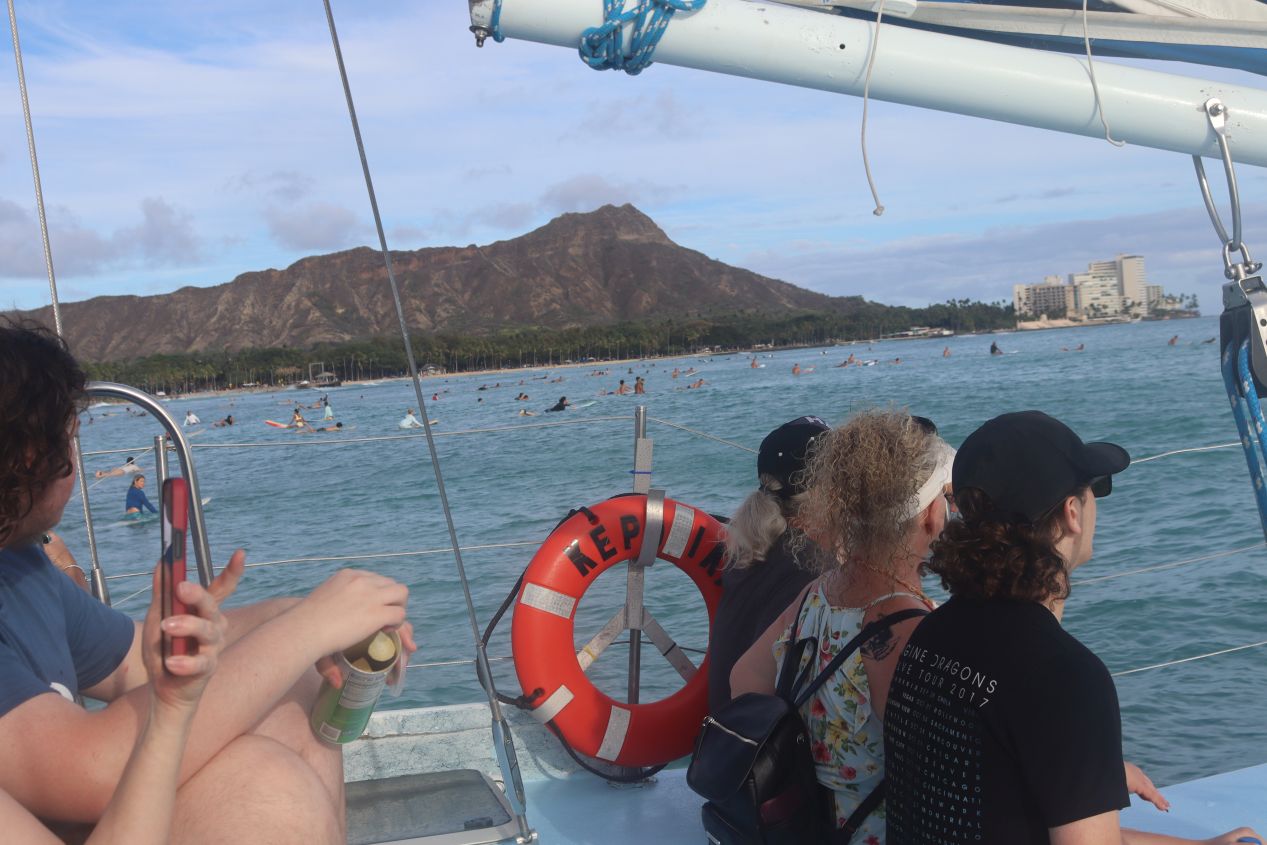
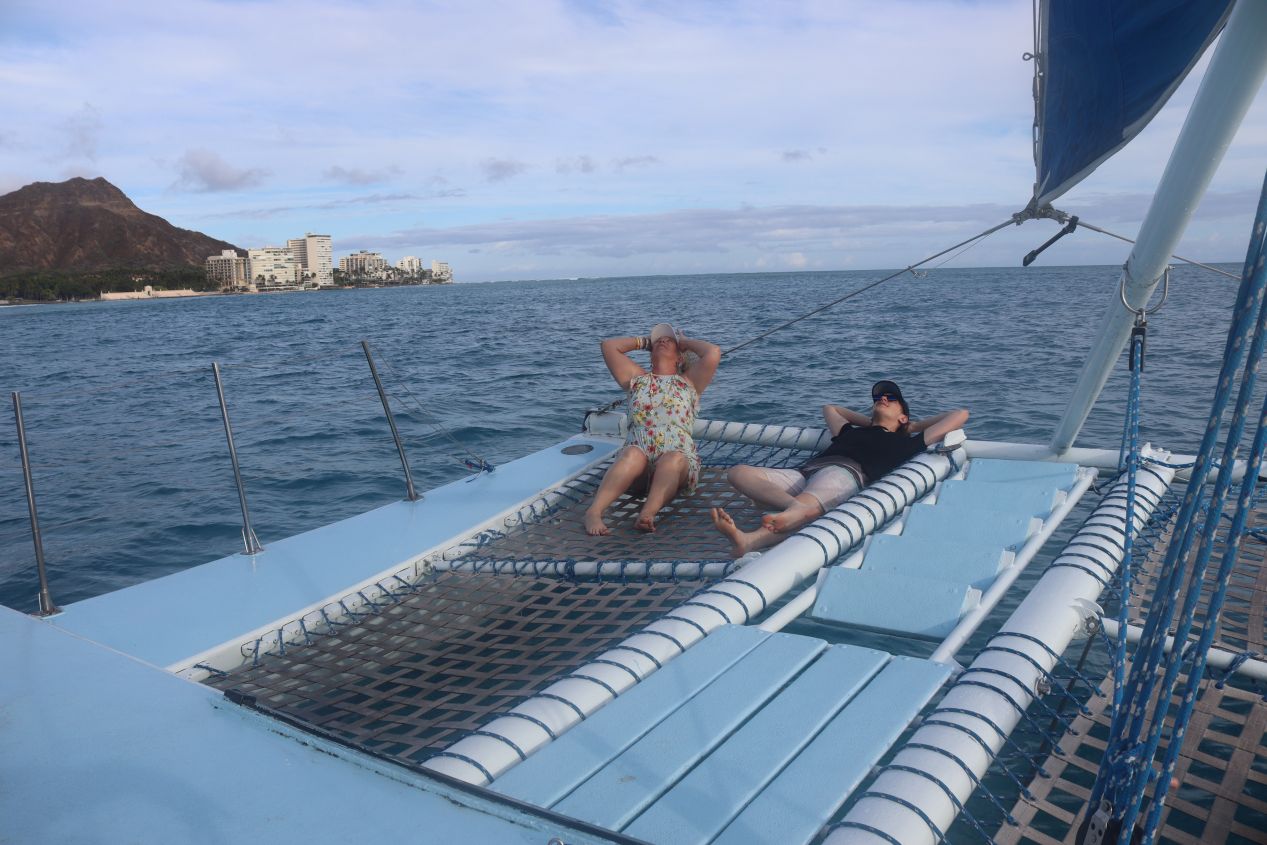
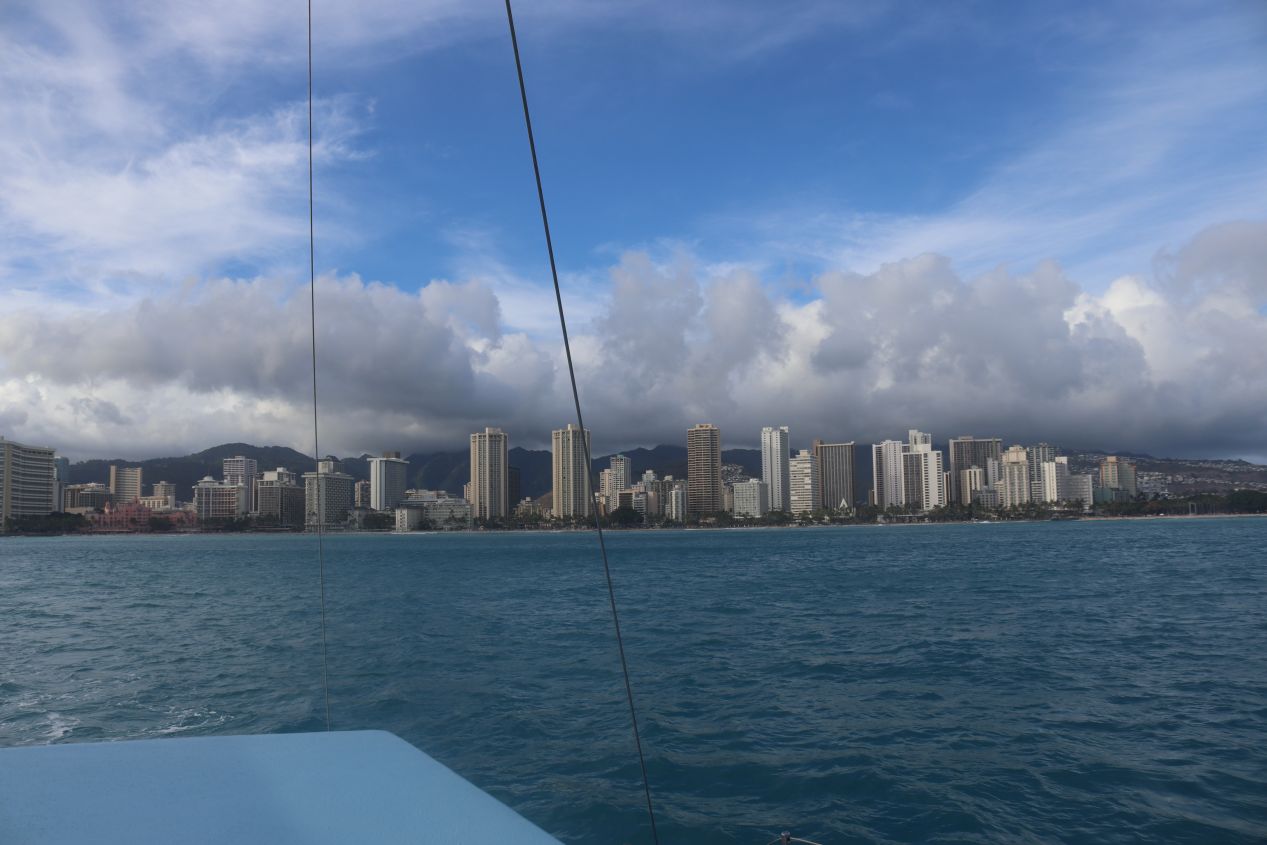
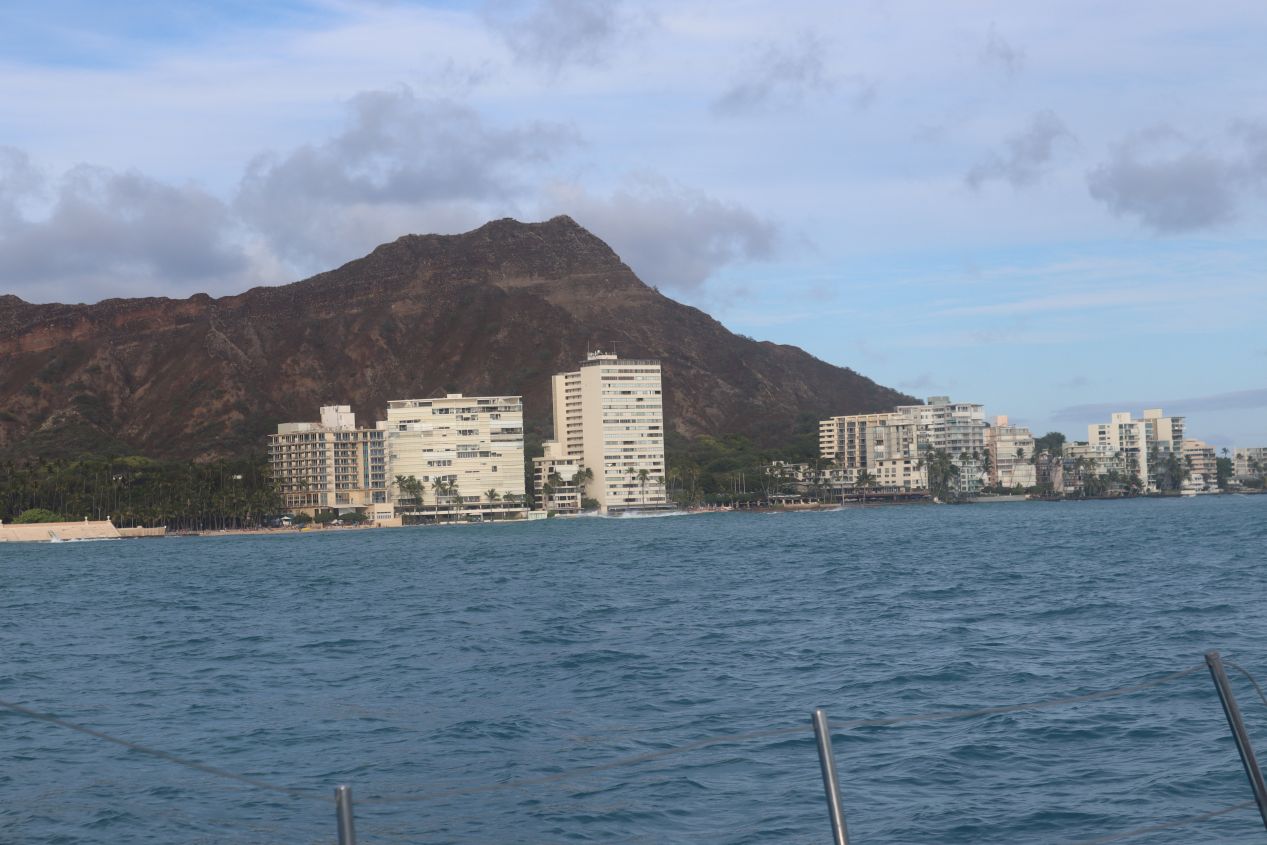
Once we were past the swimmers along the shoreline, we had to pass through another group of people out where the waves were breaking, occupied by dozens and dozens of surfers. It was almost like navigating a traffic jam during rush hour since there were so many people in and around Waikiki Beach. Then the catamaran was out in open waters where we had the ocean more or less to ourselves, only a handful of other small pleasure craft following along in the distance. The crew began selling alcoholic drinks which we skipped since the combination of drinking and seasickness felt like a really bad mix. The ocean was calm on this evening but the catamaran still bobbed up and down as it glided over the waves. Some of the other passengers went out to sit on the cargo nets on the bow of the boat, which looked like fun right up until water spashed up from below and left them soaked. Even though we were still wearing our bathing suits that was something that we were content to pass on.
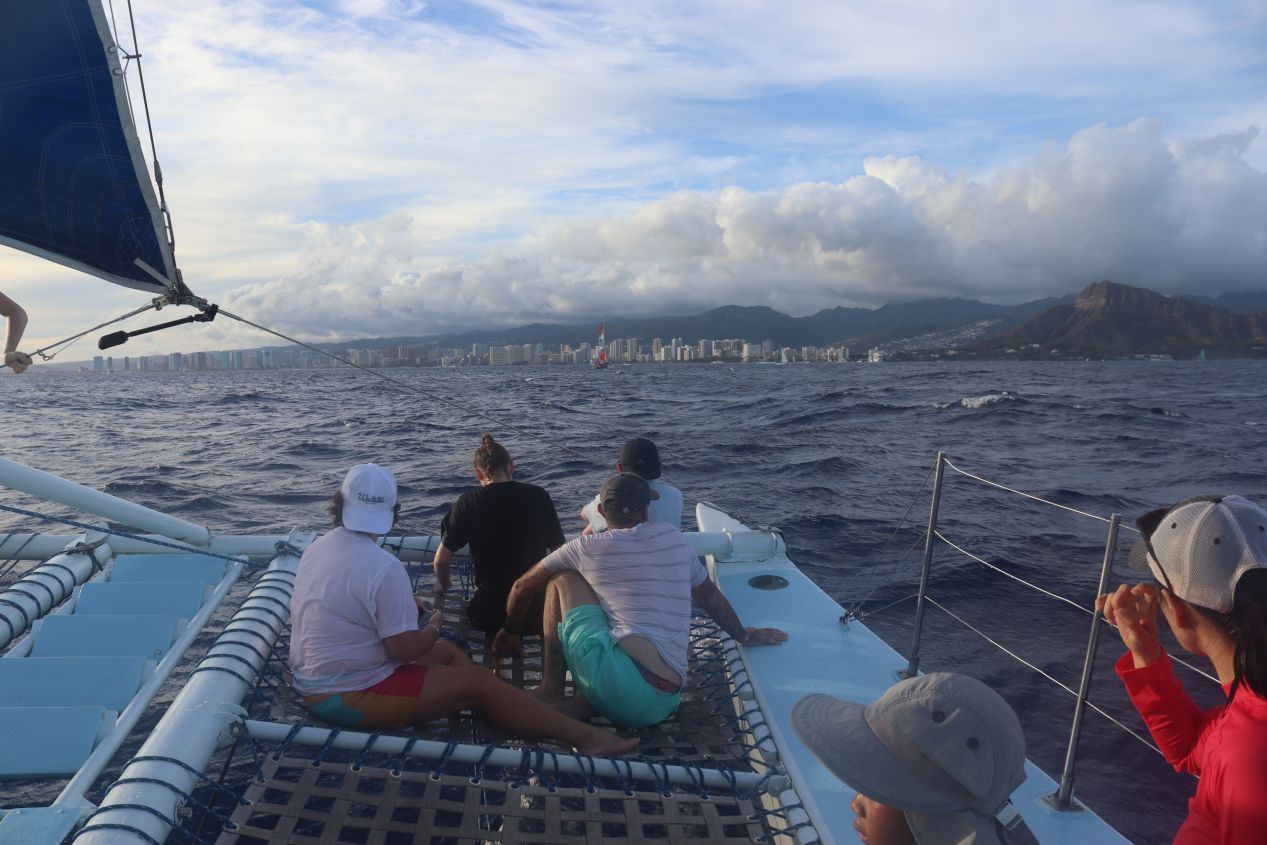
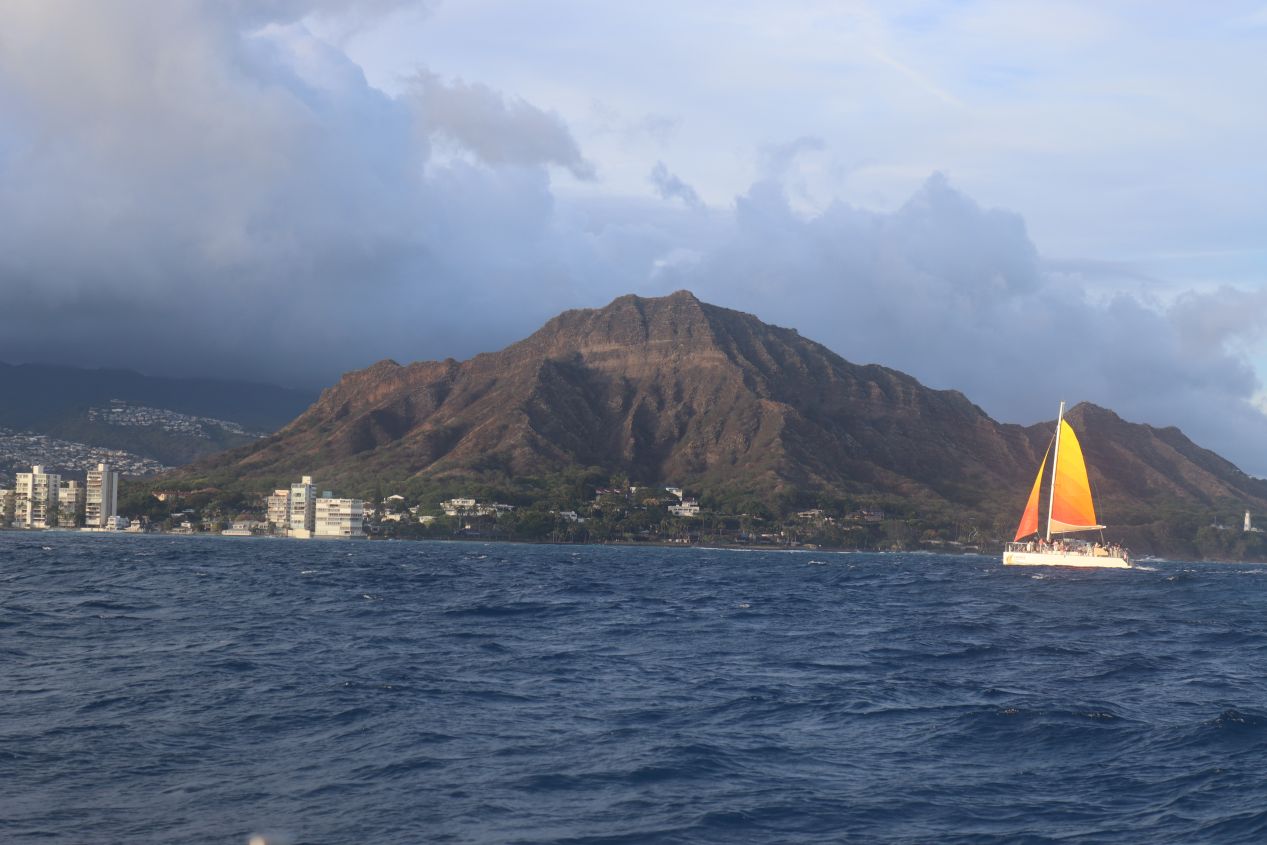
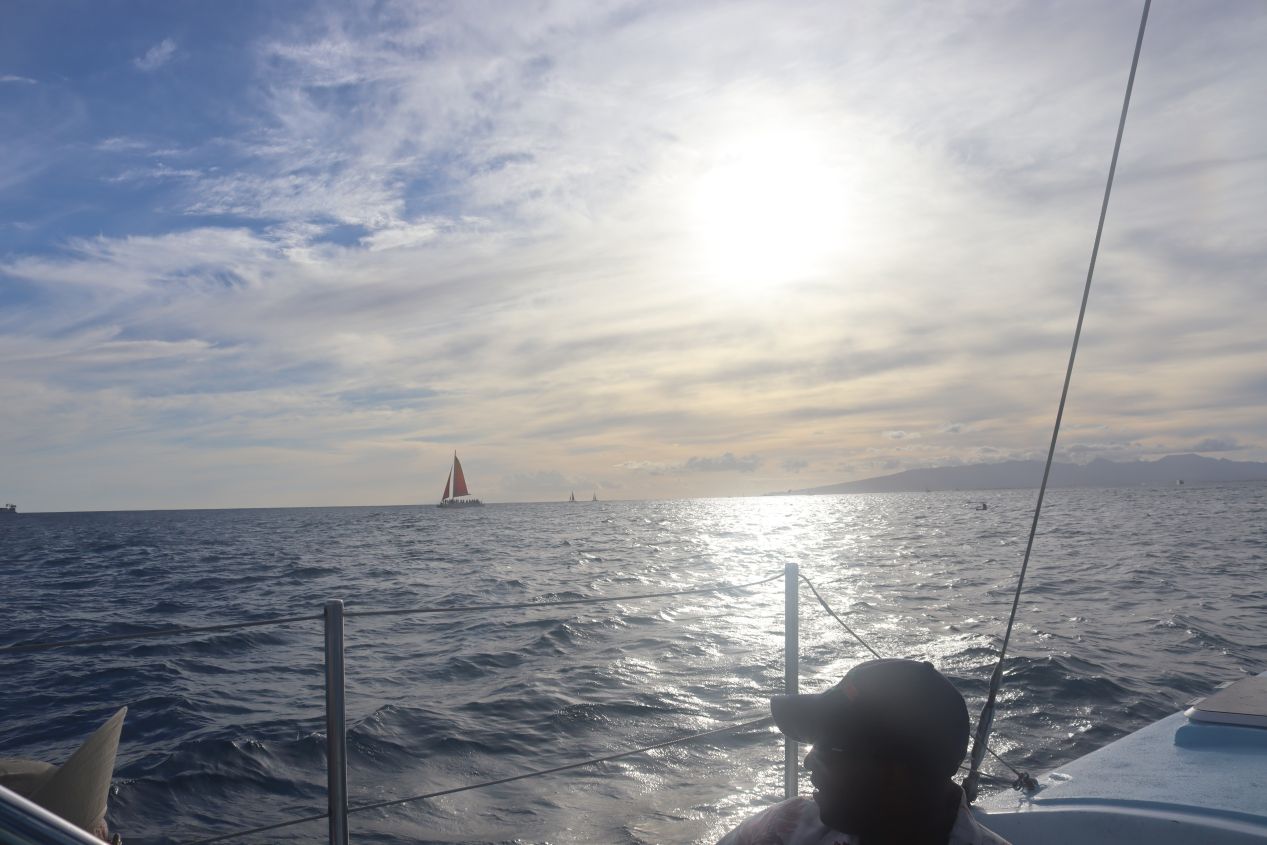
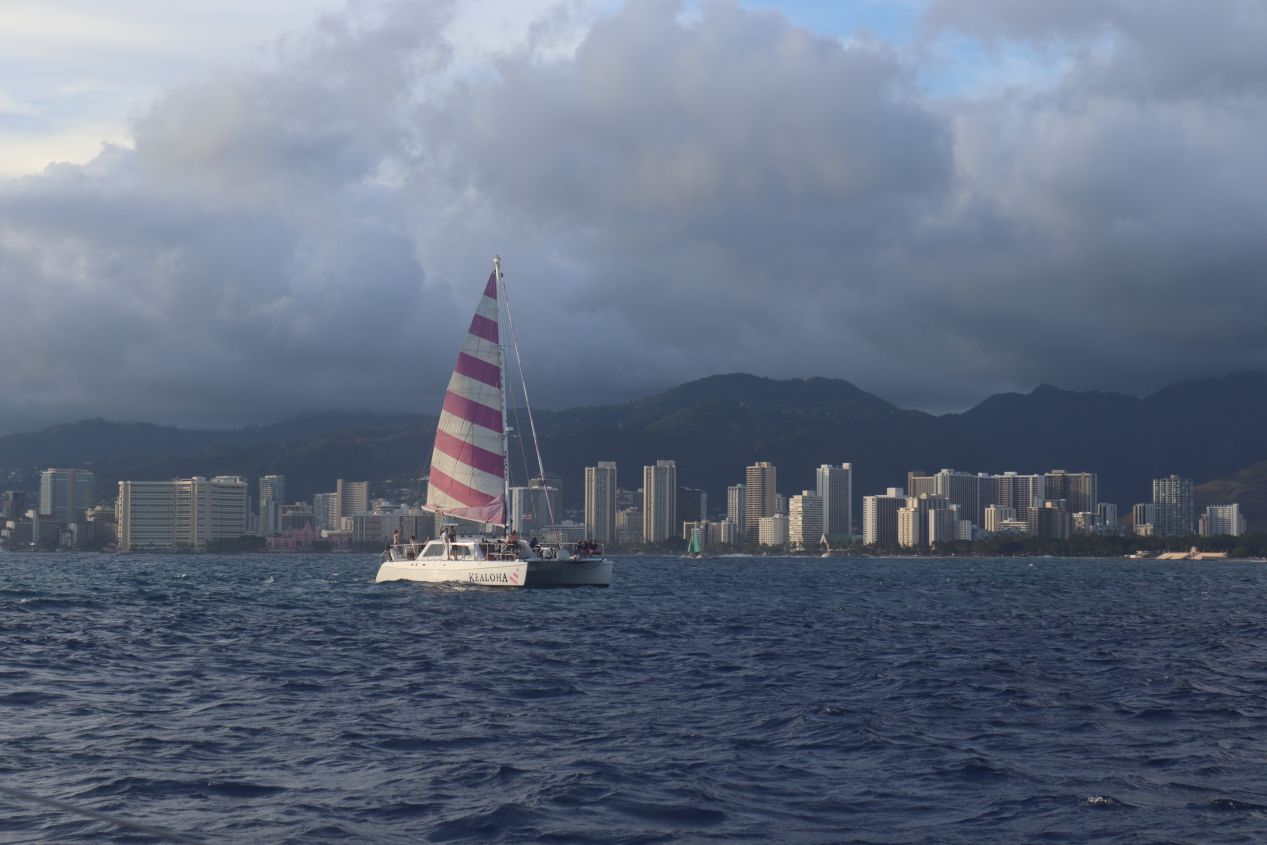
The catamaran took us a couple of miles out into Waikiki Bay where we were treated to these magnificent views of the shoreline. The high rise hotels spread out in a crescent shape following the curve of the shoreline only to be overlooked by the rearing shape of Diamond Head off to southeast. Once again, it was a little hard to believe that I had been up at the top of the crater earlier that morning, now about 12 hours prior to this sunset cruise. The sun was falling down towards the horizon and leaving everything illuminated in shades of orange and yellow, making for a perfect evening viewing experience. The only real issue is that the trip lasted a little bit too long for my liking, close to two hours at a time when Liz and I were both starting to get extremely hungry. The movement of the boat was also pretty choppy at times so travelers who have issues with seasickness should beware. At least the cost was very reasonable (I think about $50 per person) so this is something that didn't break the bank to enjoy.
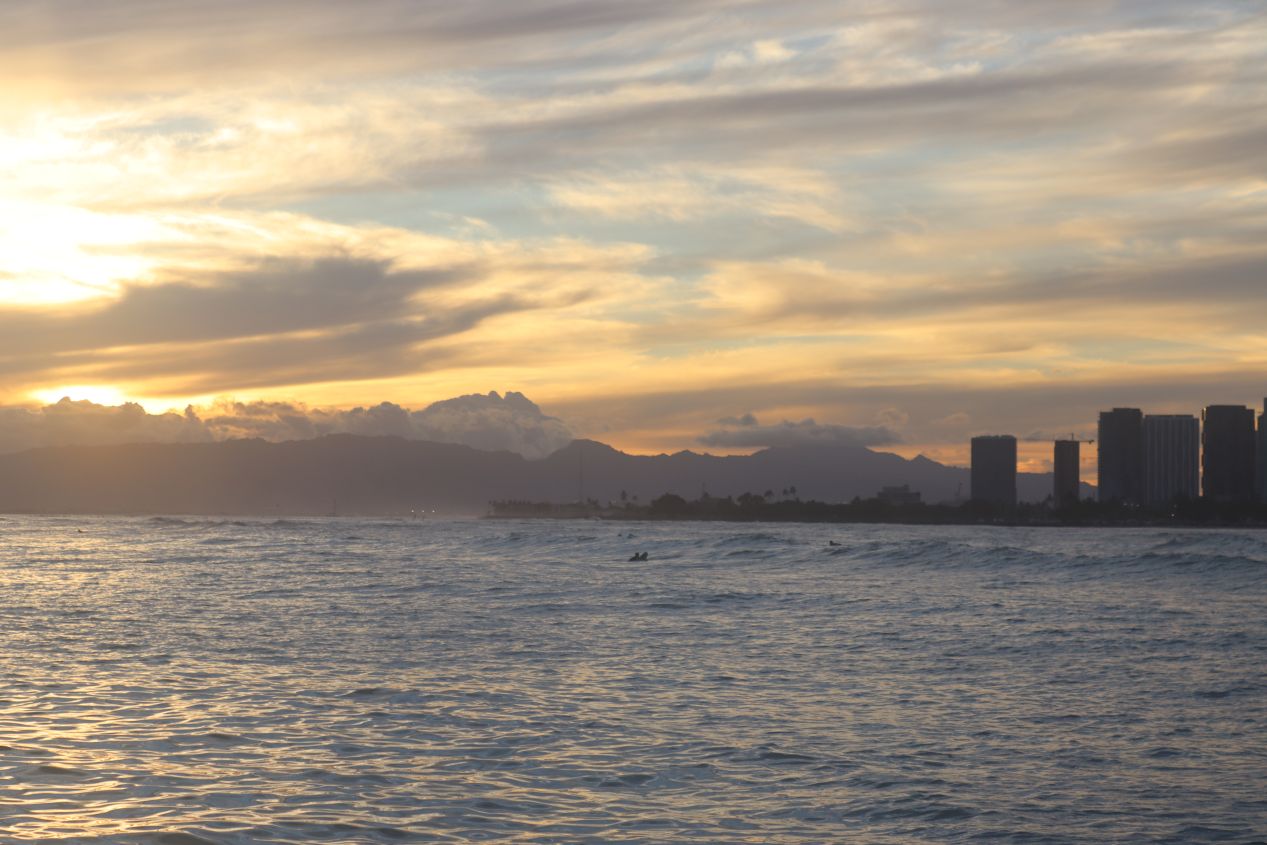
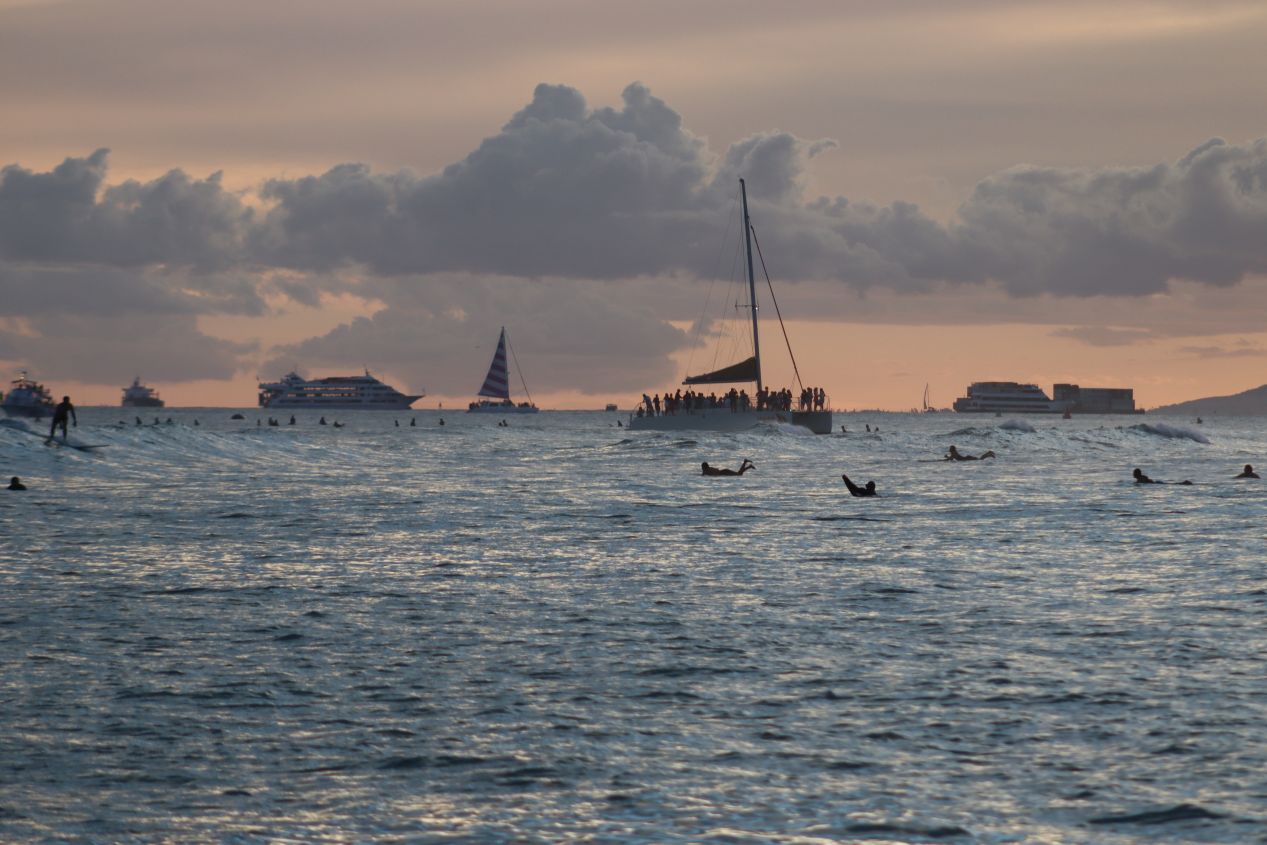
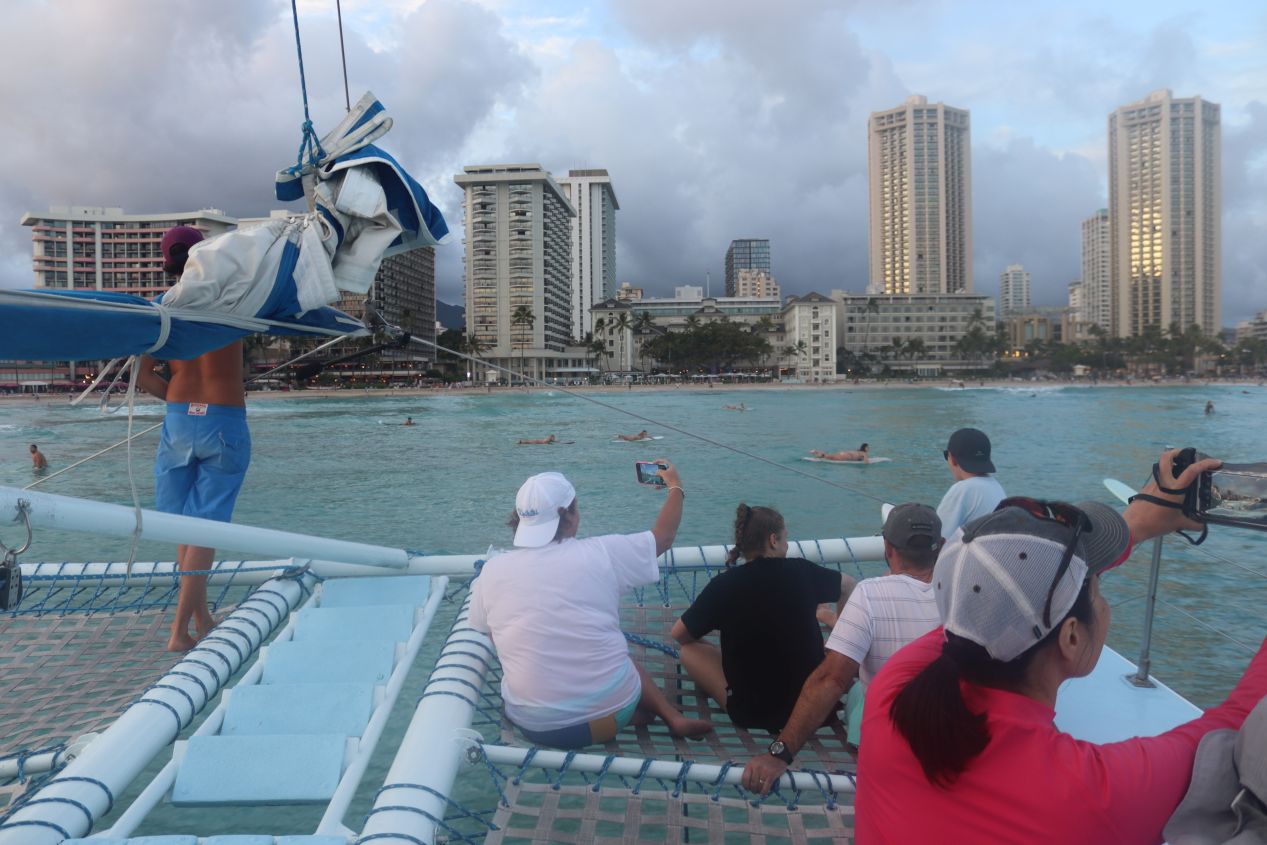
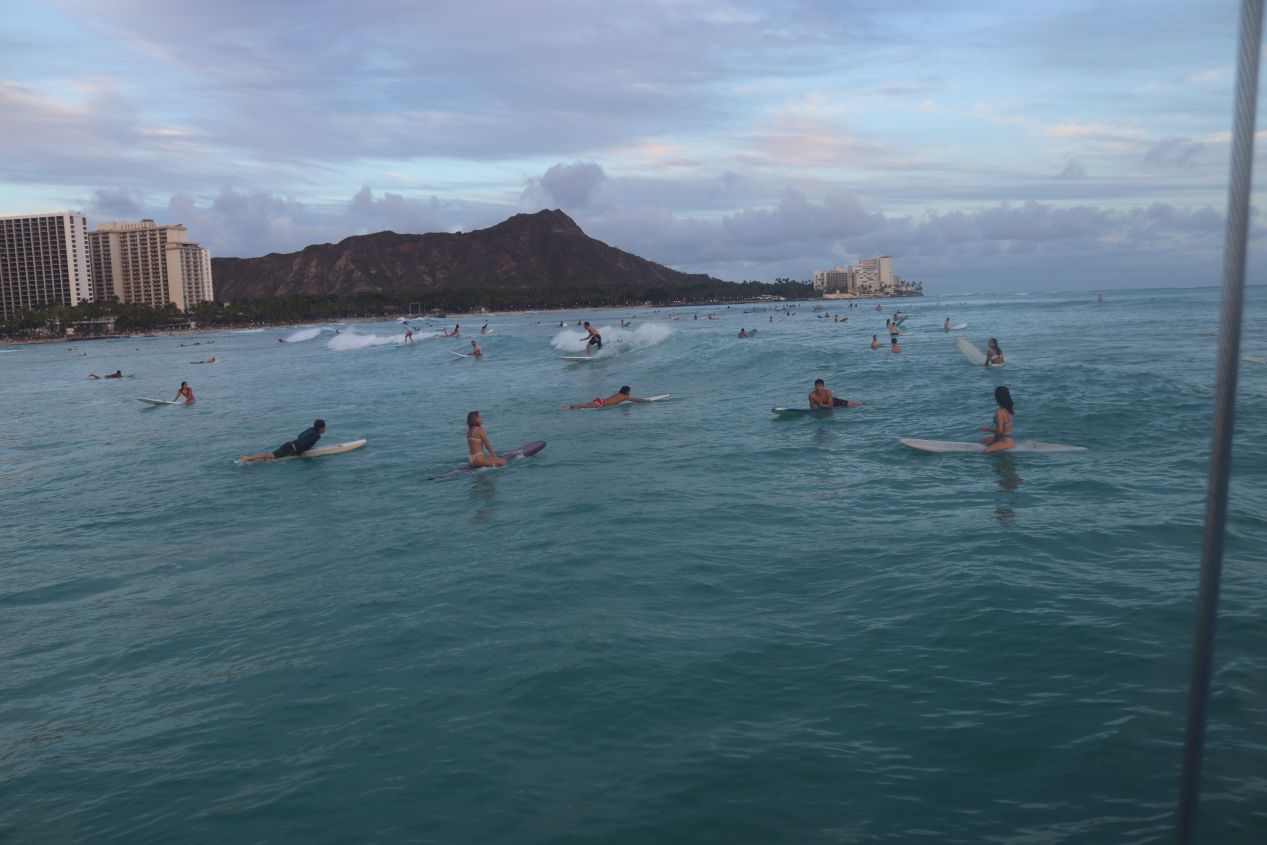
The sun had dropped below the horizon and it was starting to get dark by the time that our catamaran returned to the shore again. The surfers were still out in droves and we had to navigate our way through their crowds a second time. How late do they stay out at night? At some point it has to get too dark to see and starts becoming too dangerous to continue. We braved the waves along the beach again to make it back onto dry land and started the walk back to our hotel. First though we were ravenously hungry and needed to find somewhere to eat:
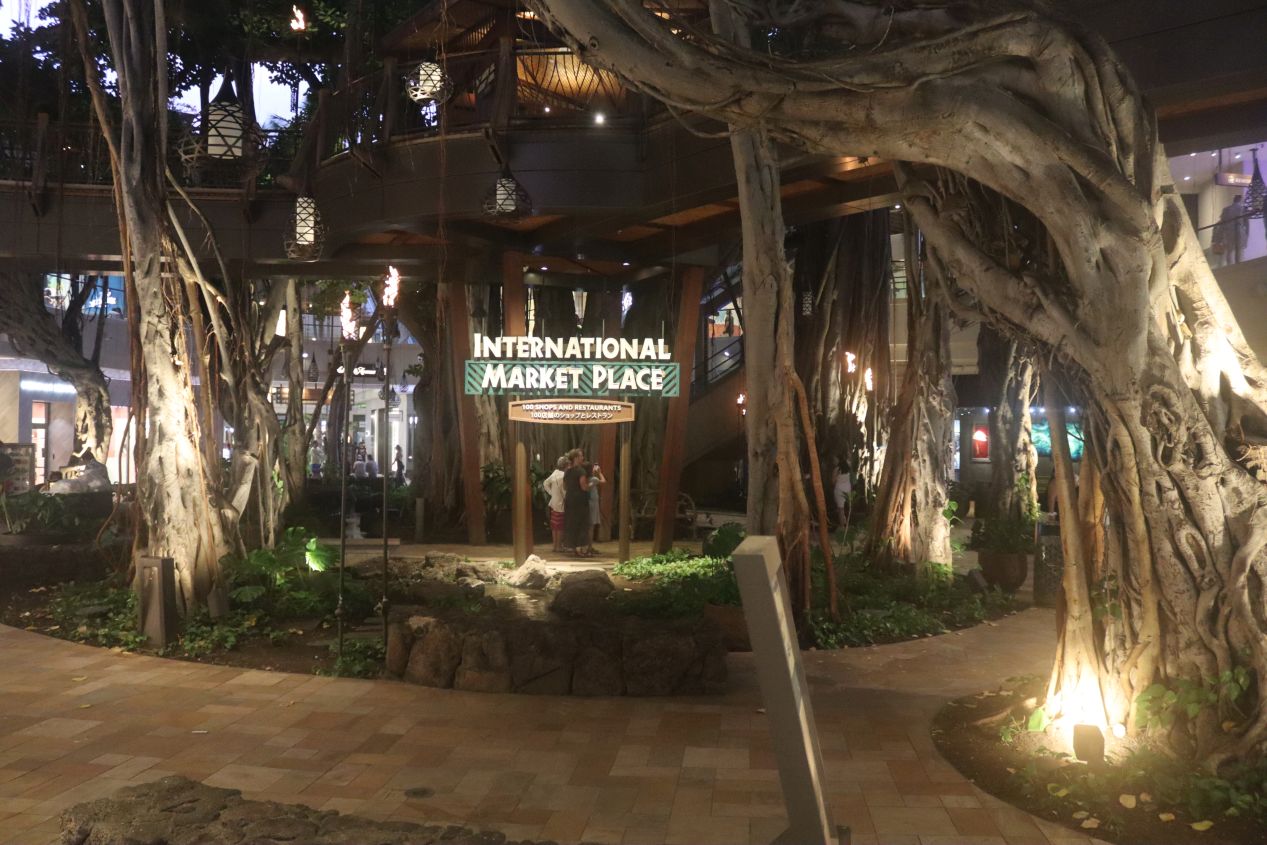
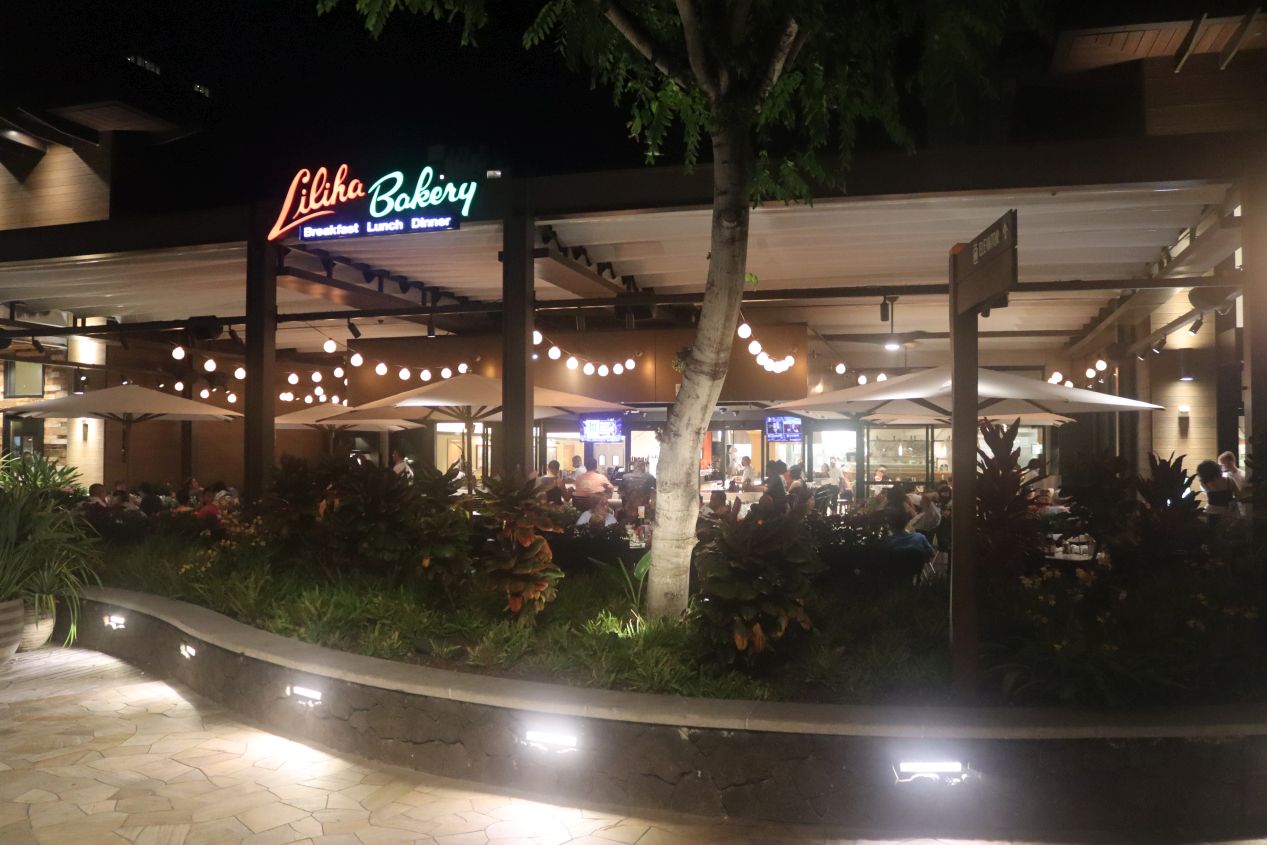
We ended up at another mall in the beachfront area named International Marketplace. It was located on the opposite side of Kalakaua Avenue slightly further away from the beach and stood out for having five floors of shops and restaurants. We checked out a number of the food options along the way before deciding on the outdoor eating area at Liliha Bakery up on the rooftop level. Despite the name, this was a full restaurant where we were able to get a hearty dinner such as this mushroom chicken dish that Liz ordered which came with rice, corn, and a salad. (I had the karaage chicken which was also quite delicious.) All in all, it was a nice meal to finish up this busy day which had left both of us exhausted despite never leaving the Waikiki area. We'd be heading over to Honolulu's city center the next day for plenty more sightseeing before renting a car and heading further afield on Oahu afterwards. More on all of that continuing on the next page!



